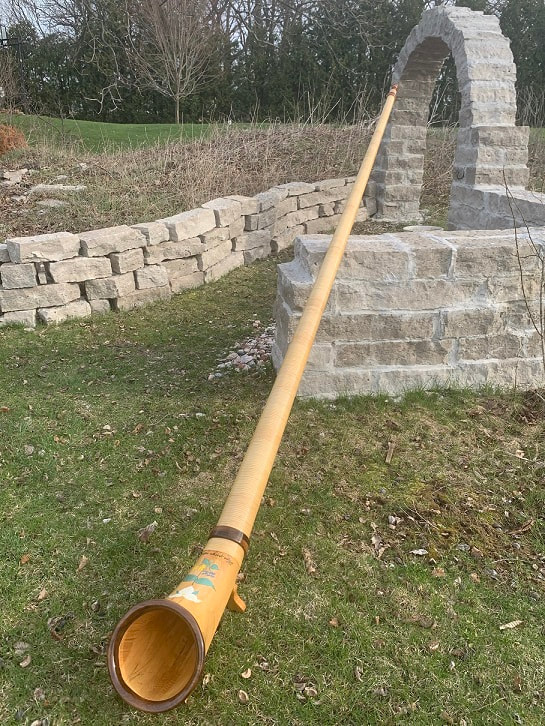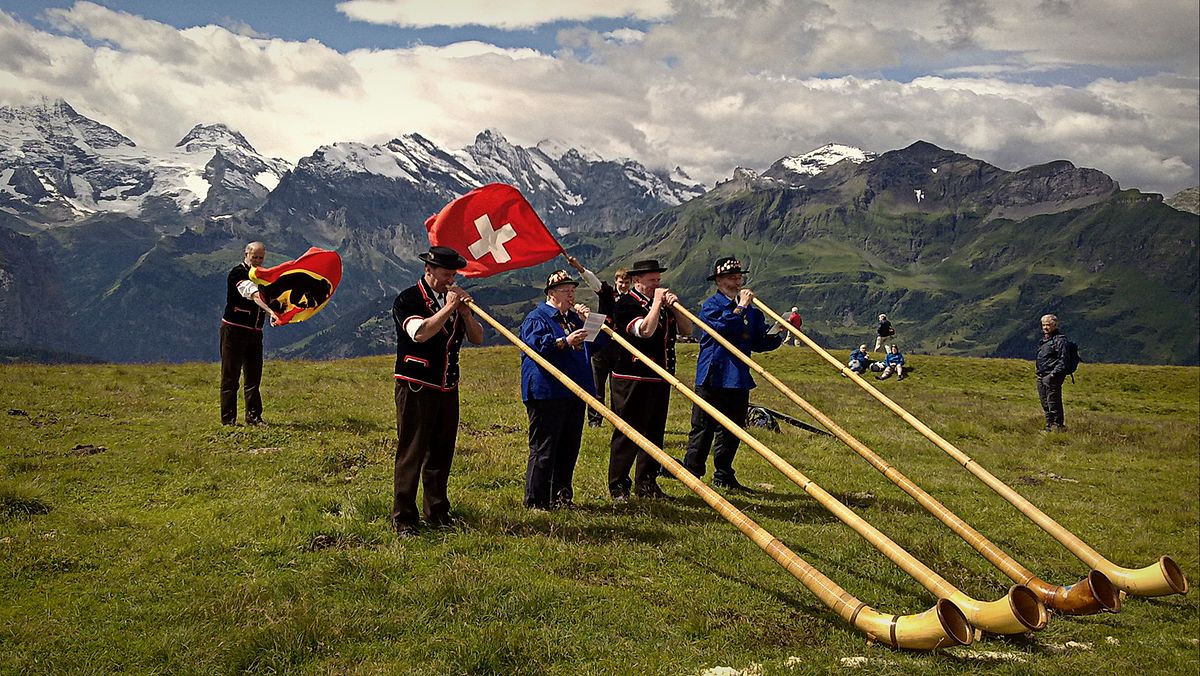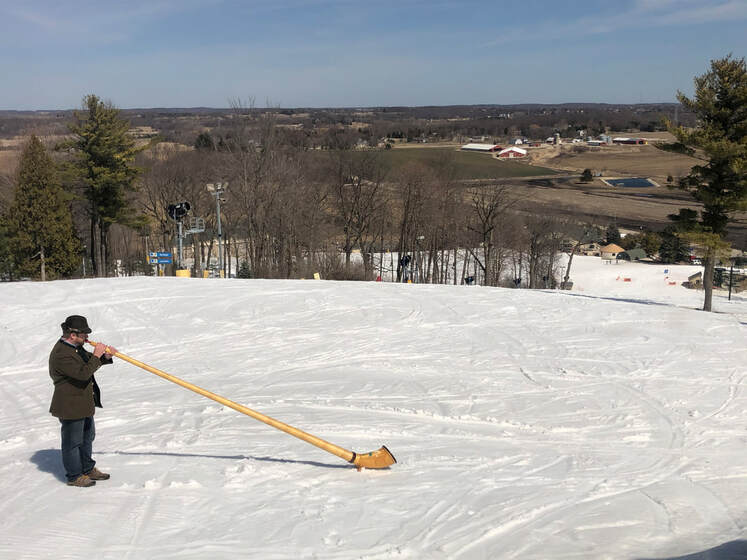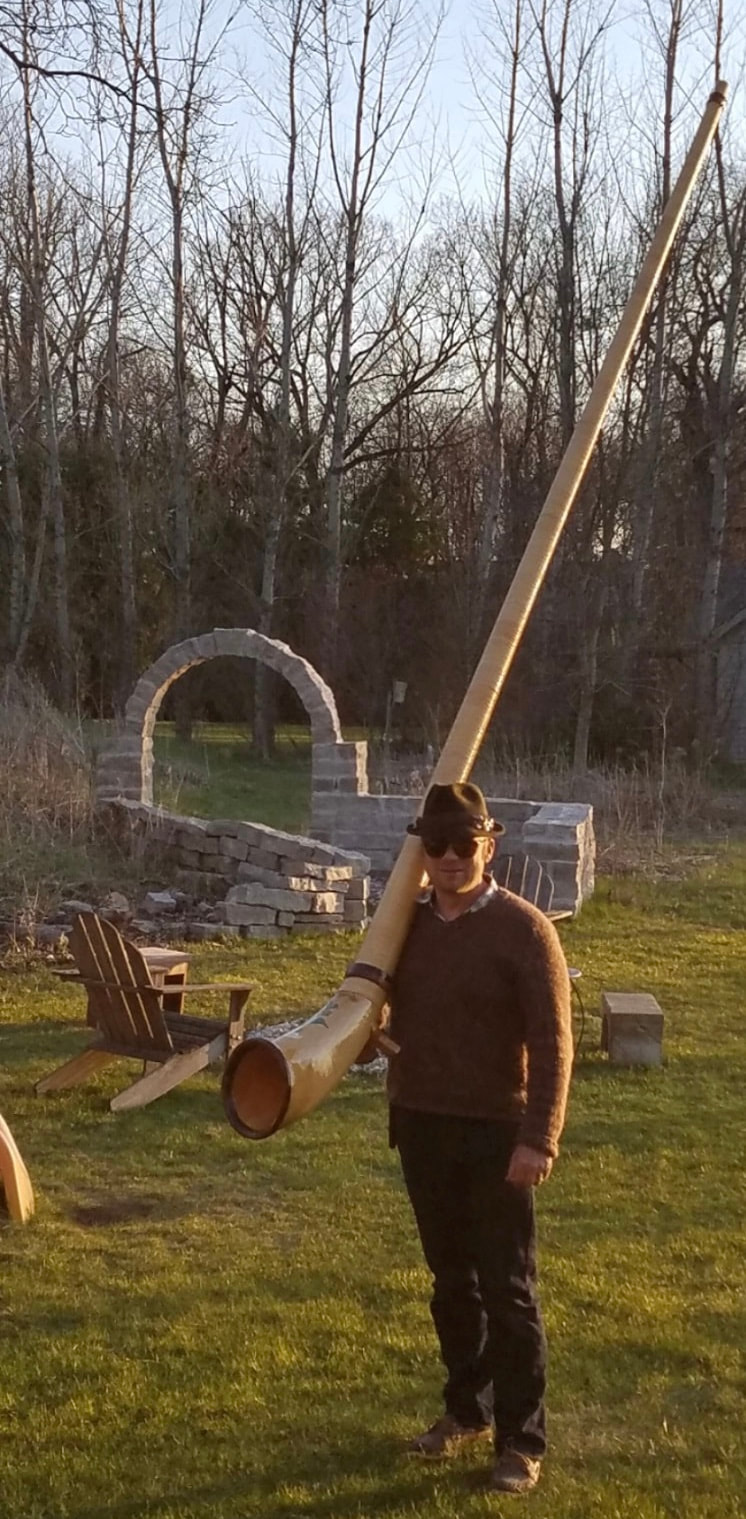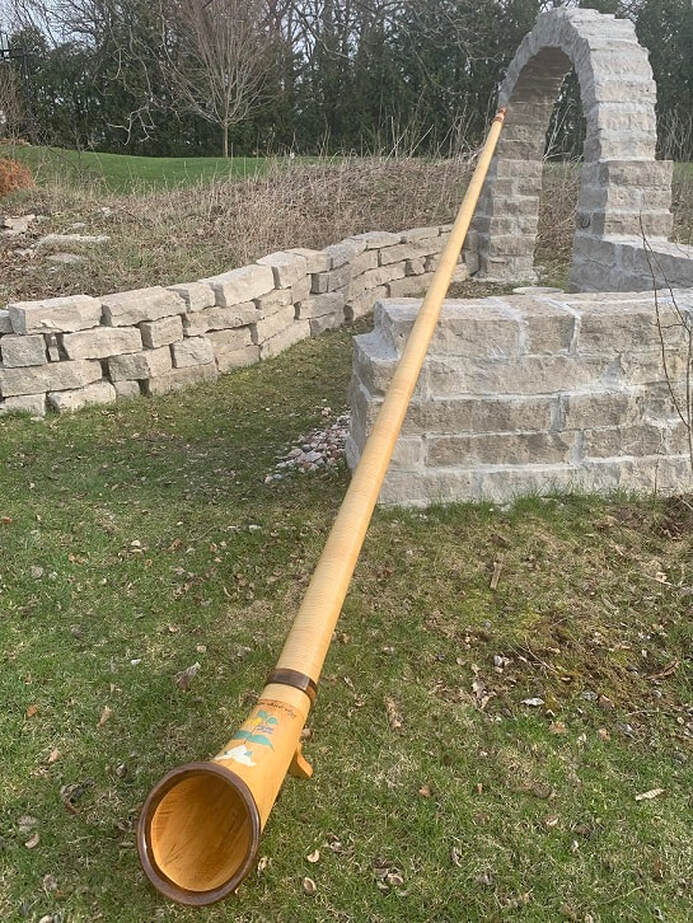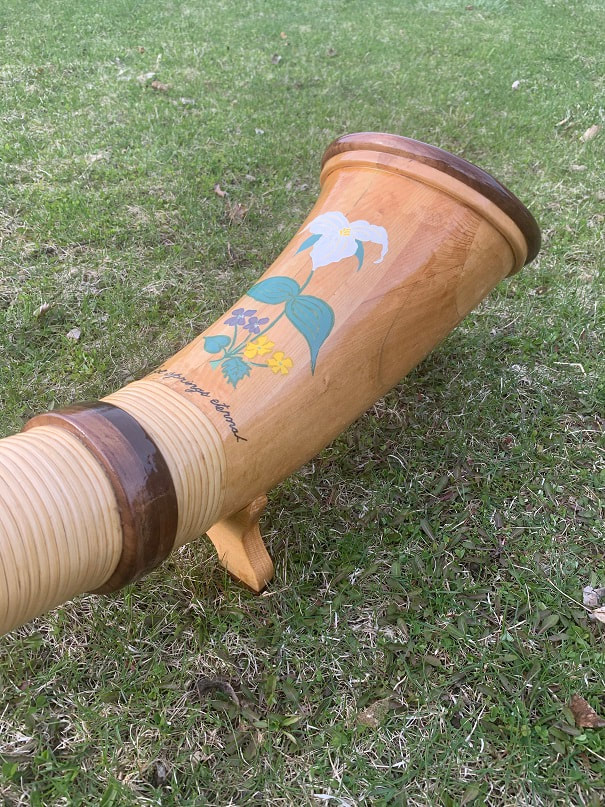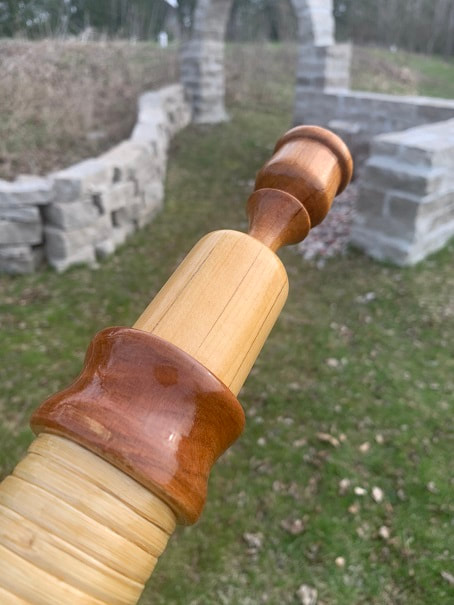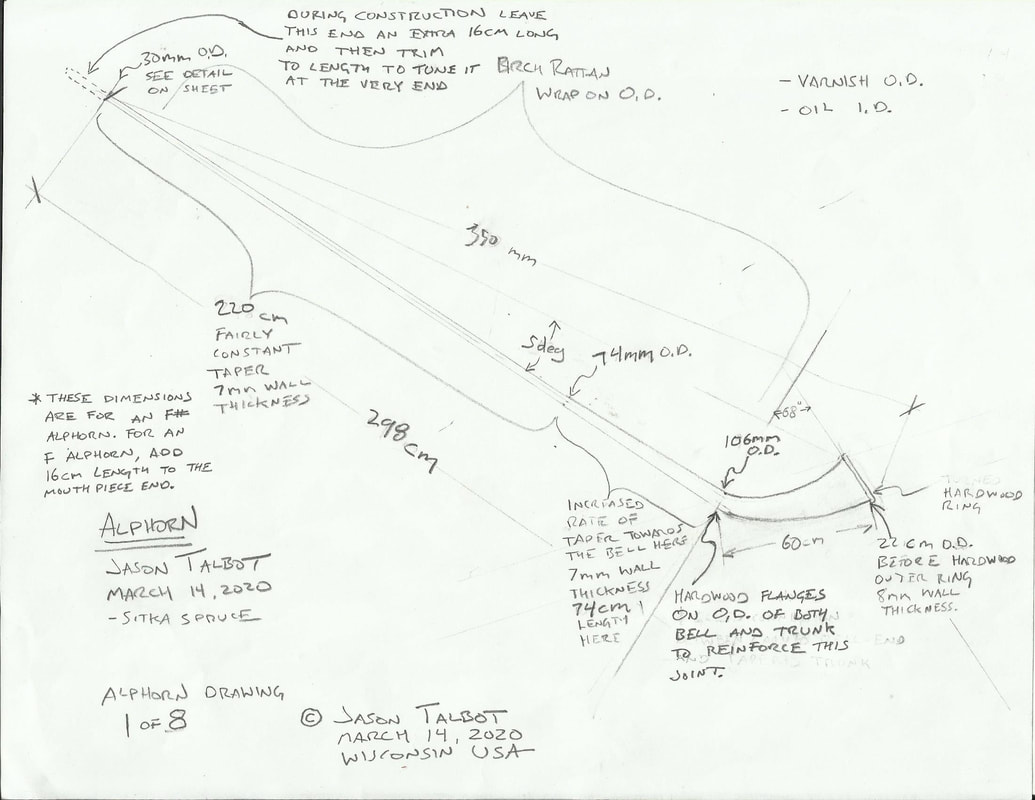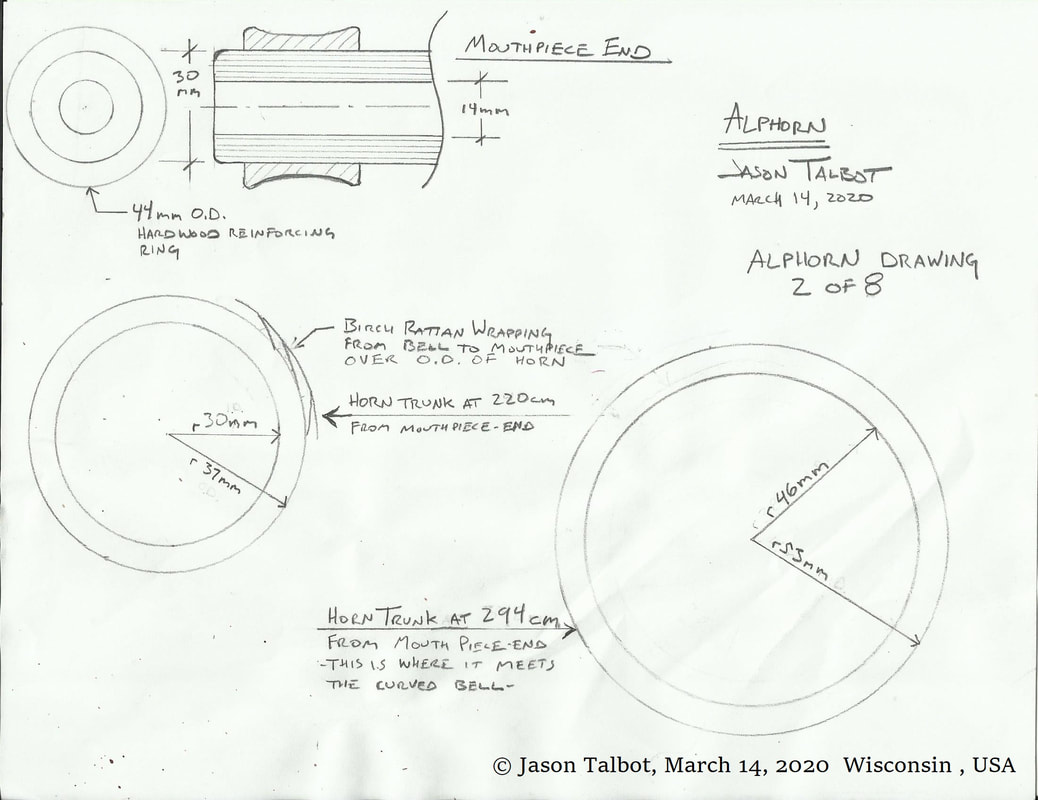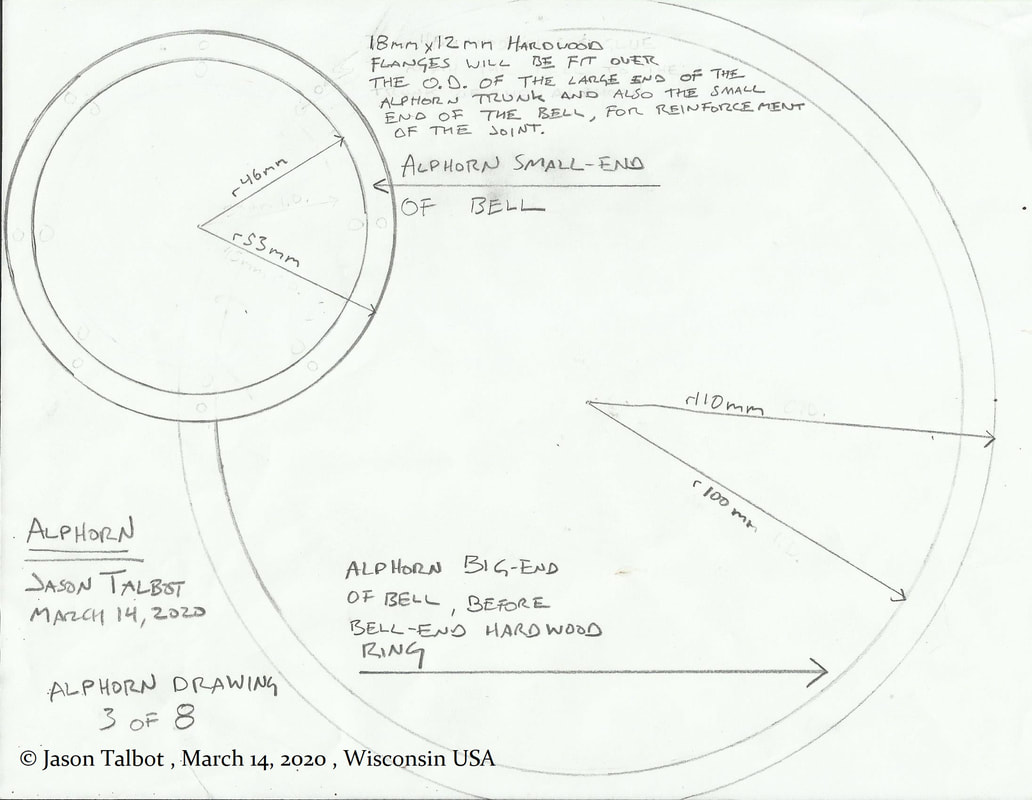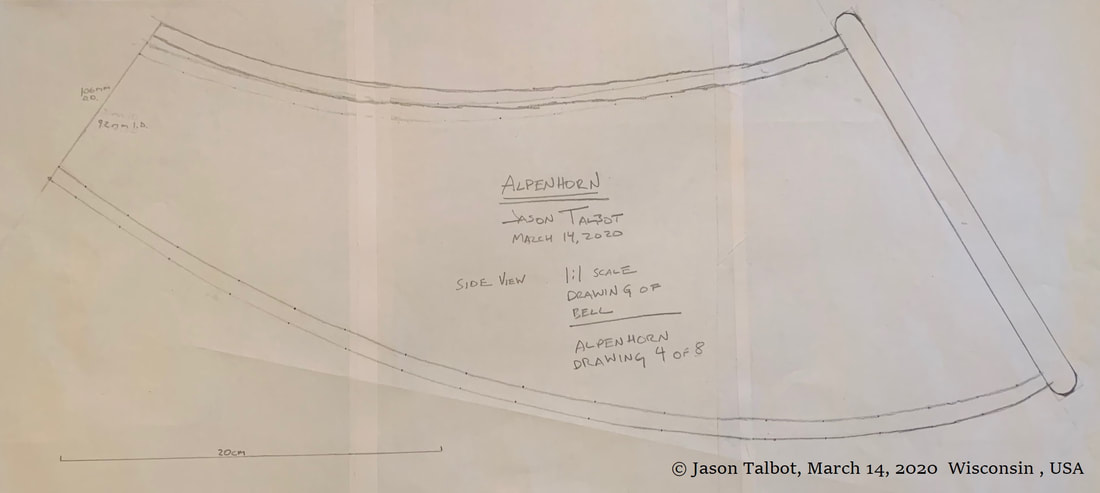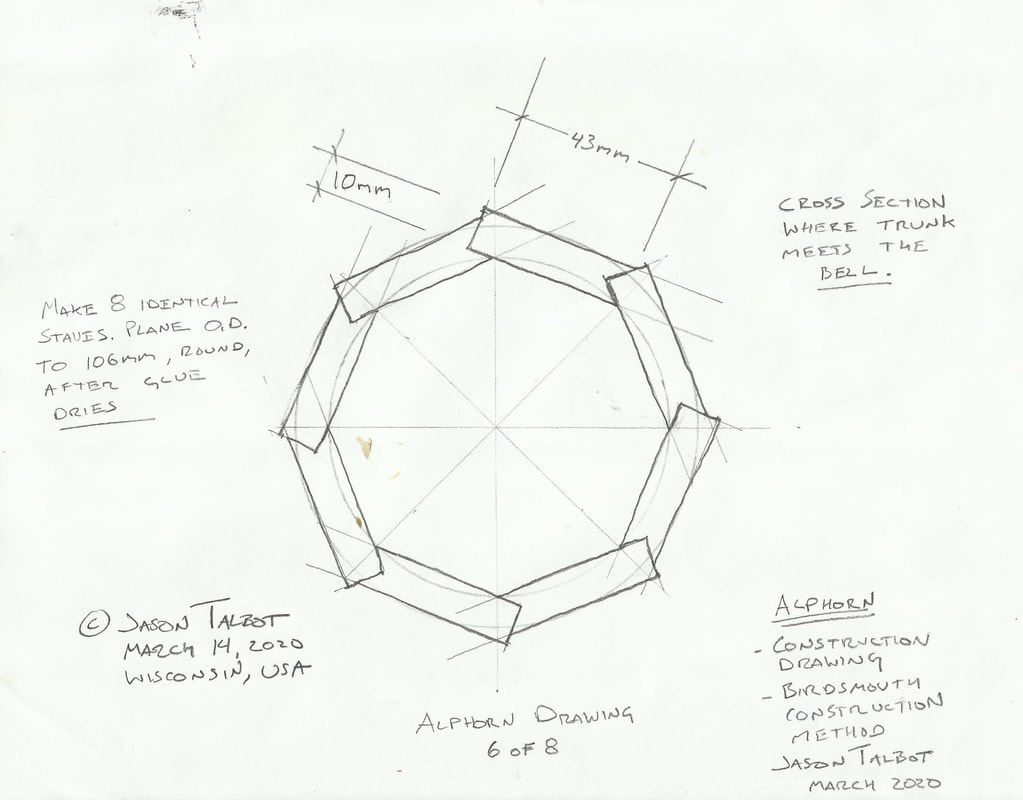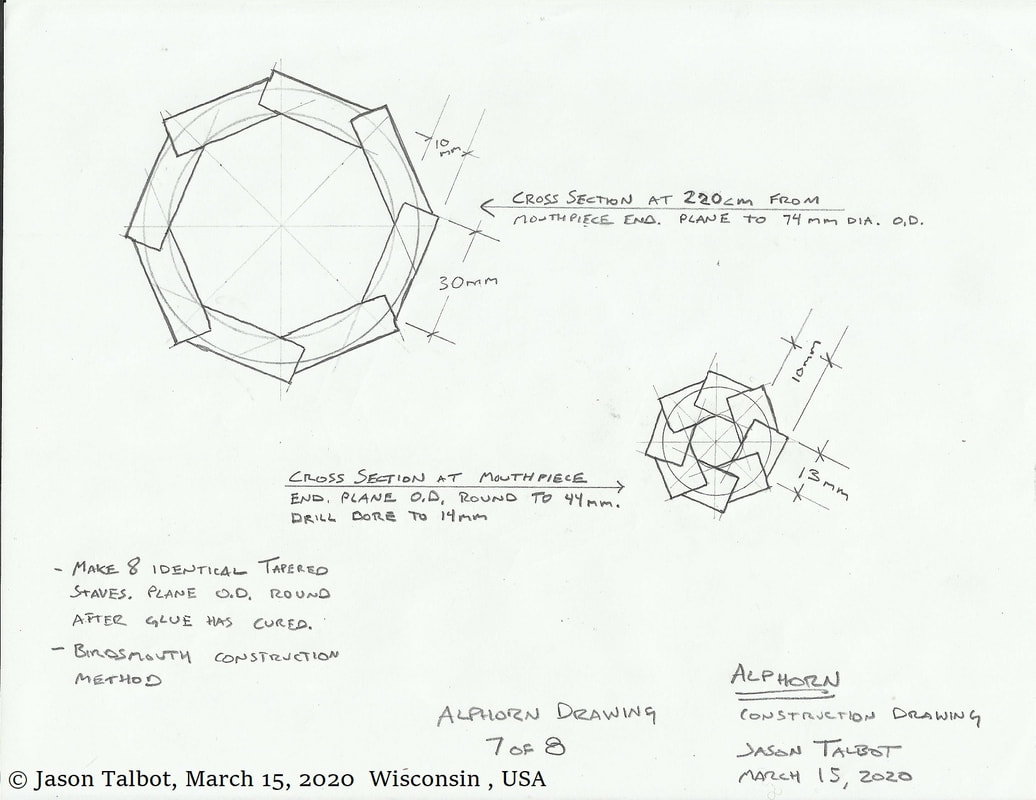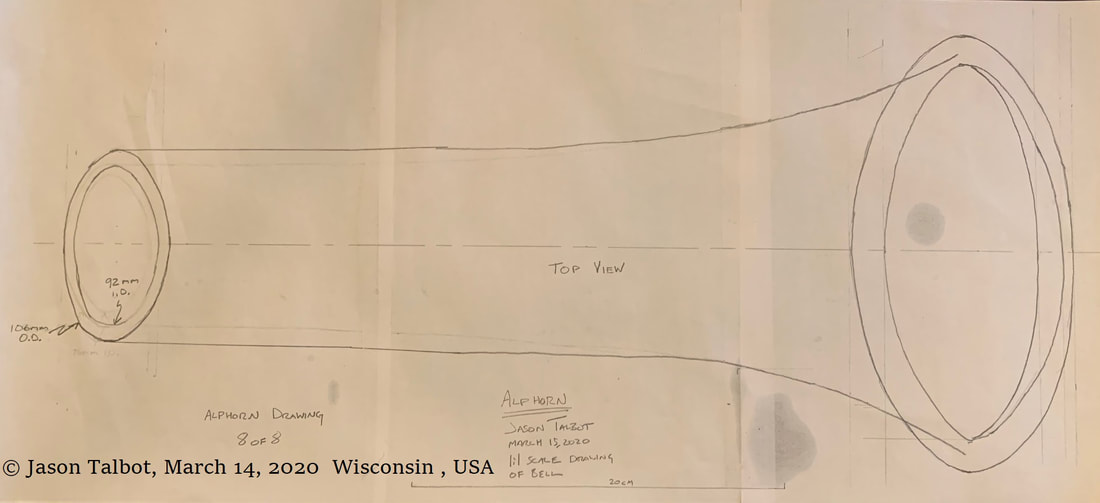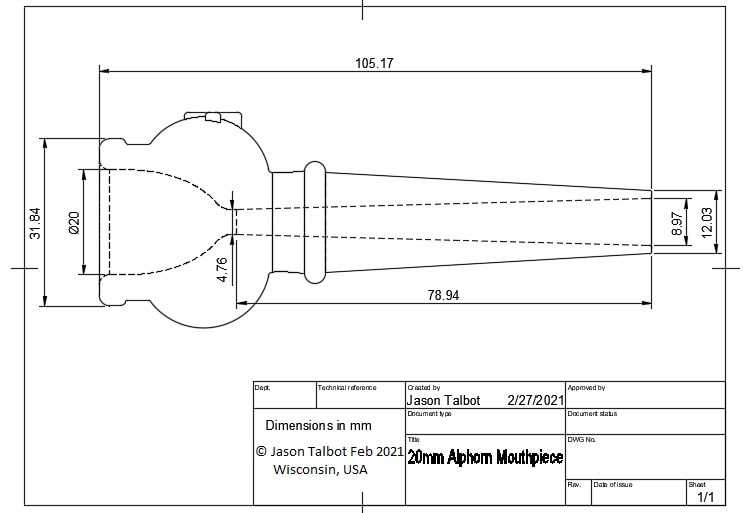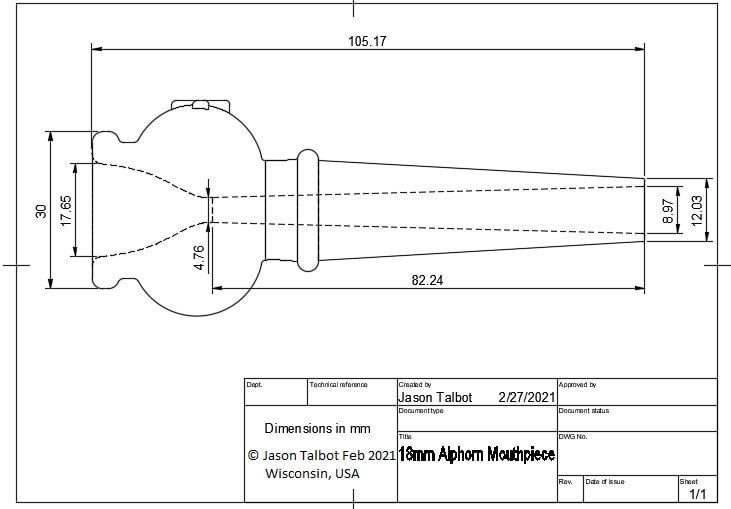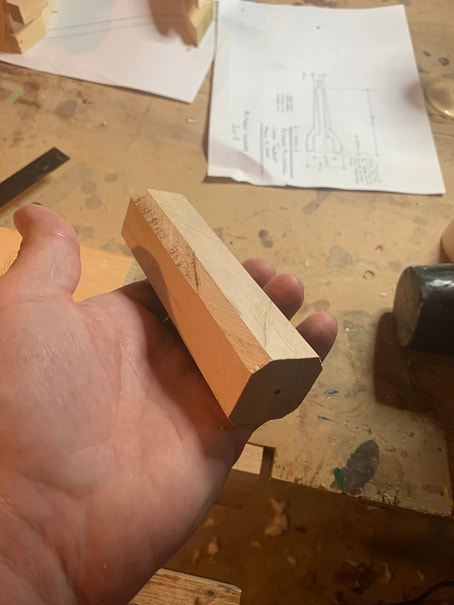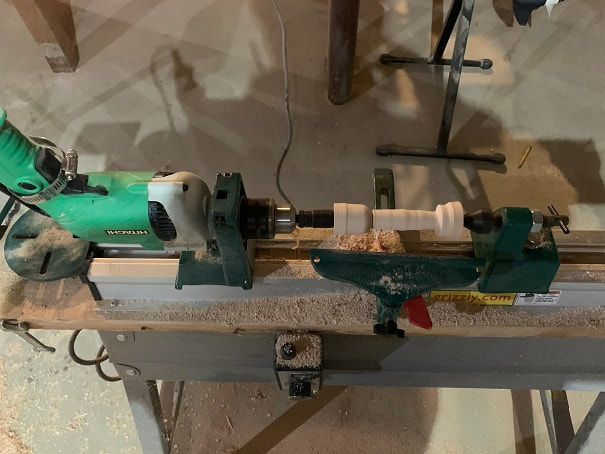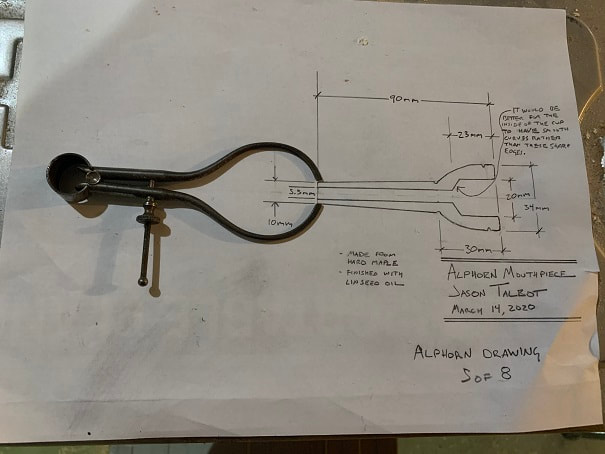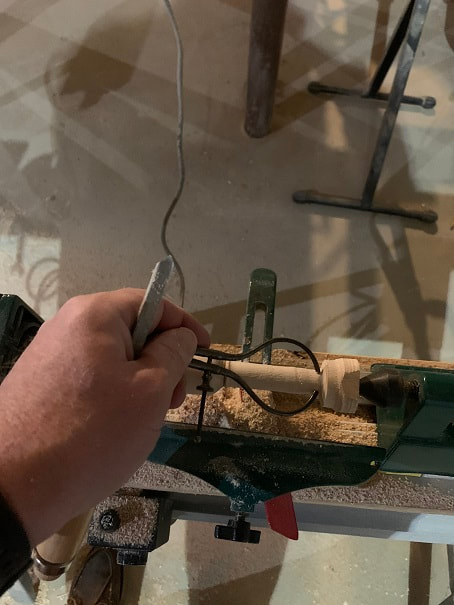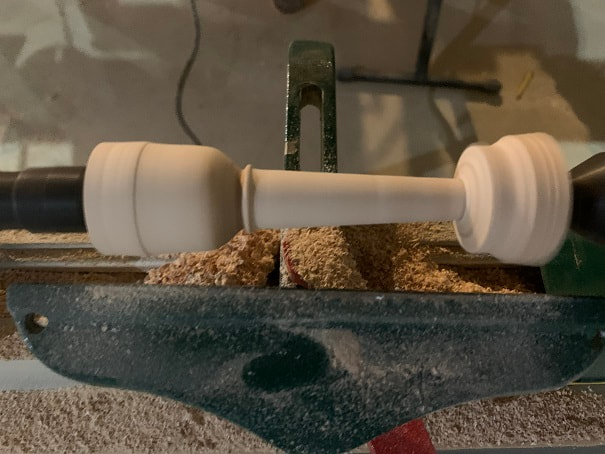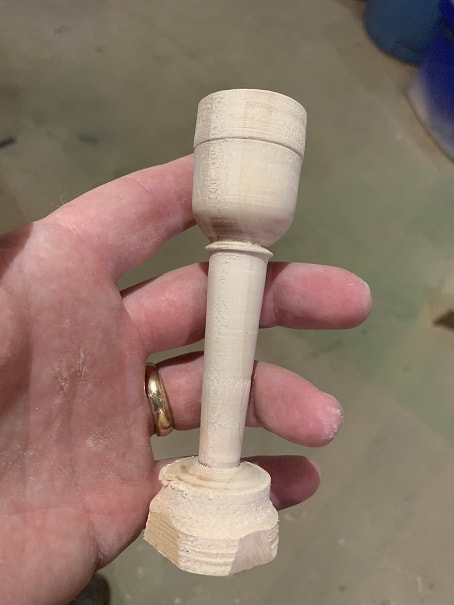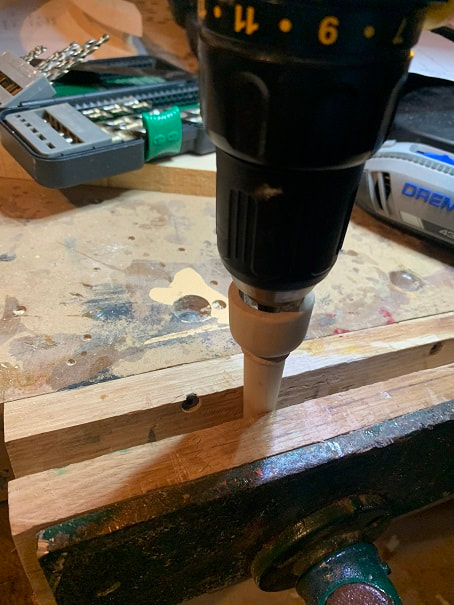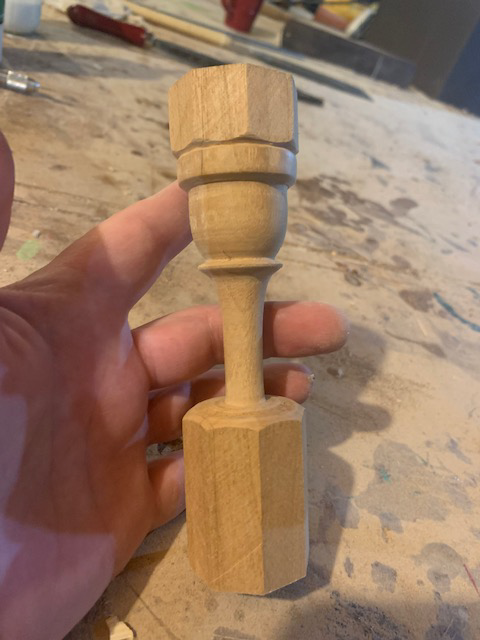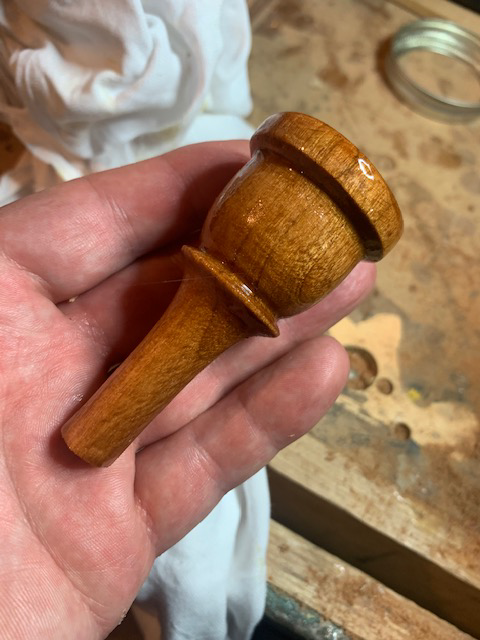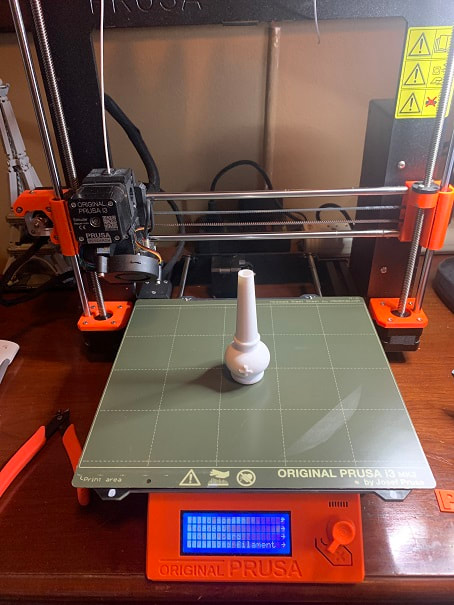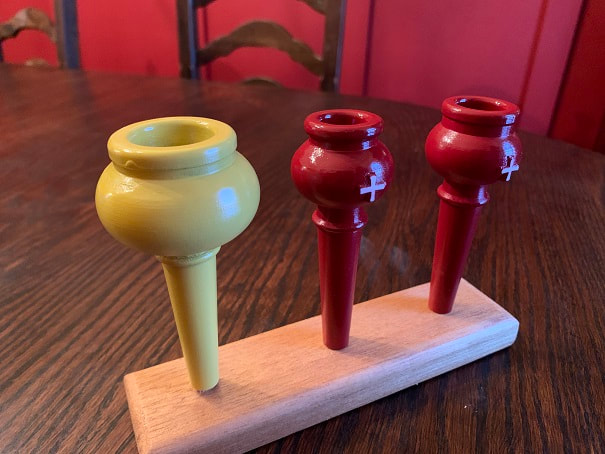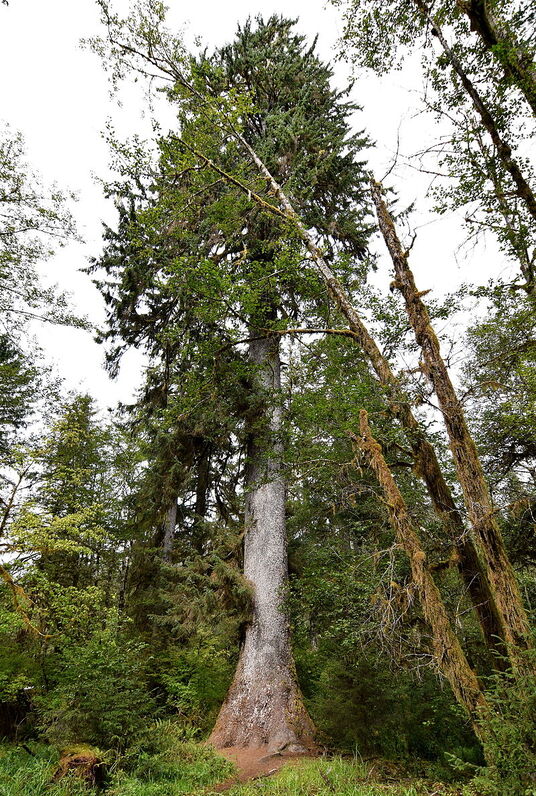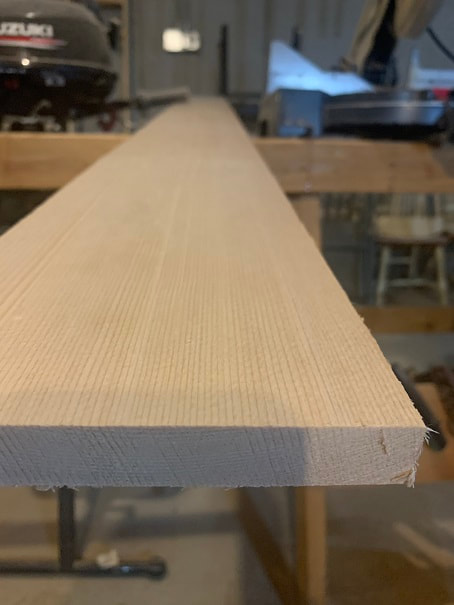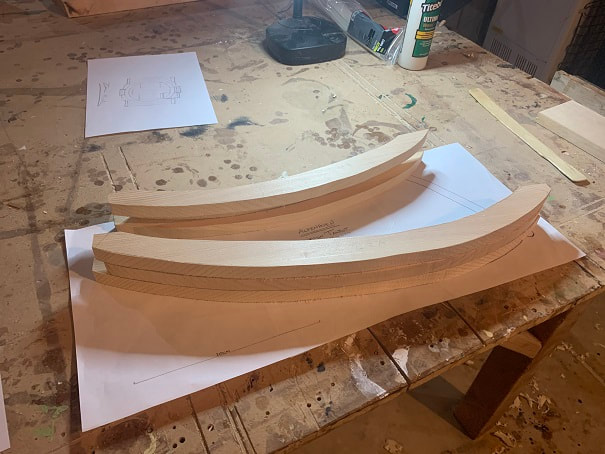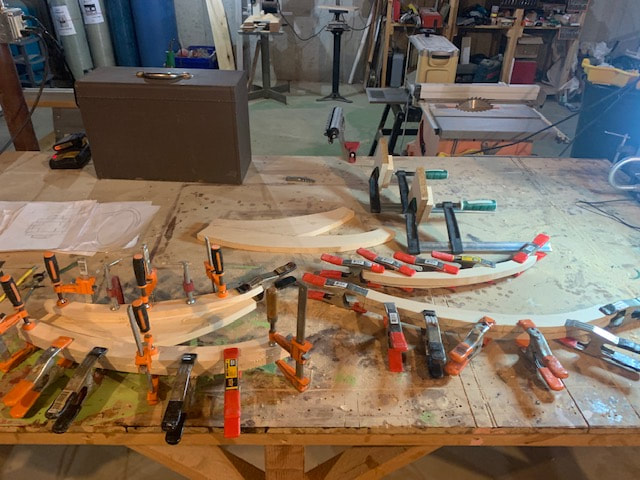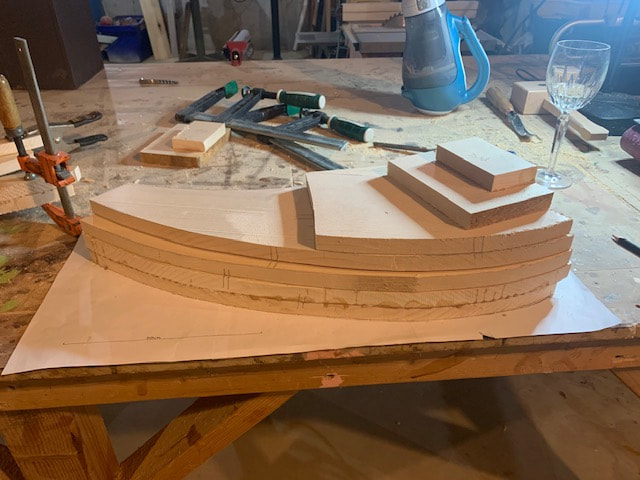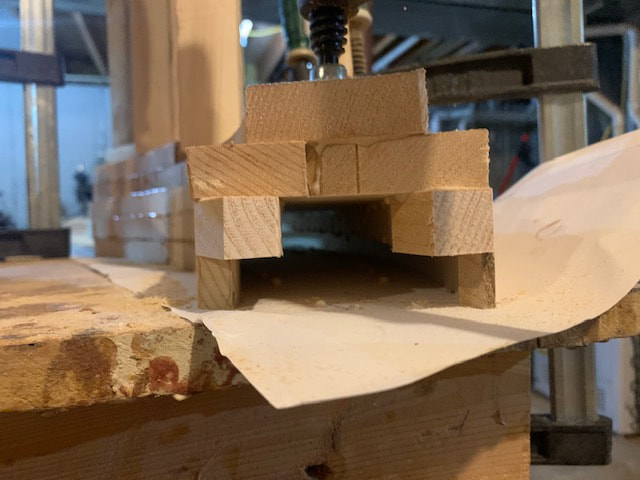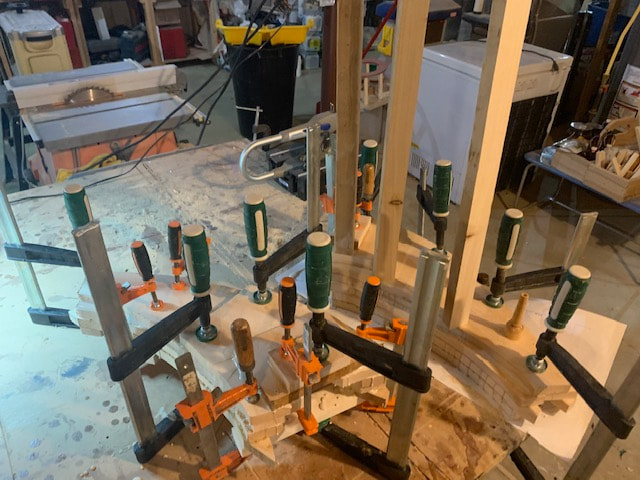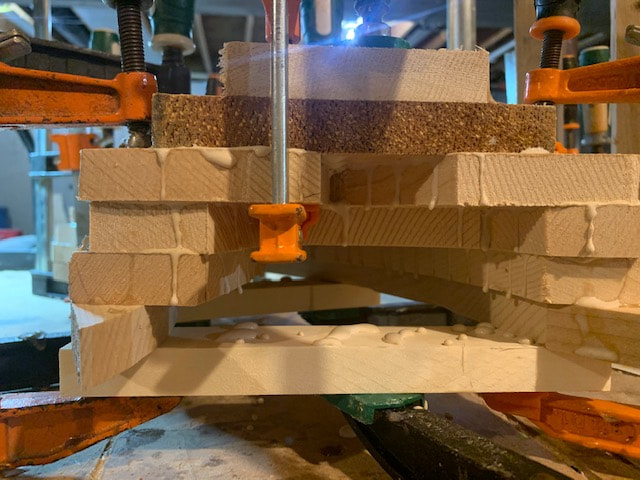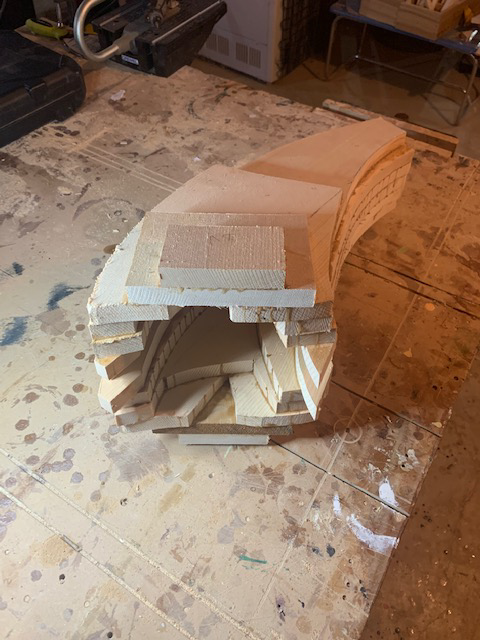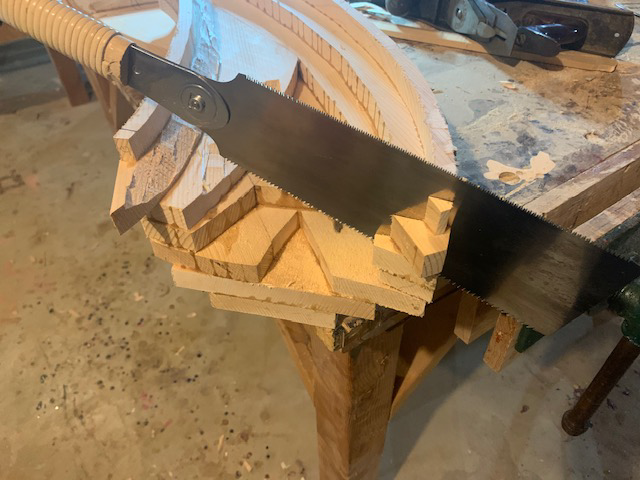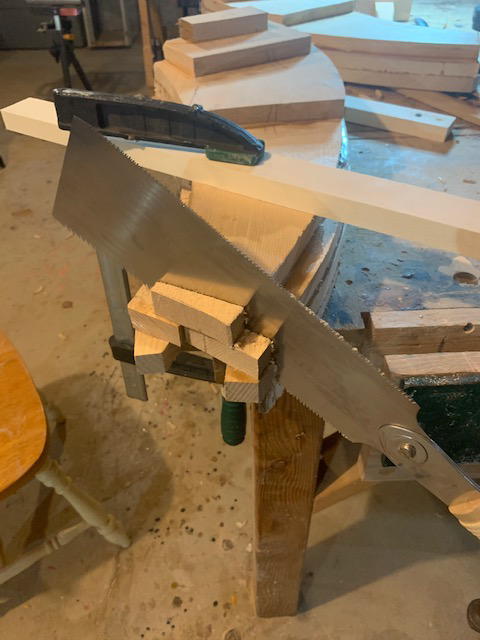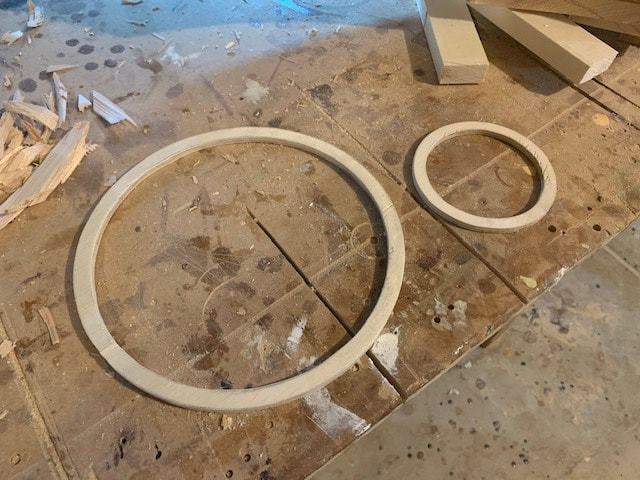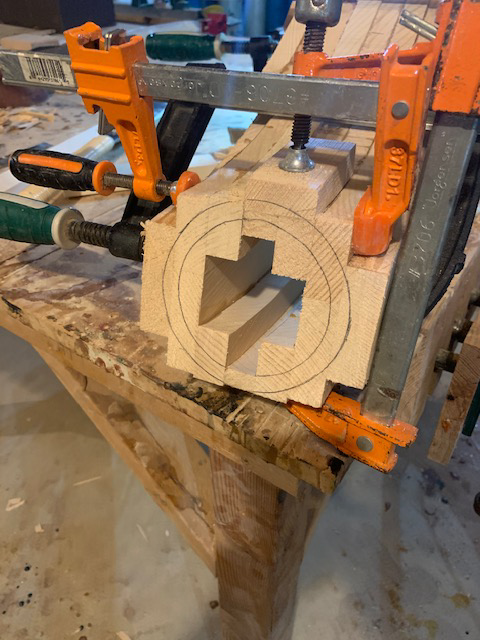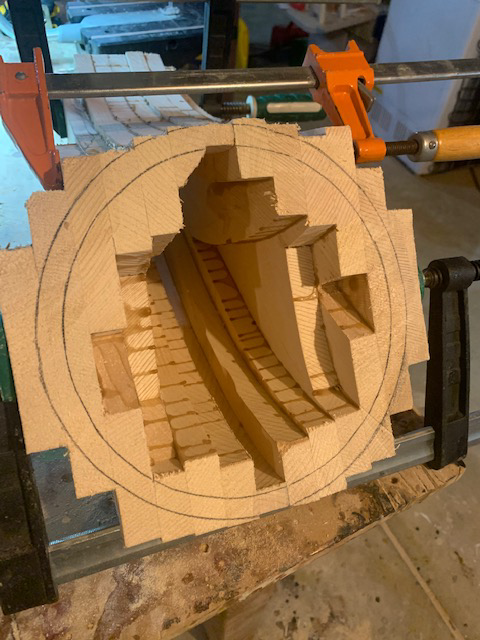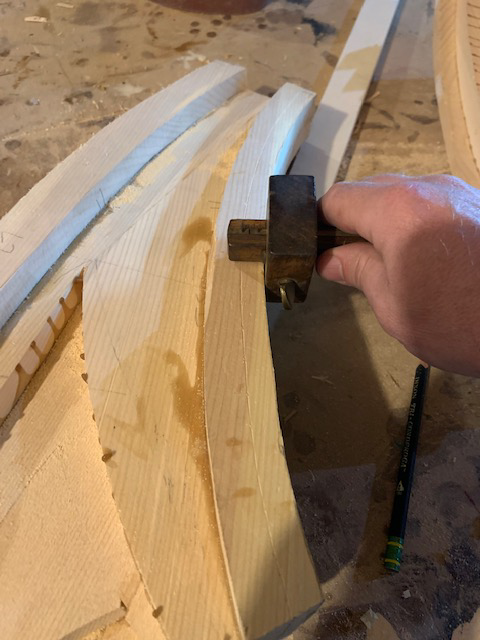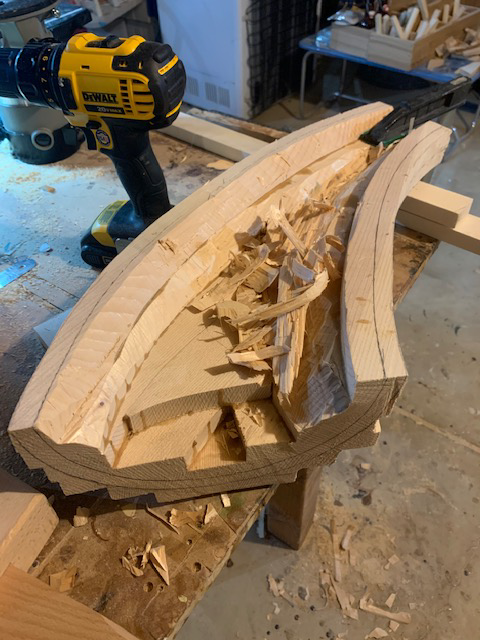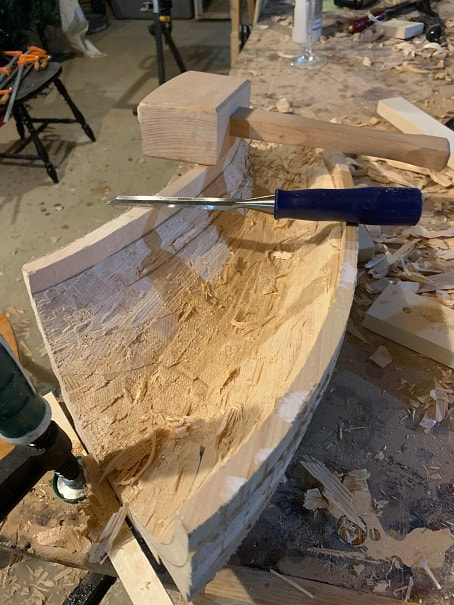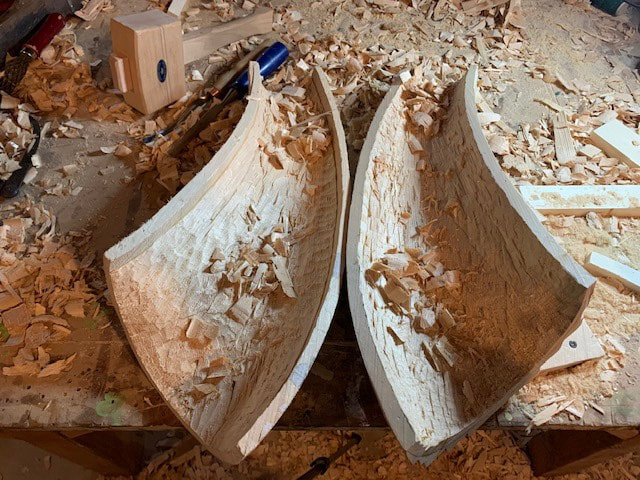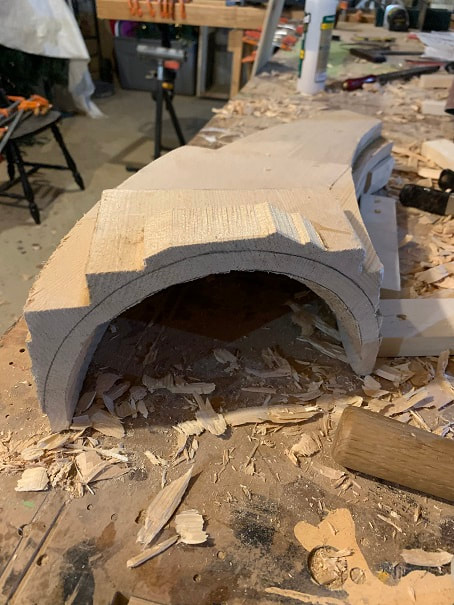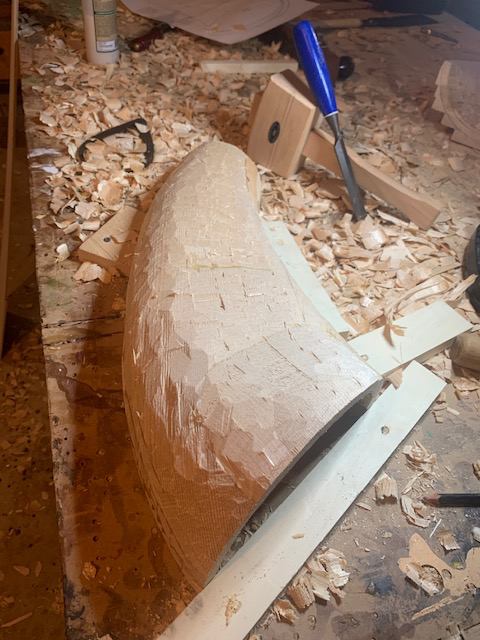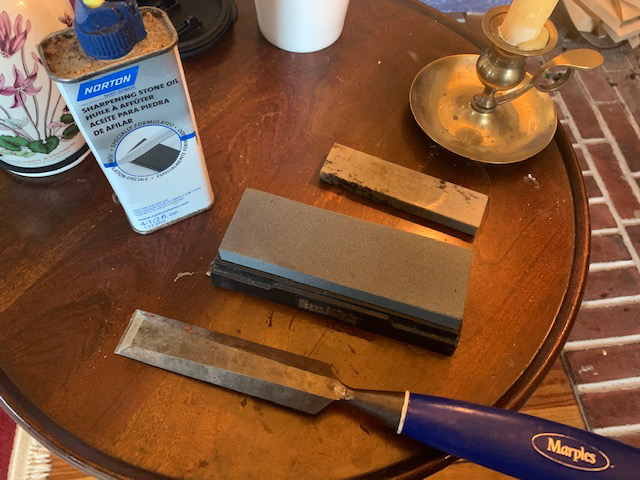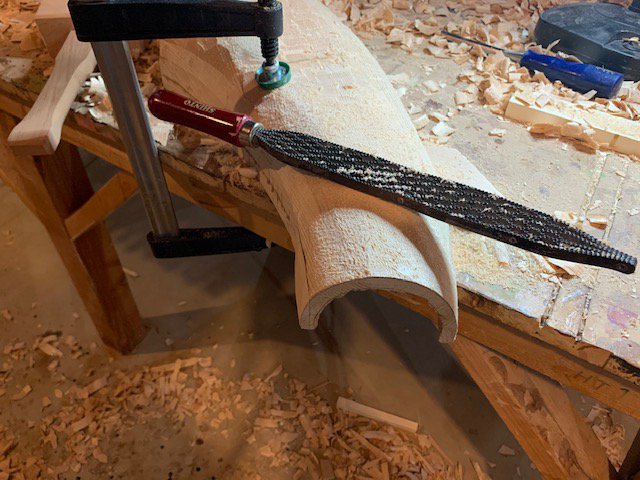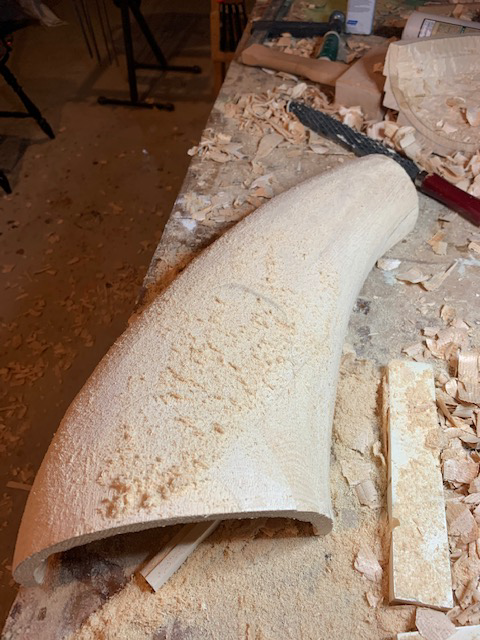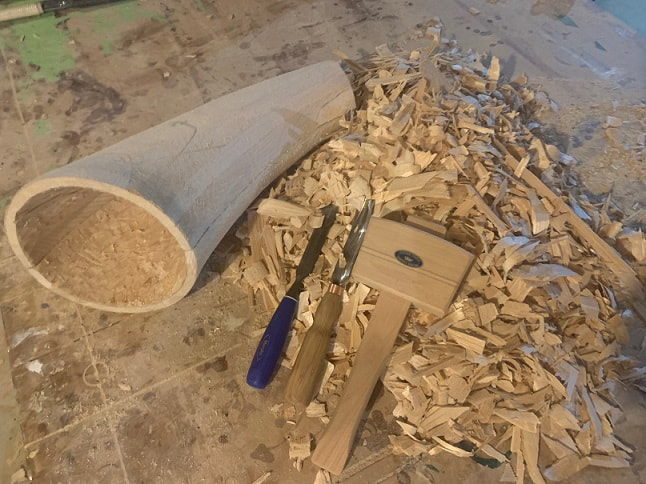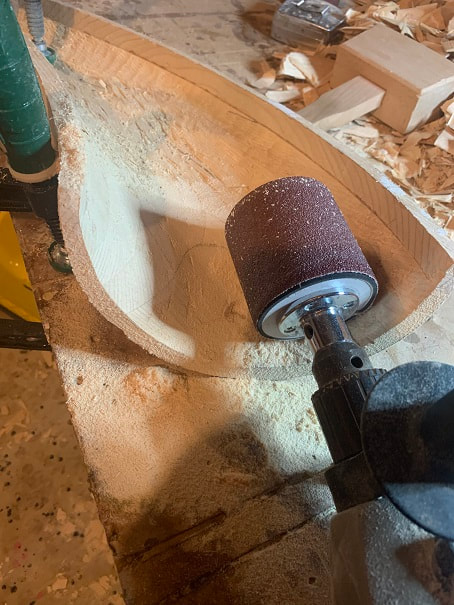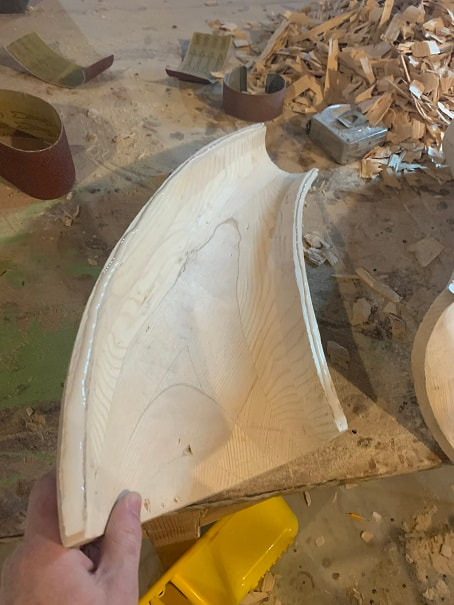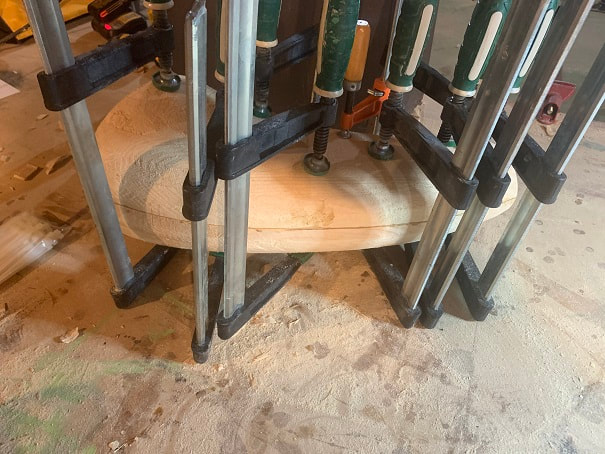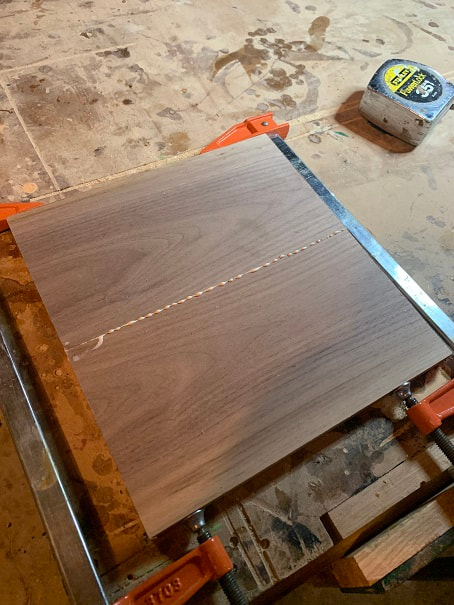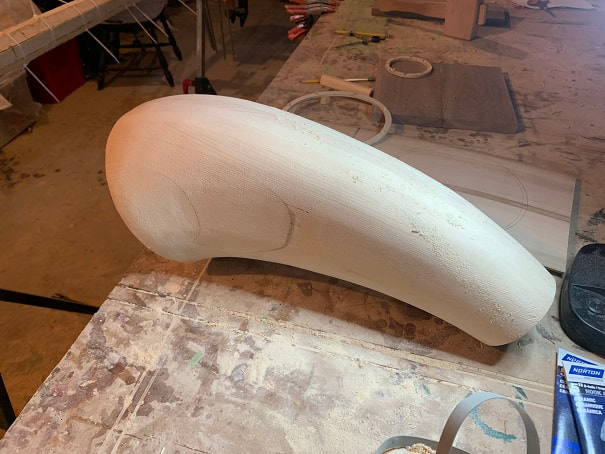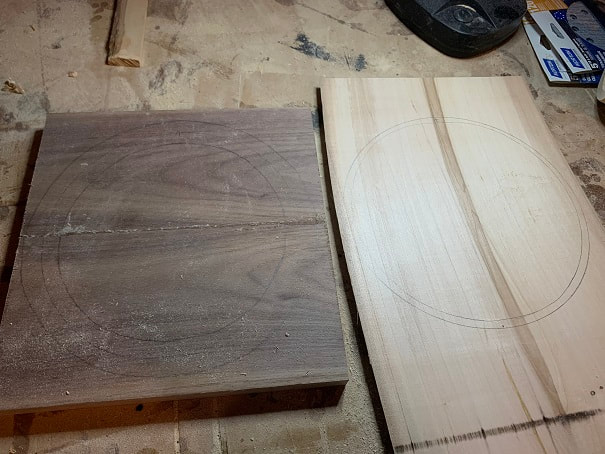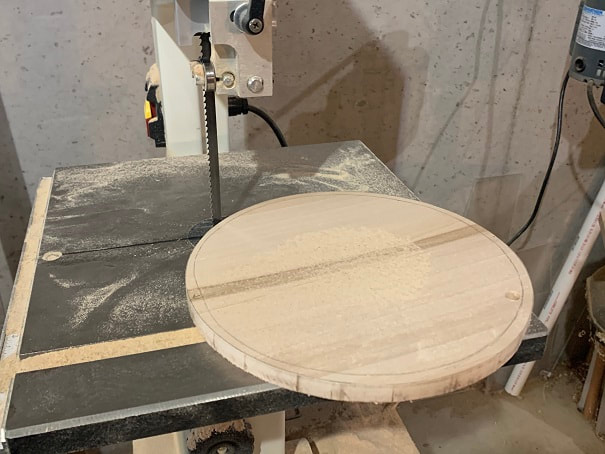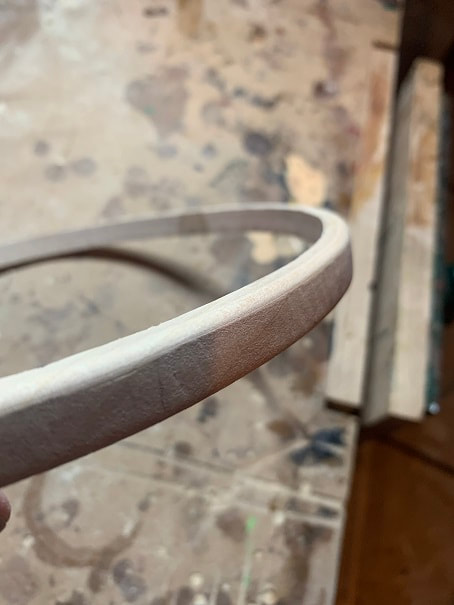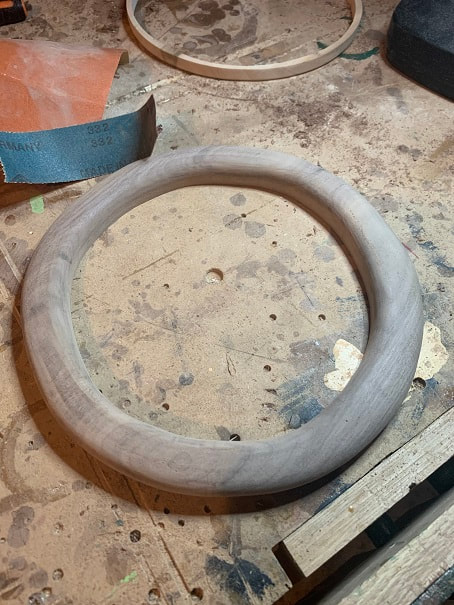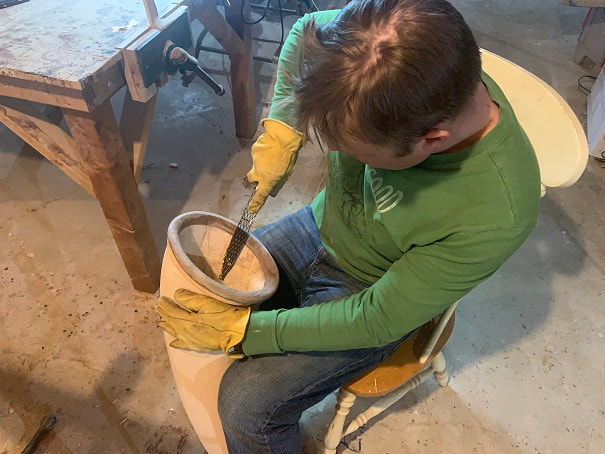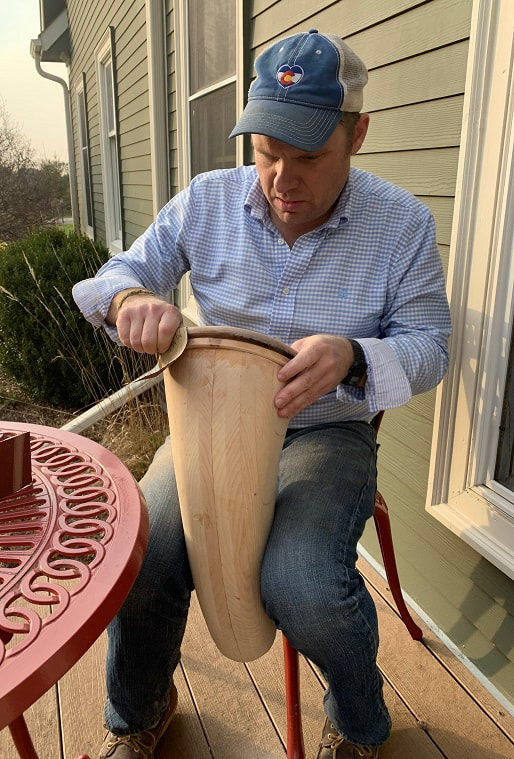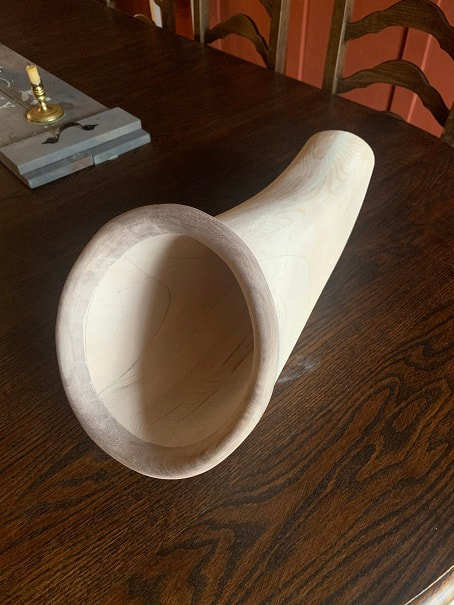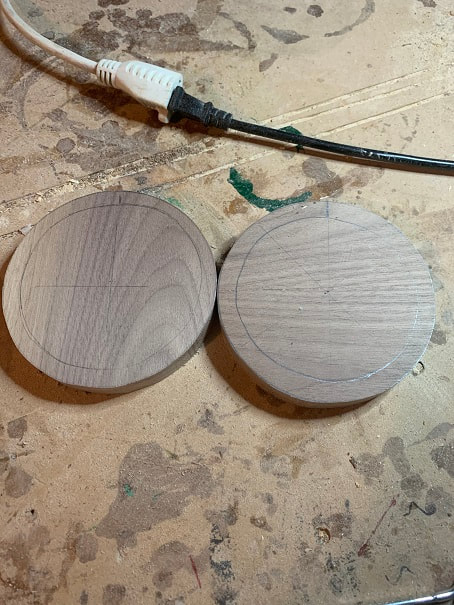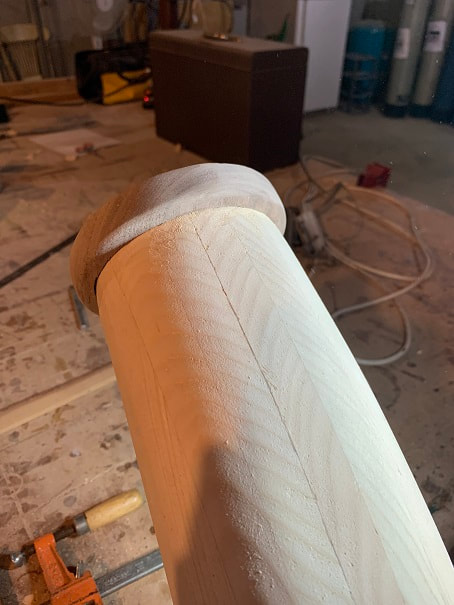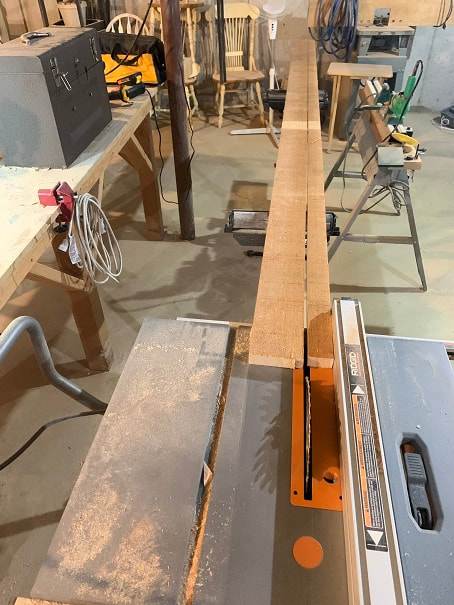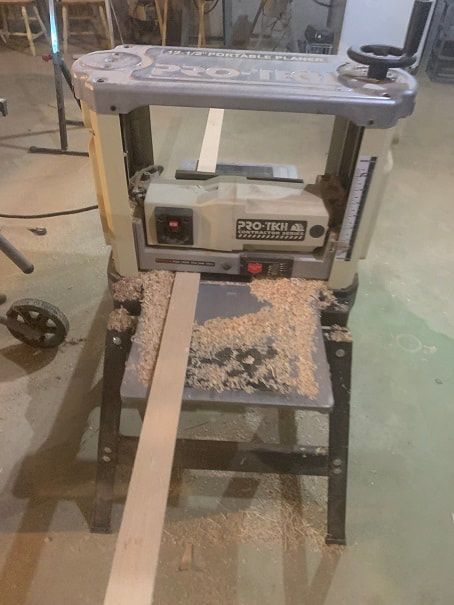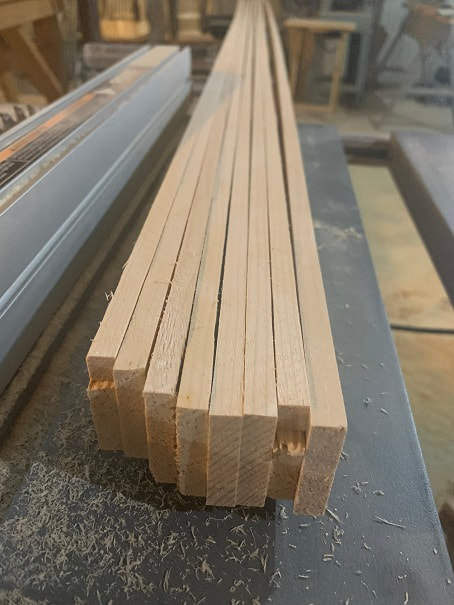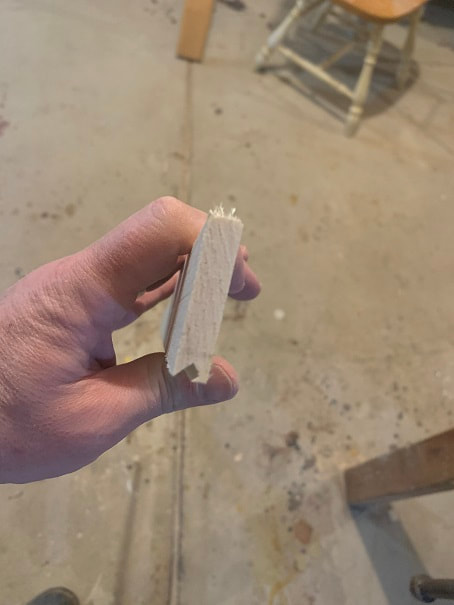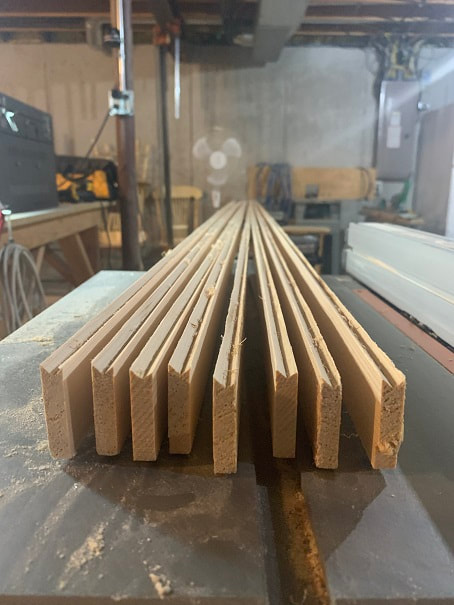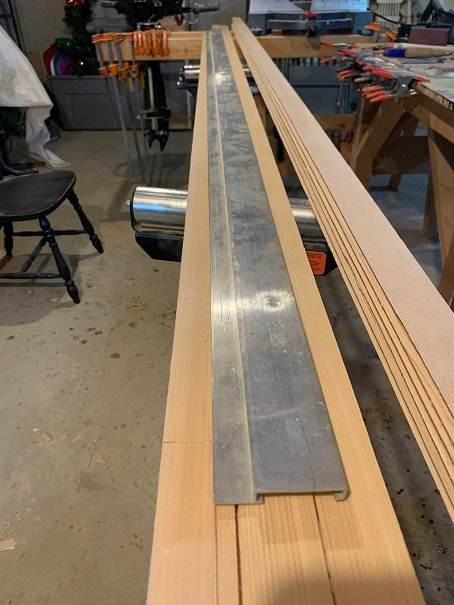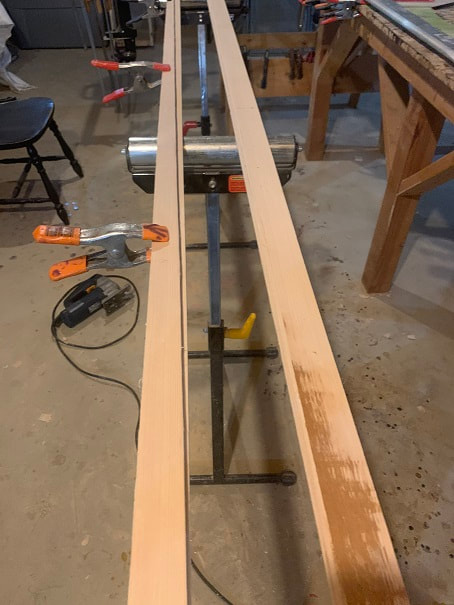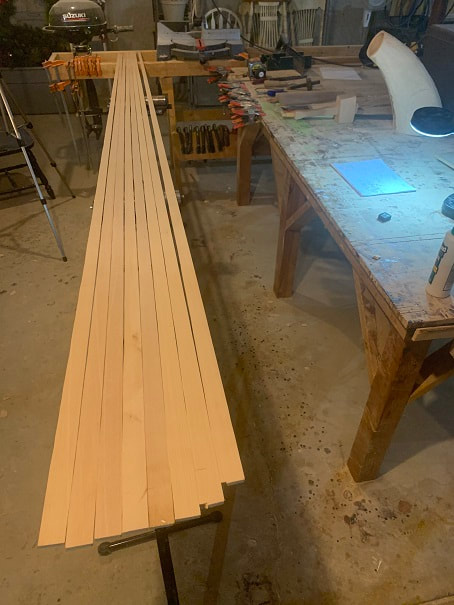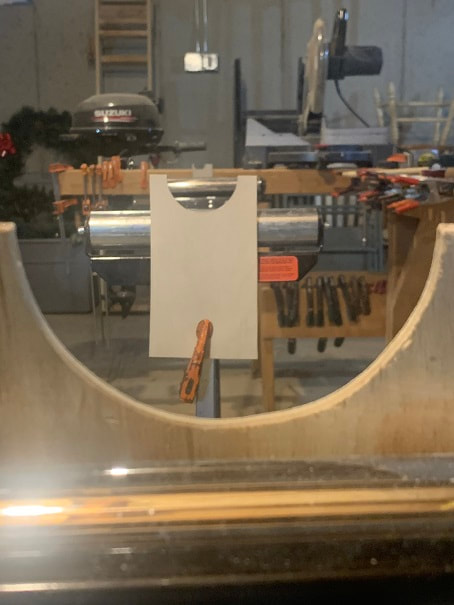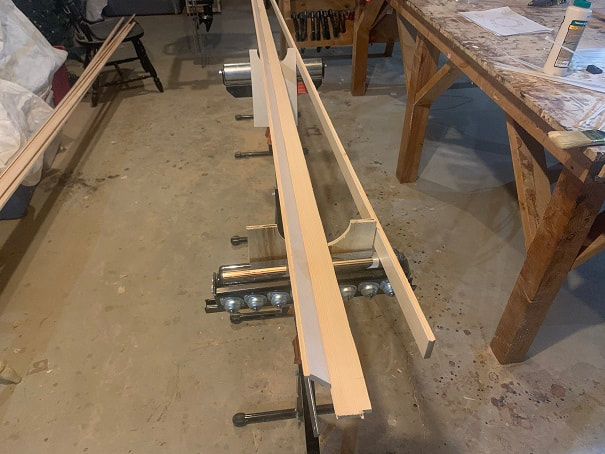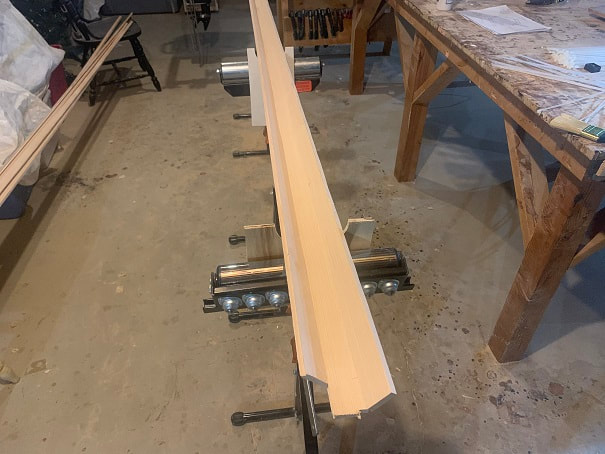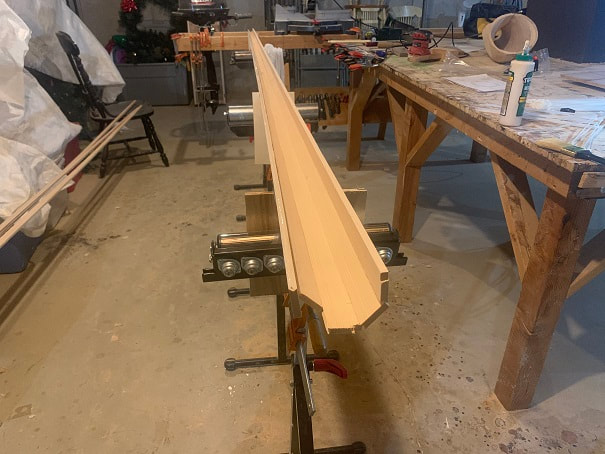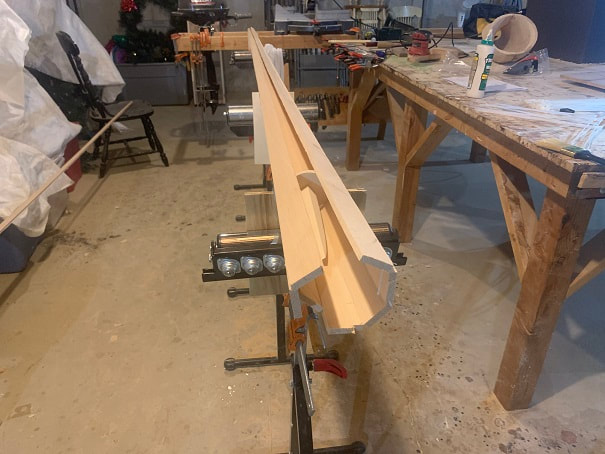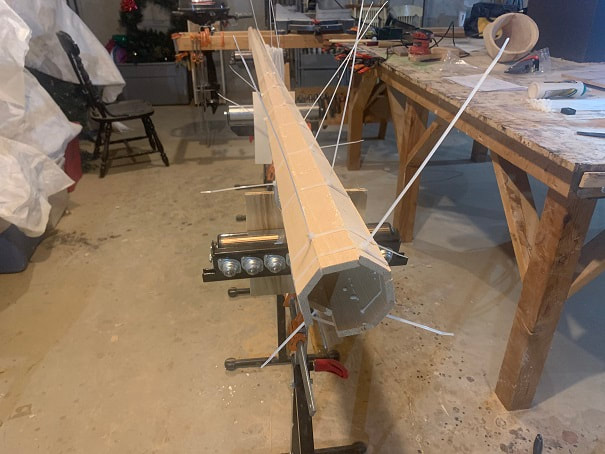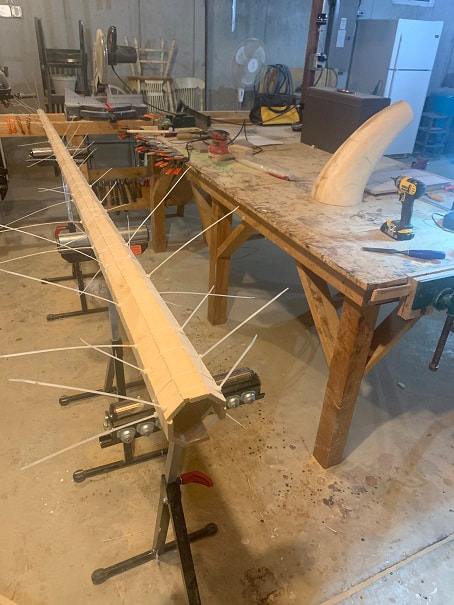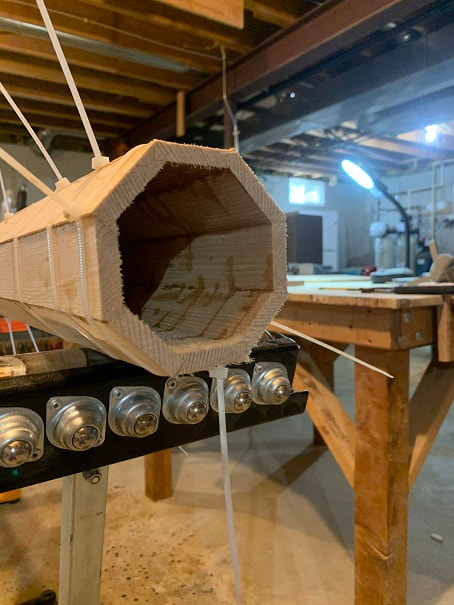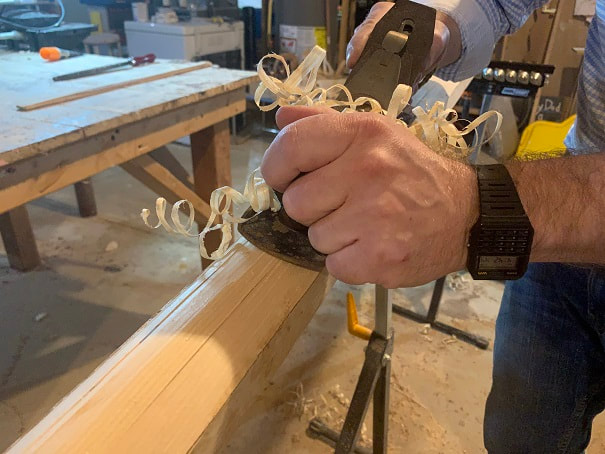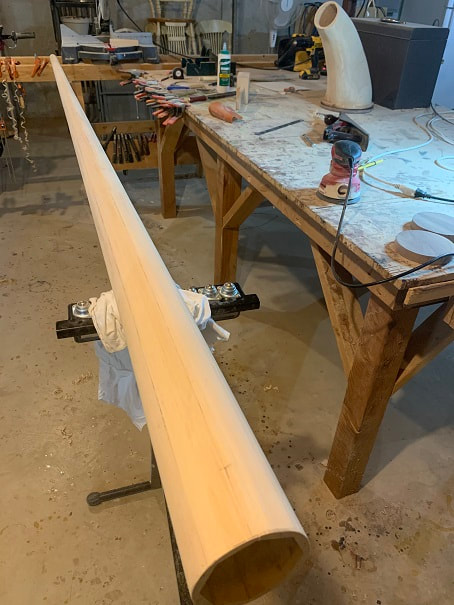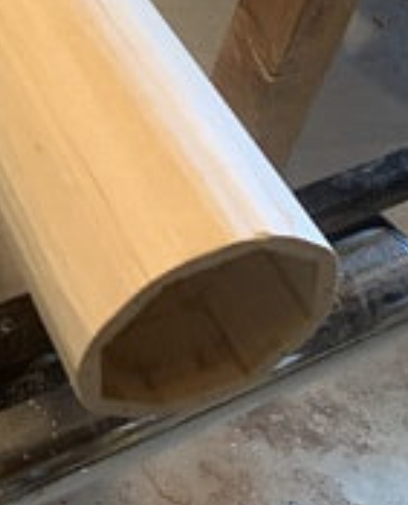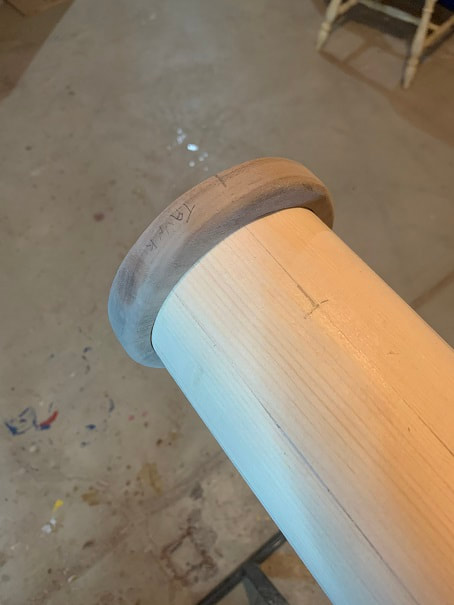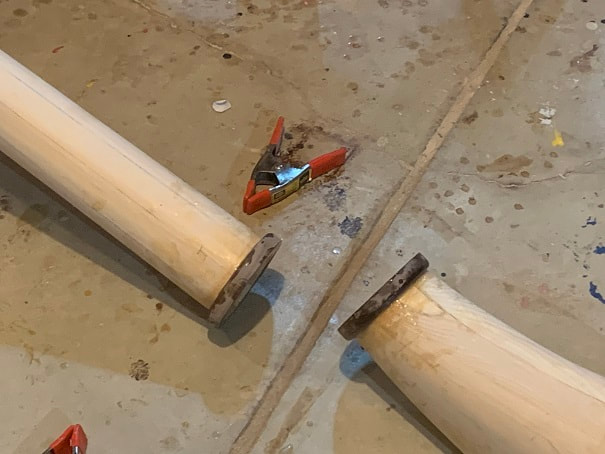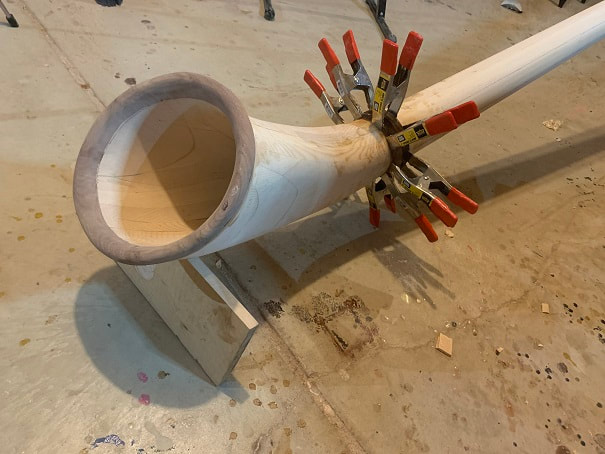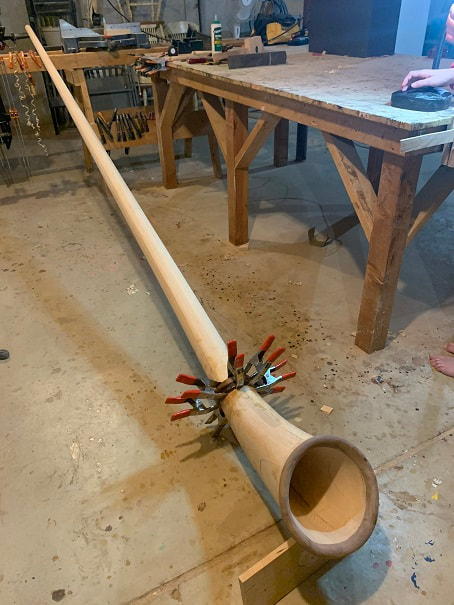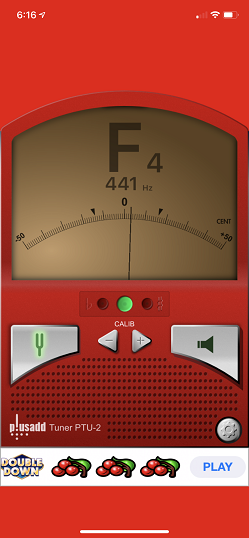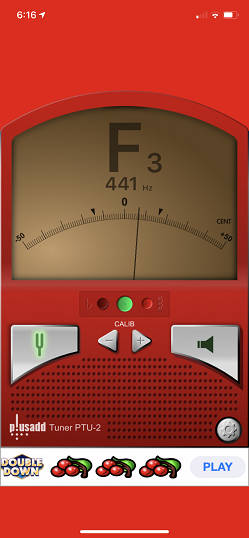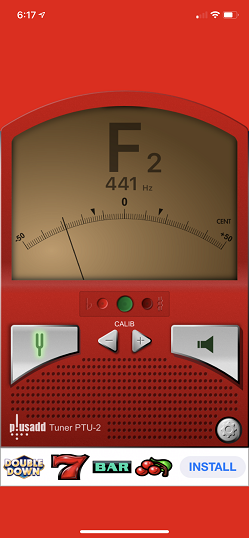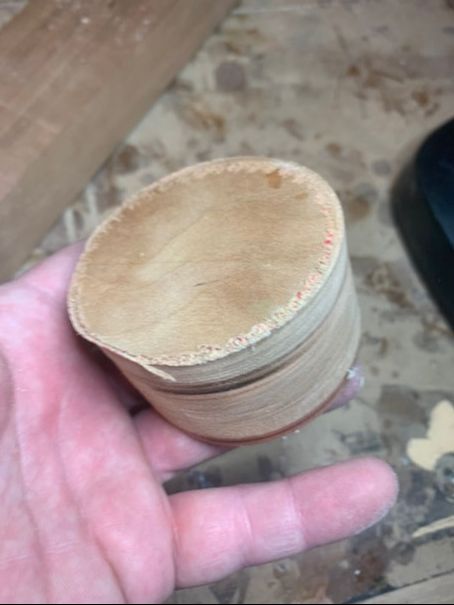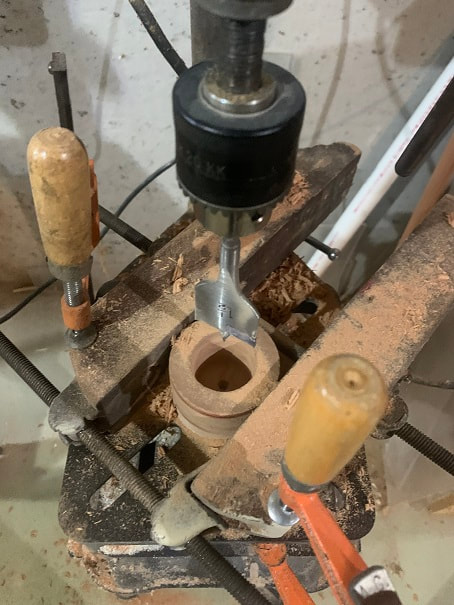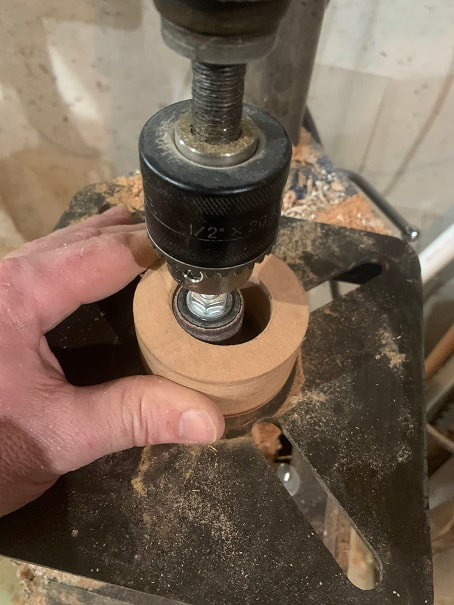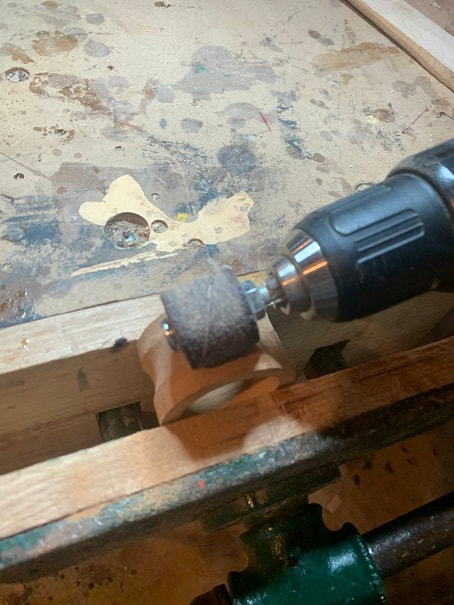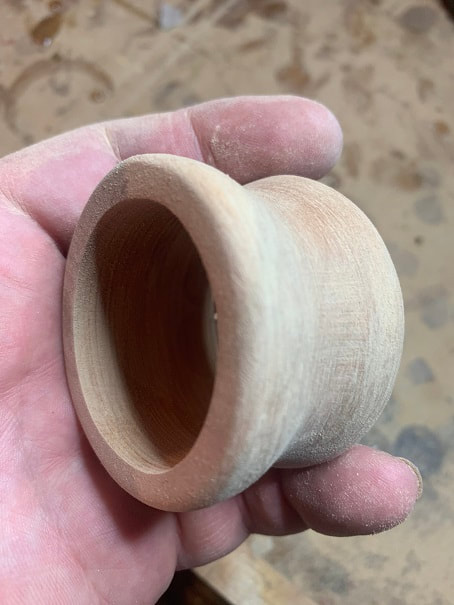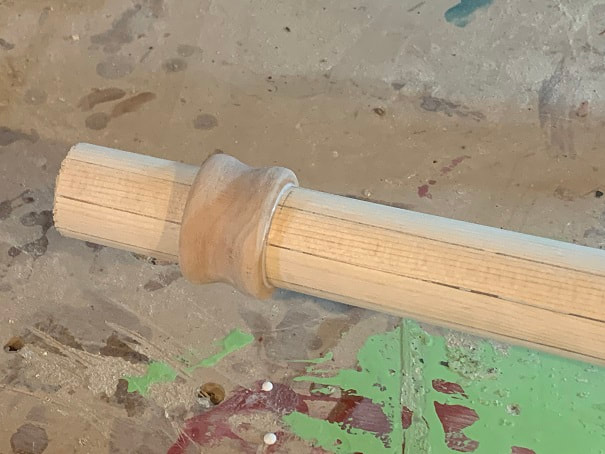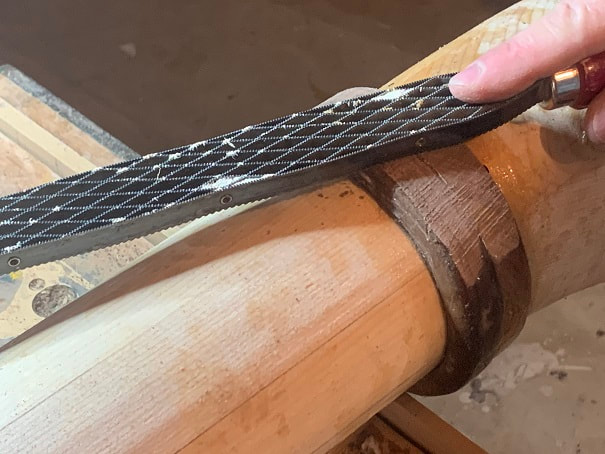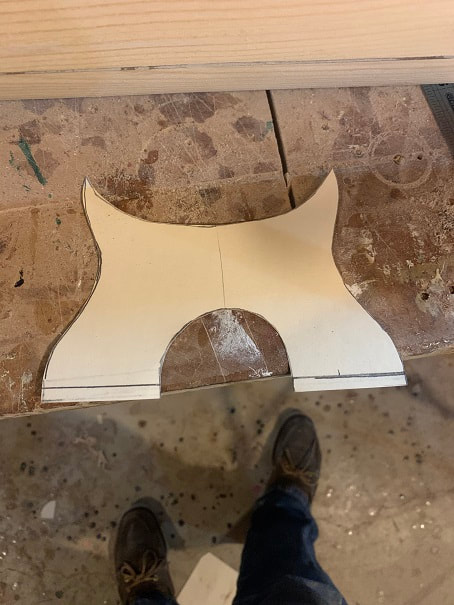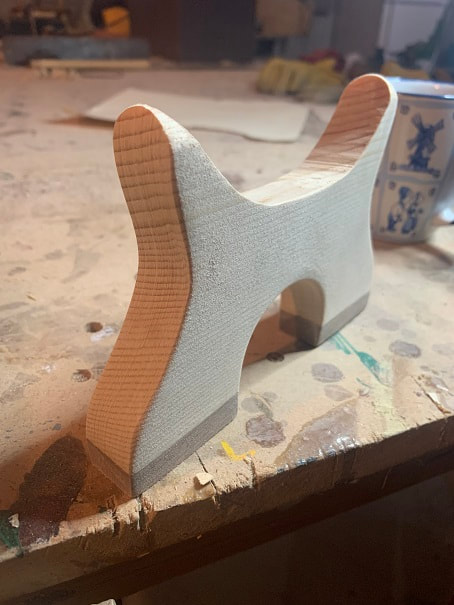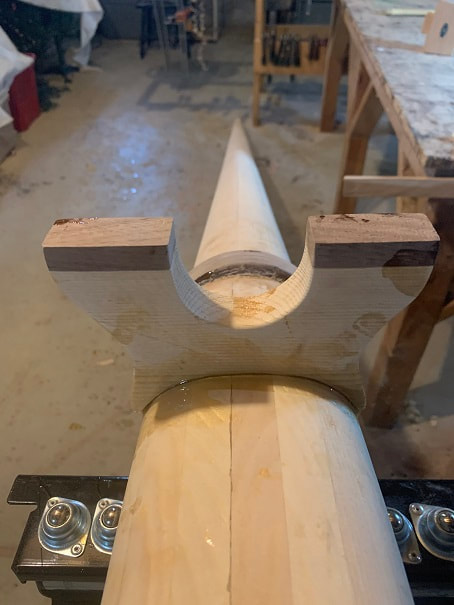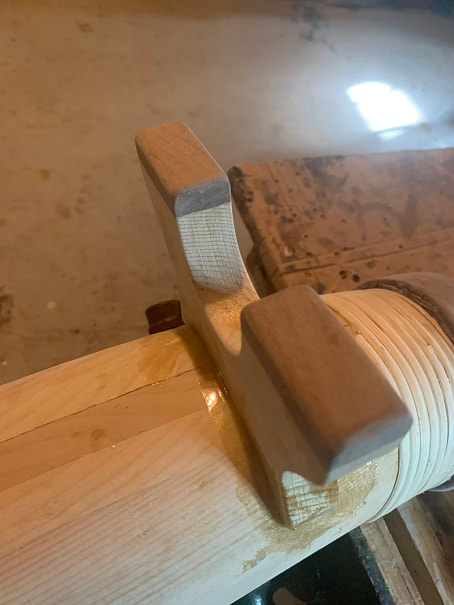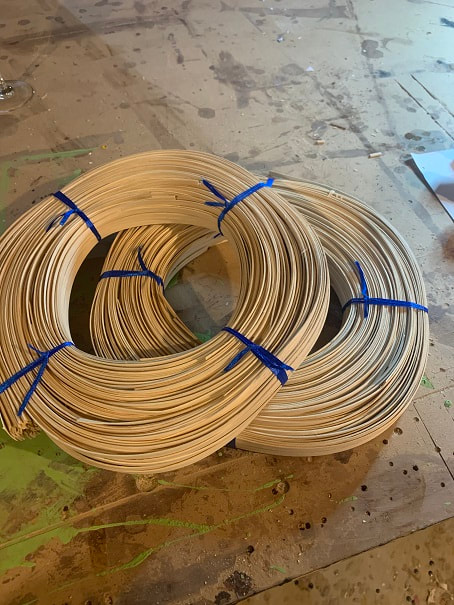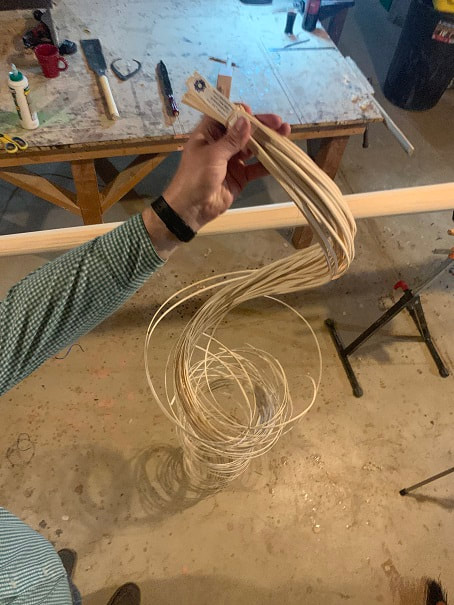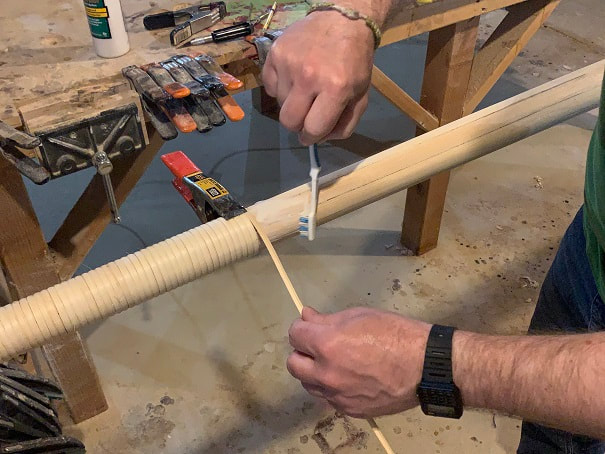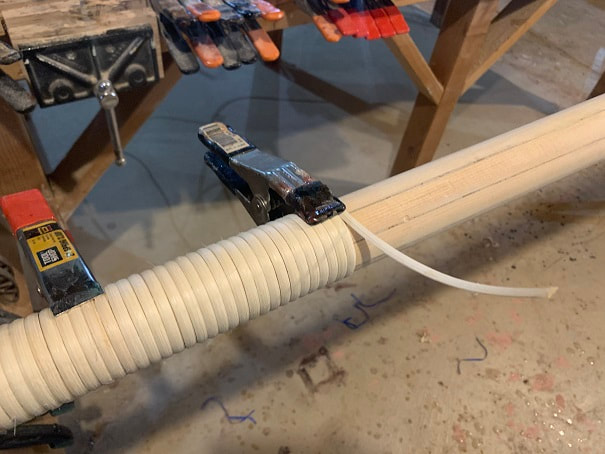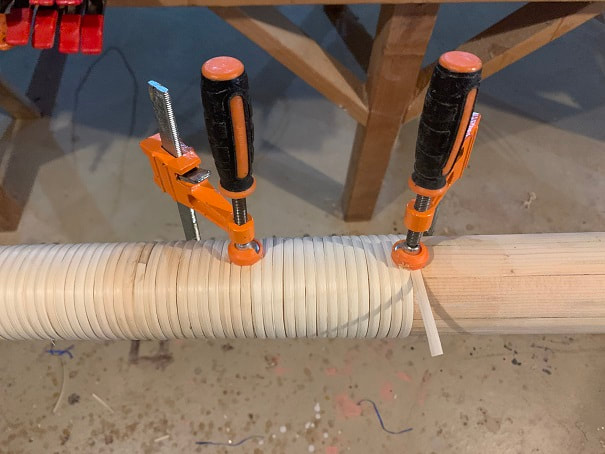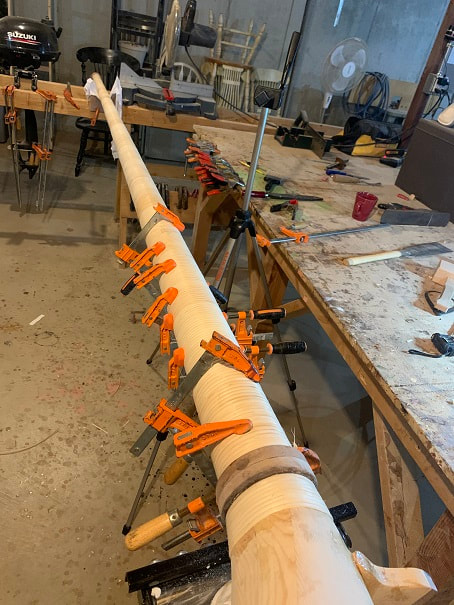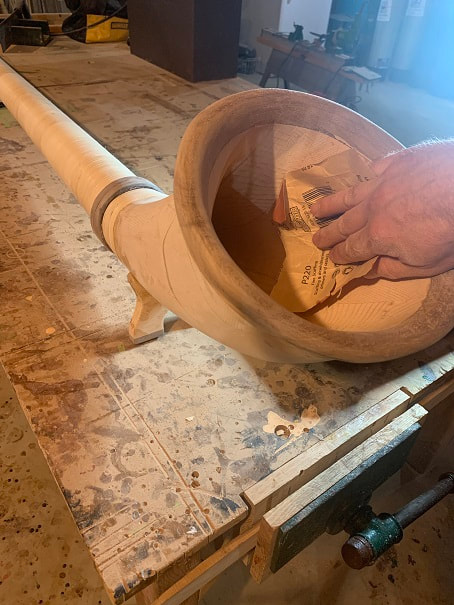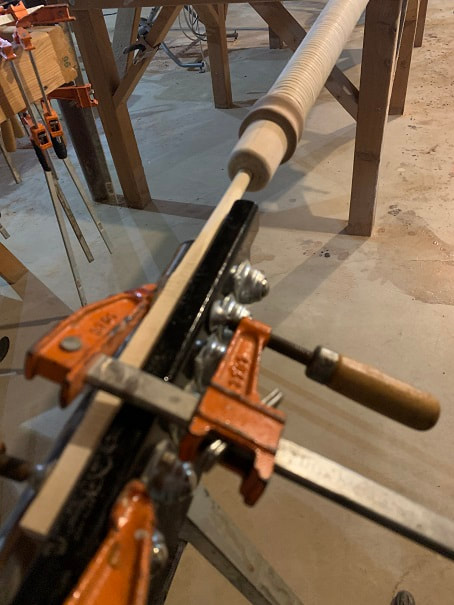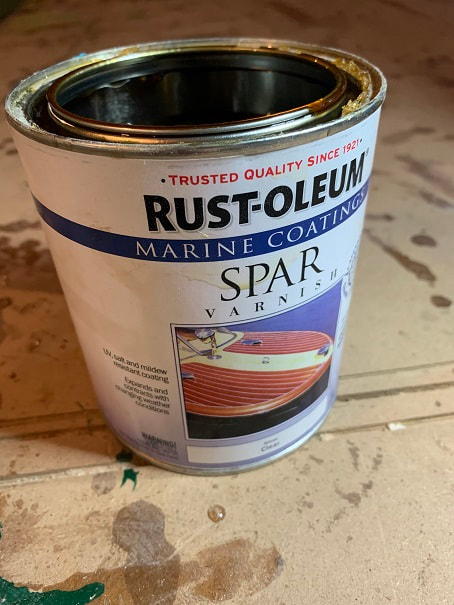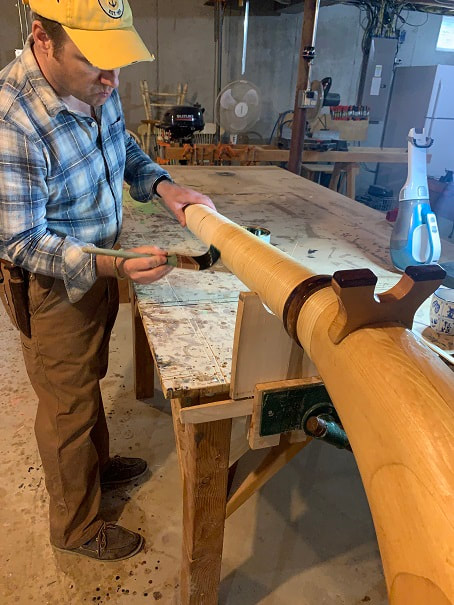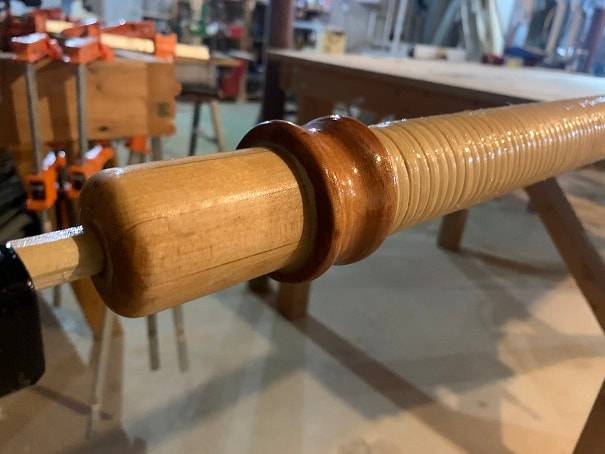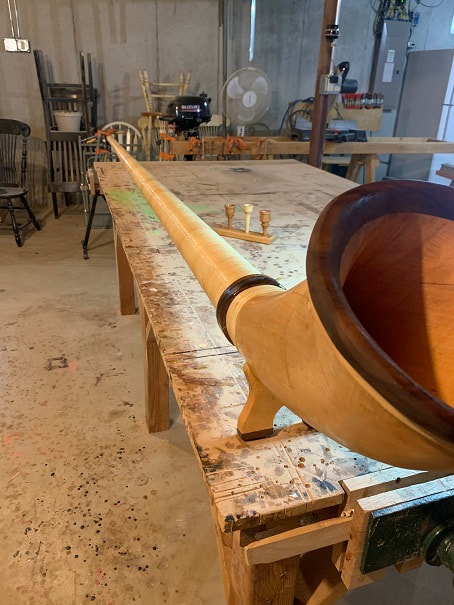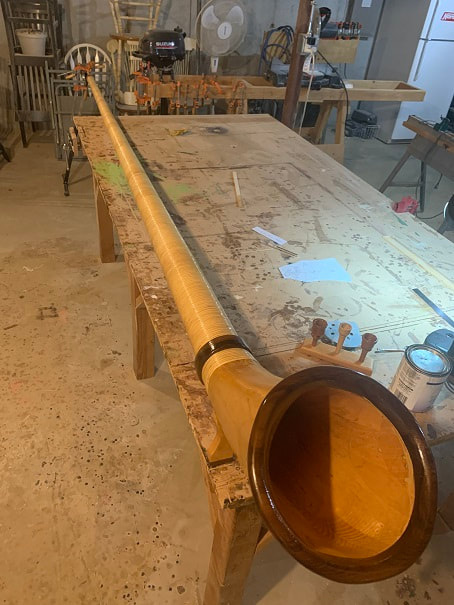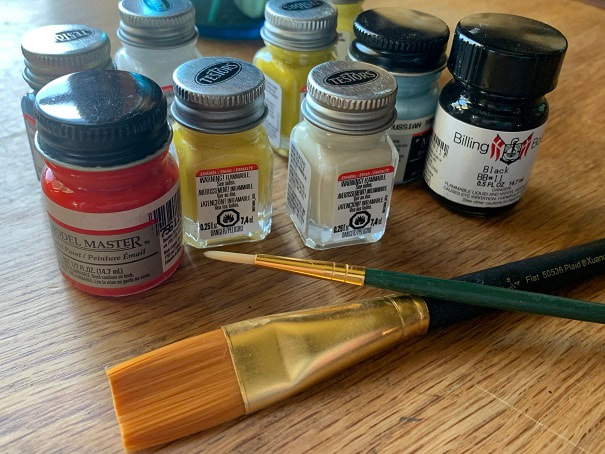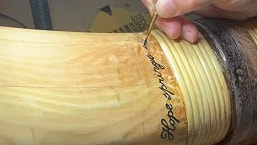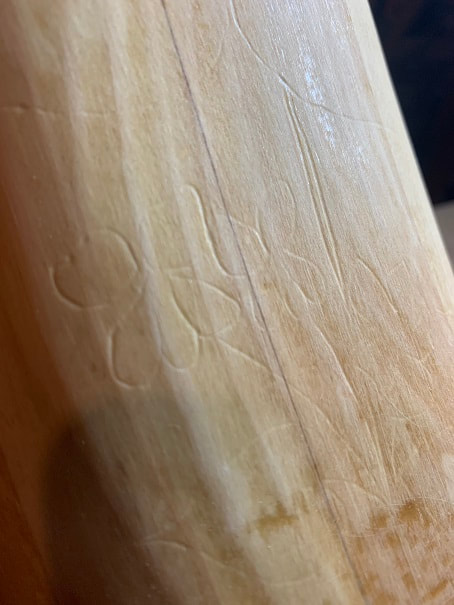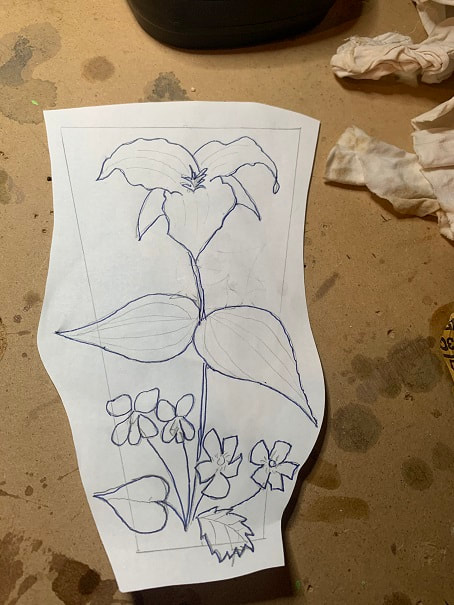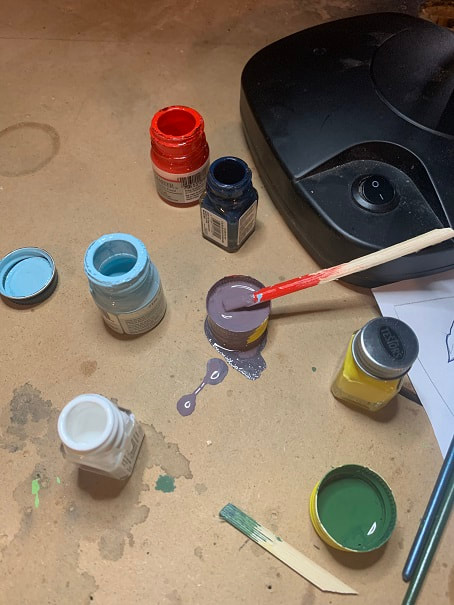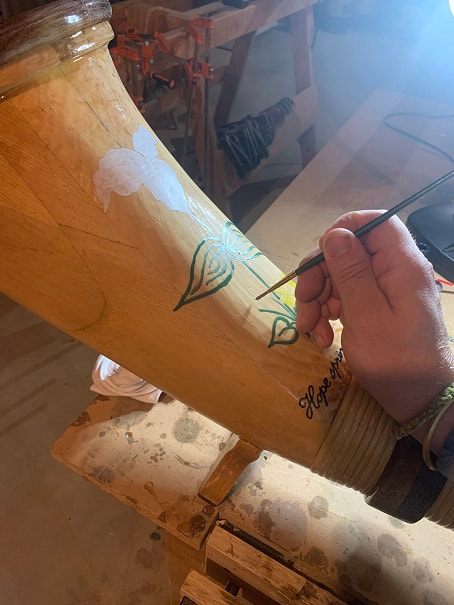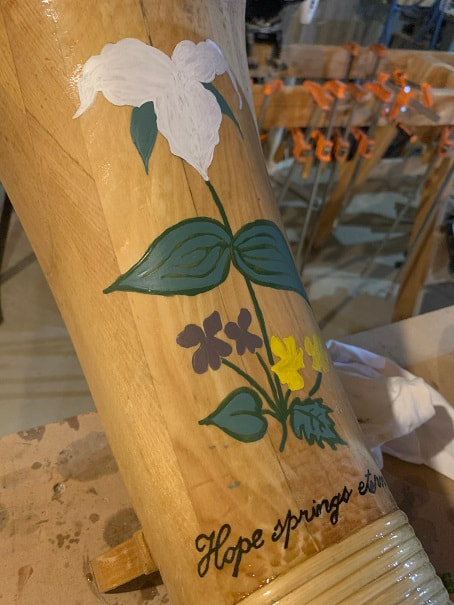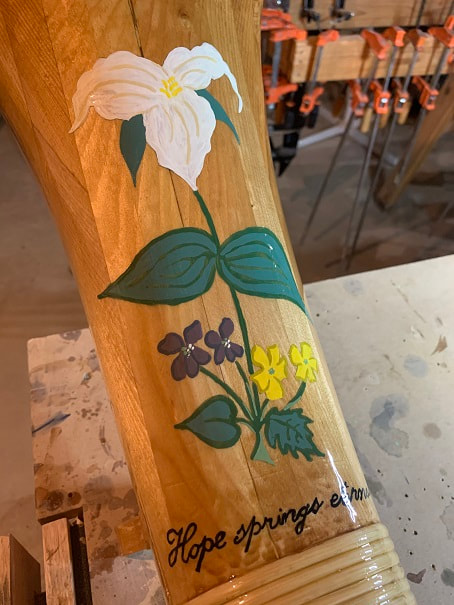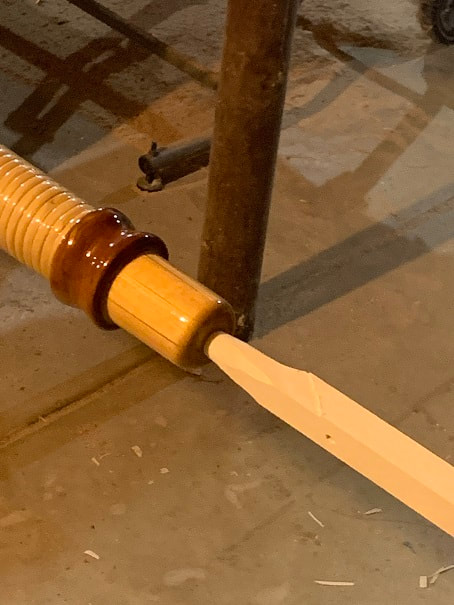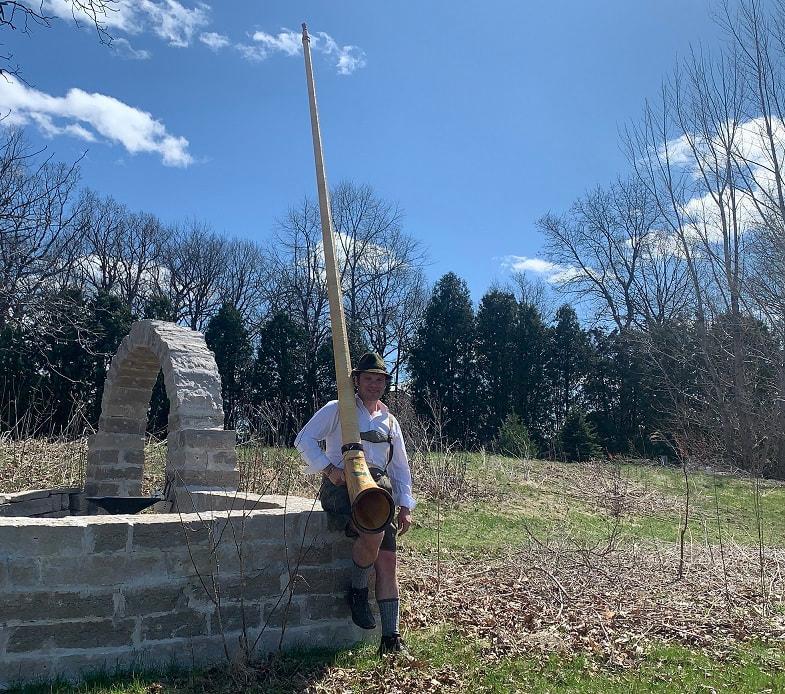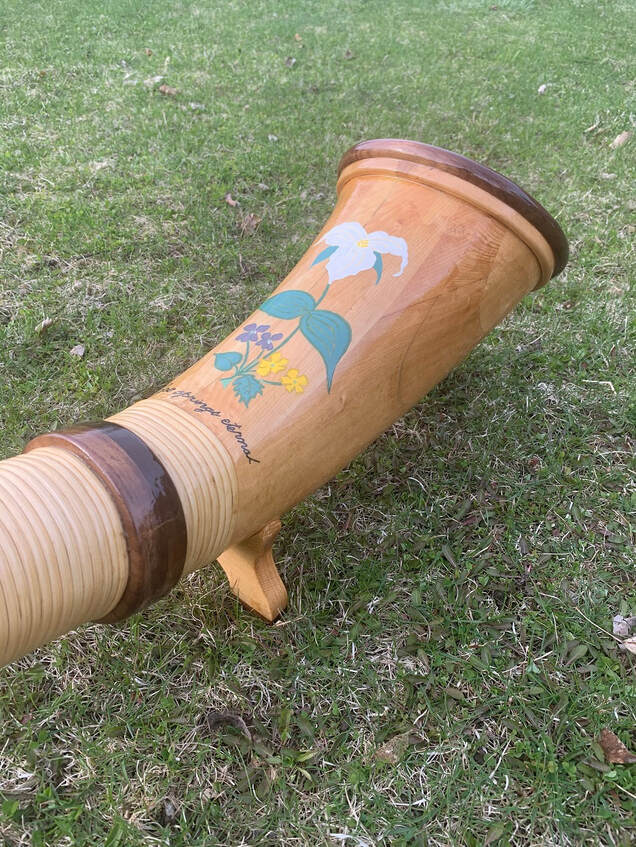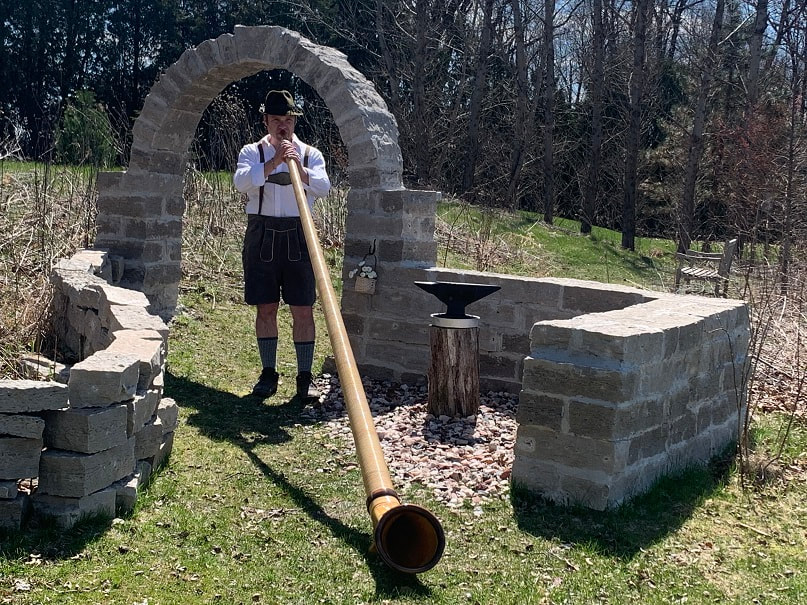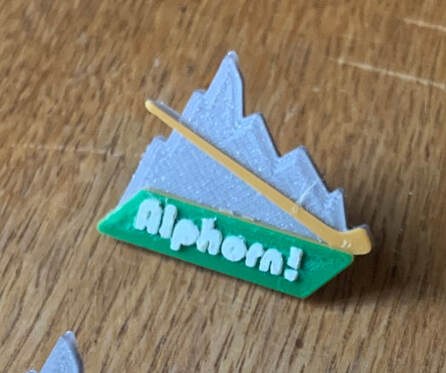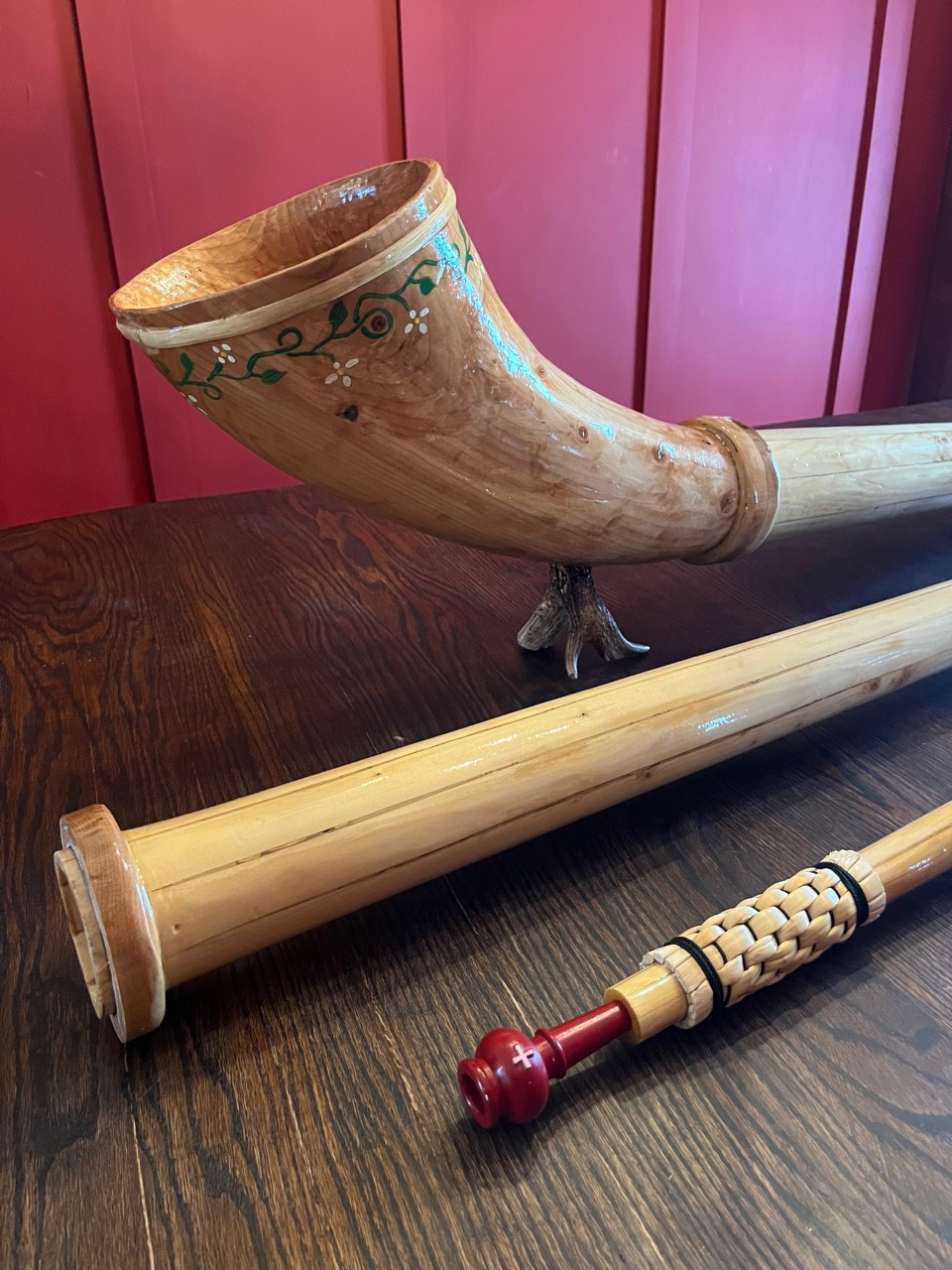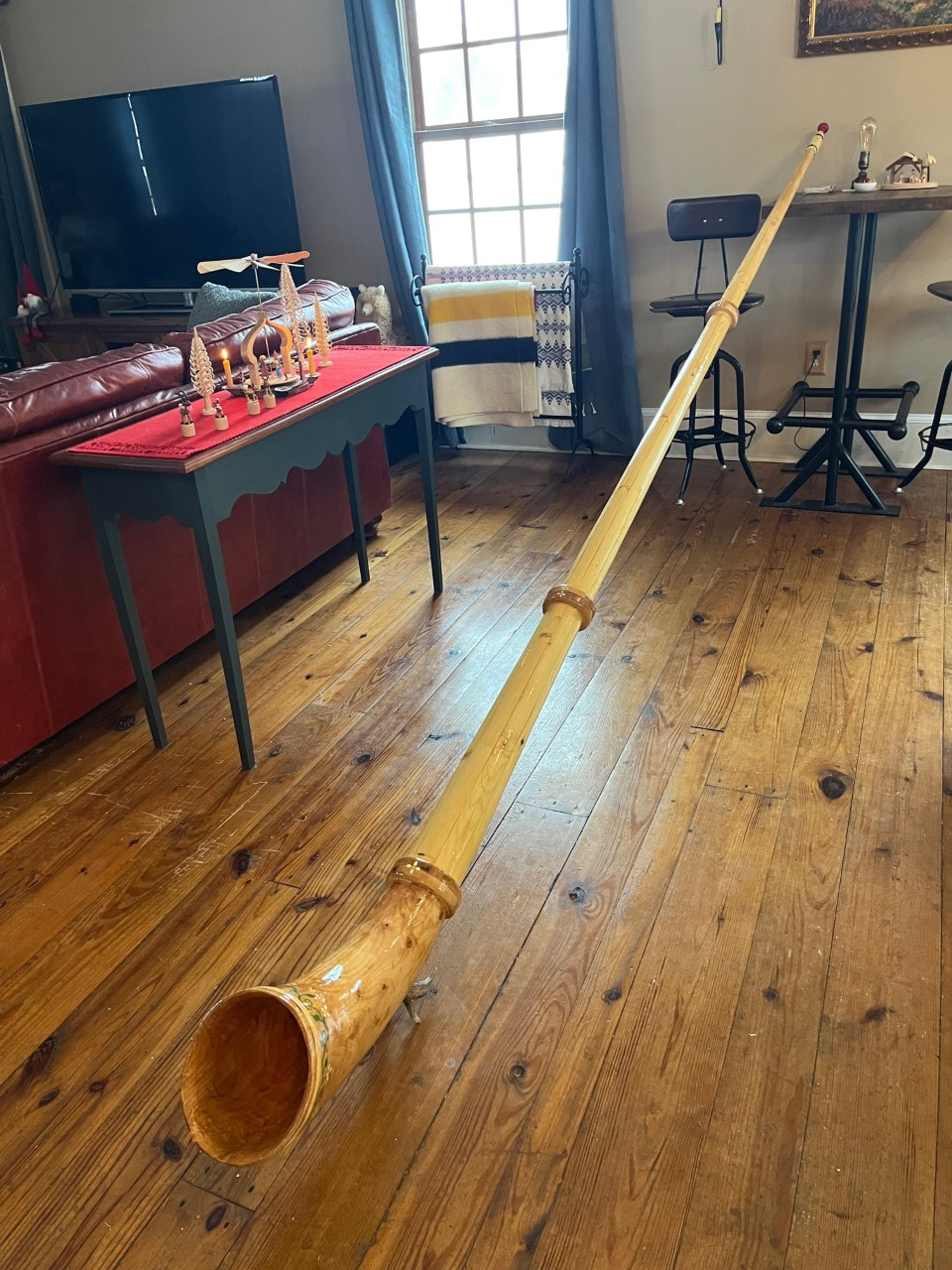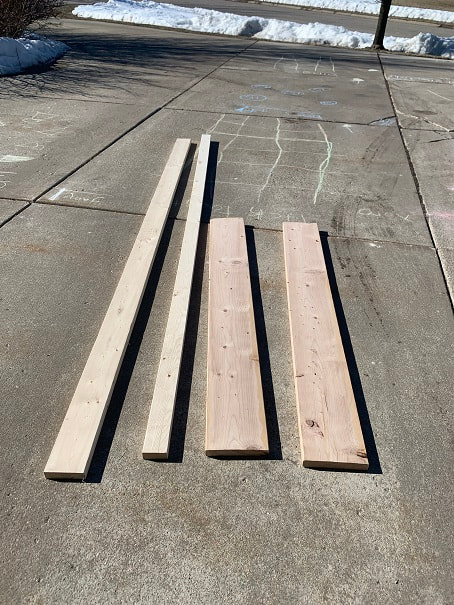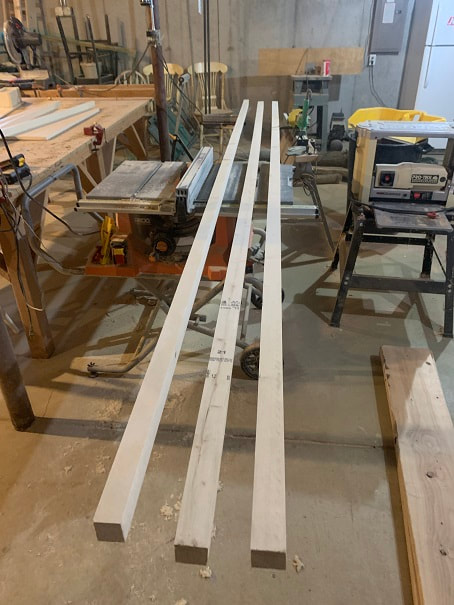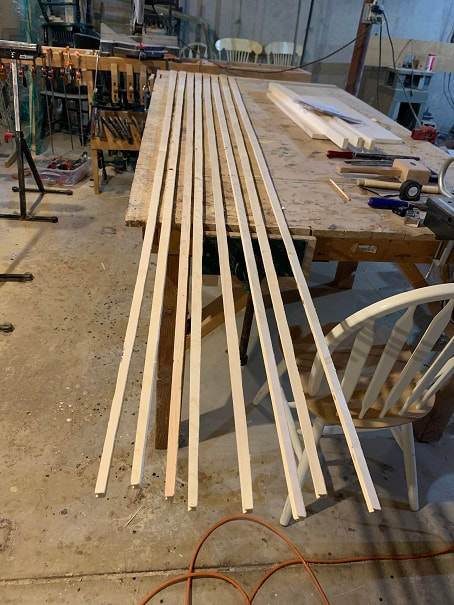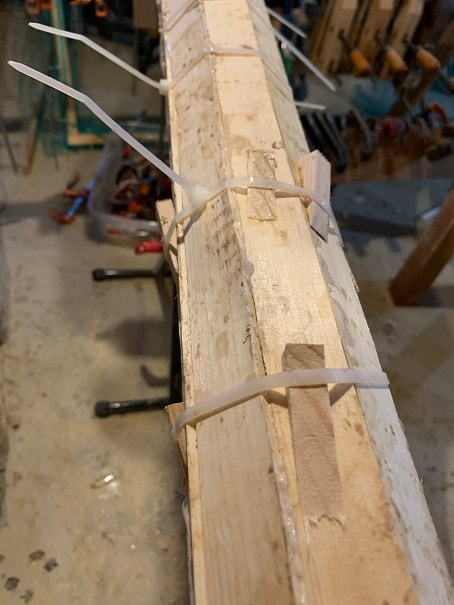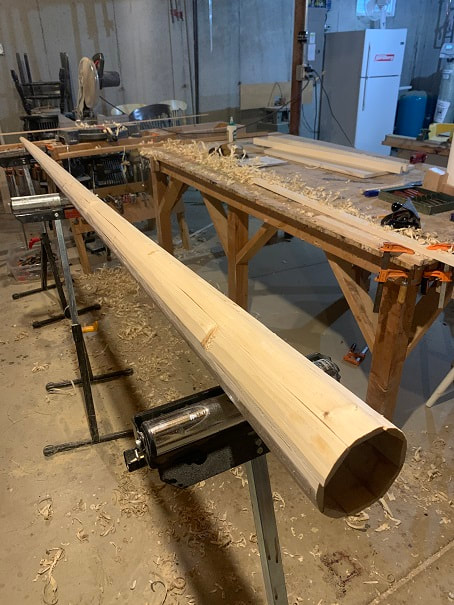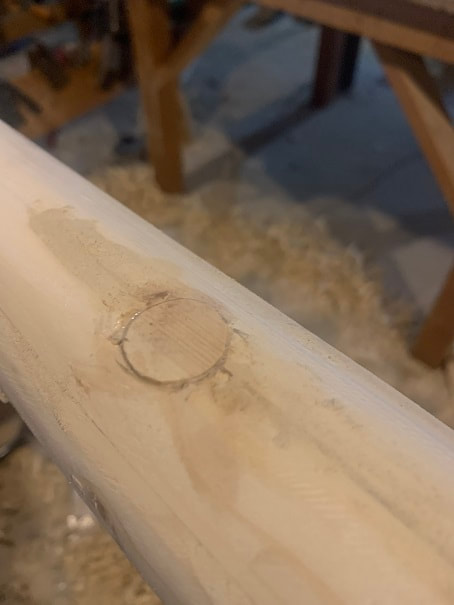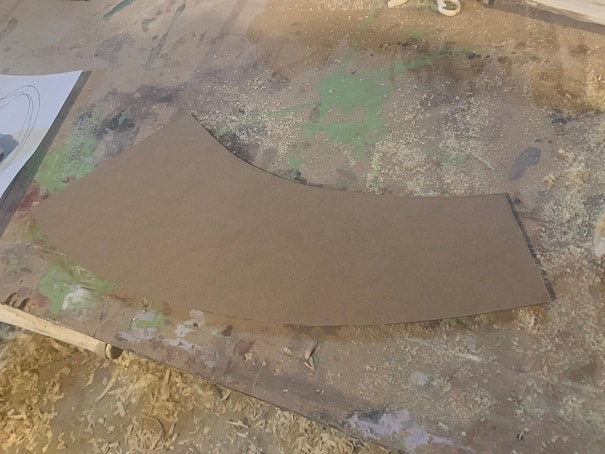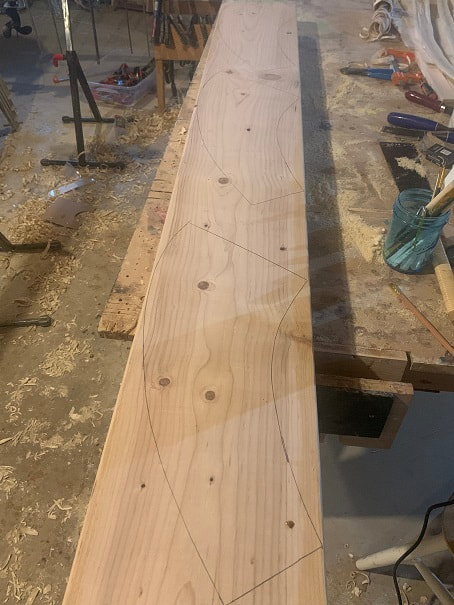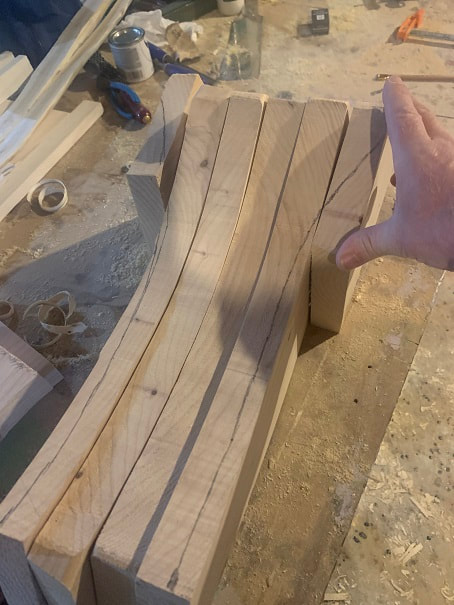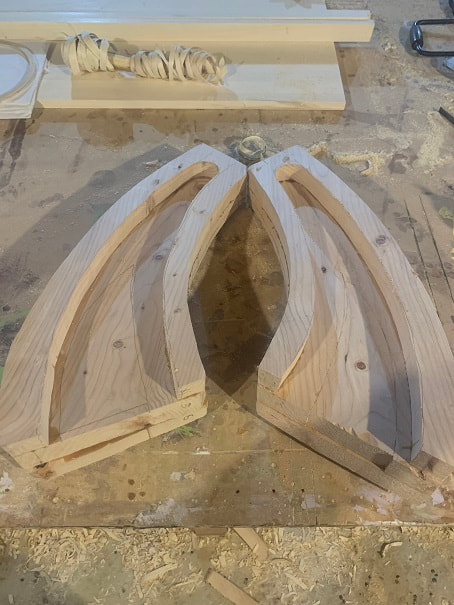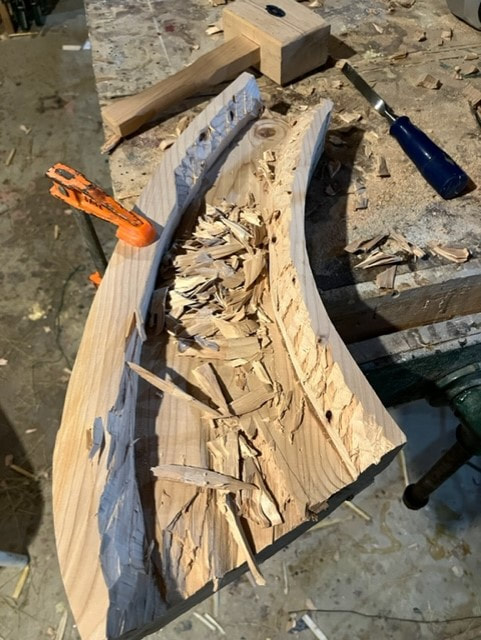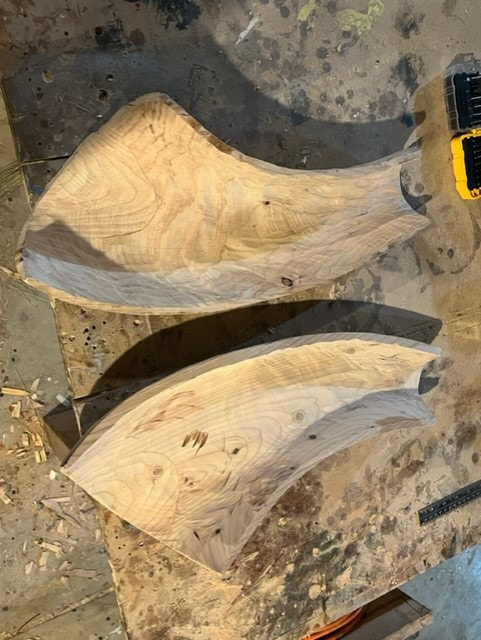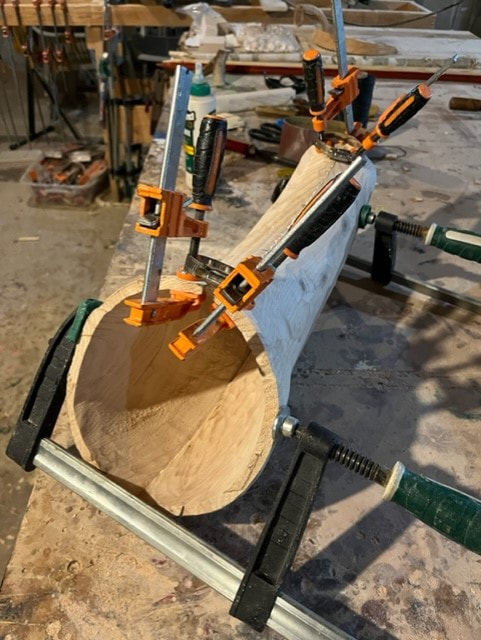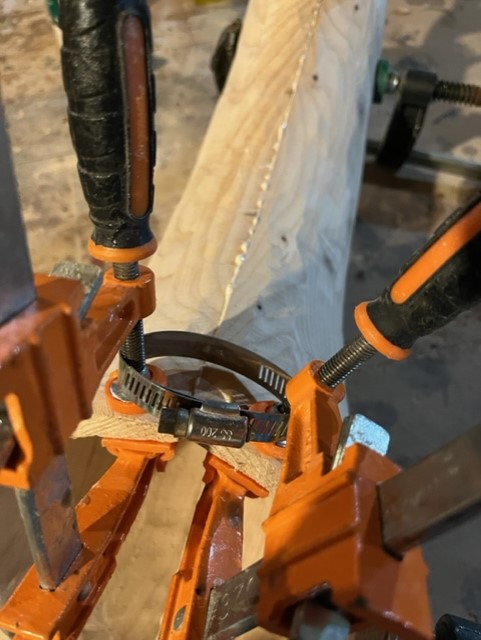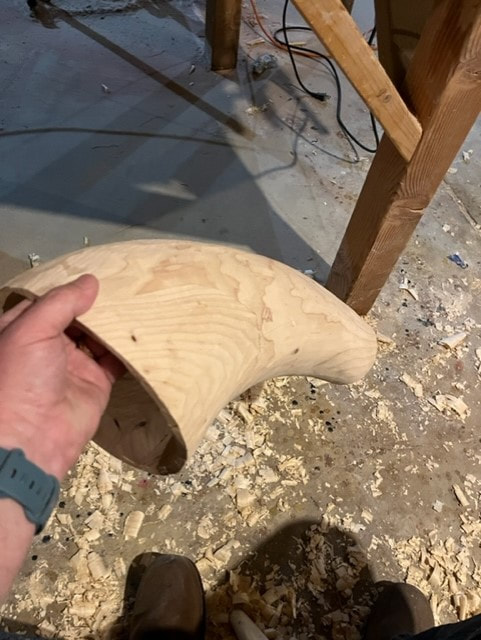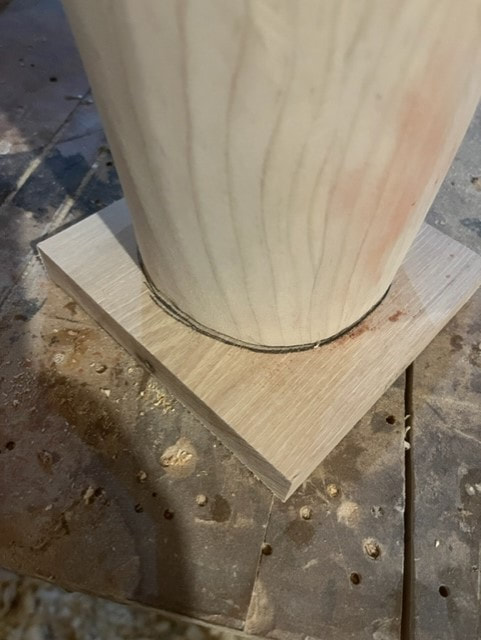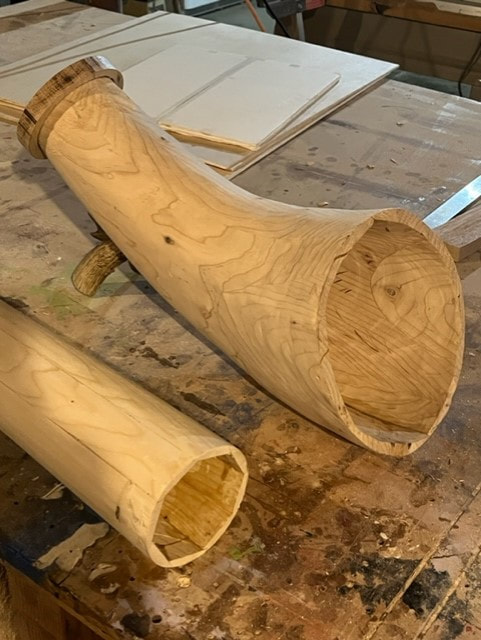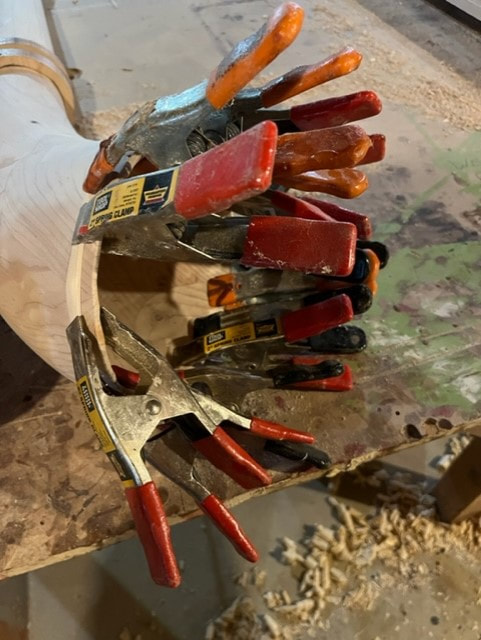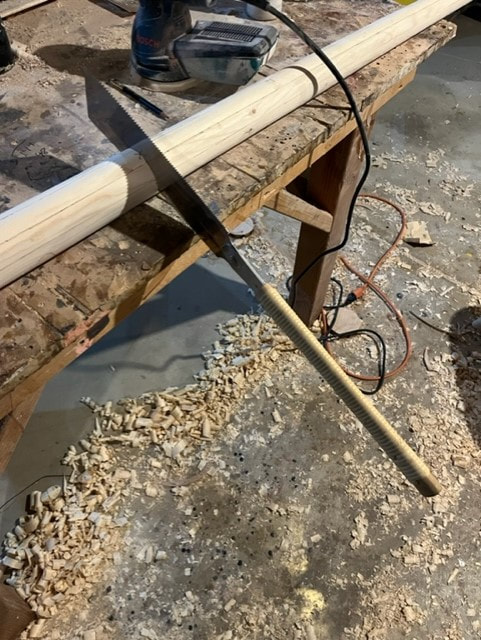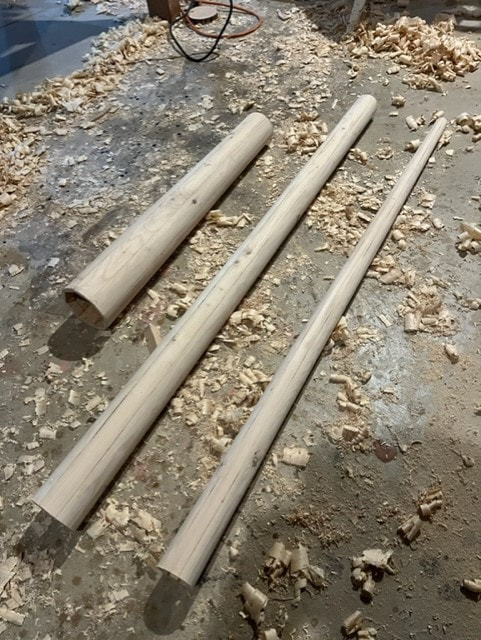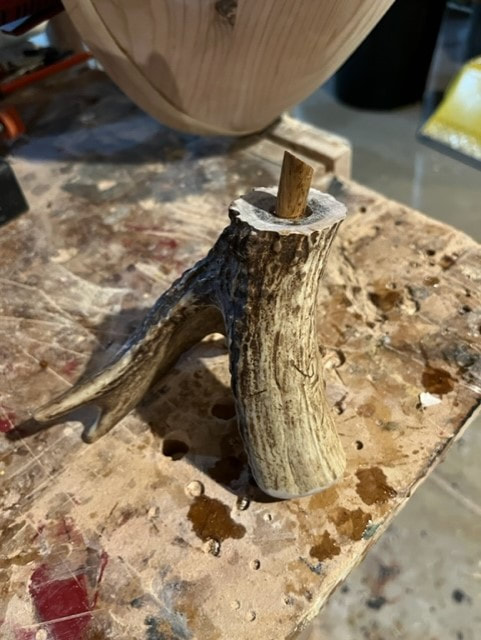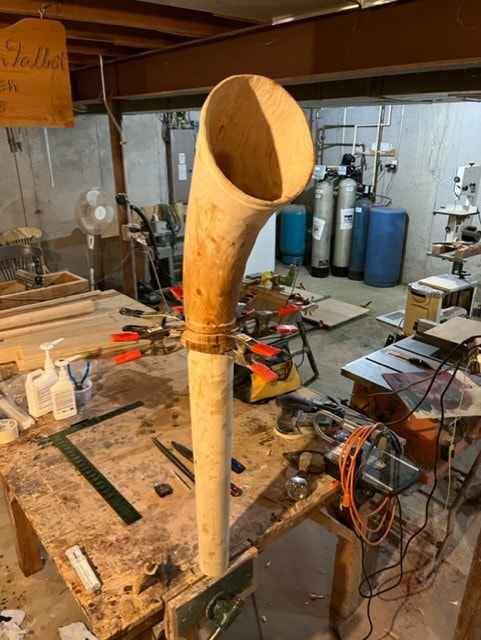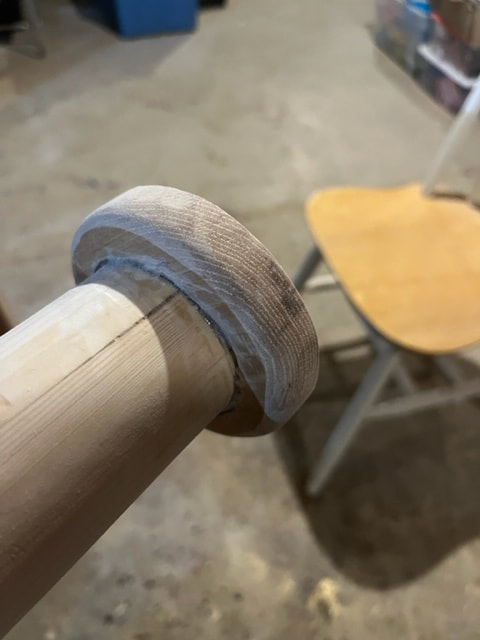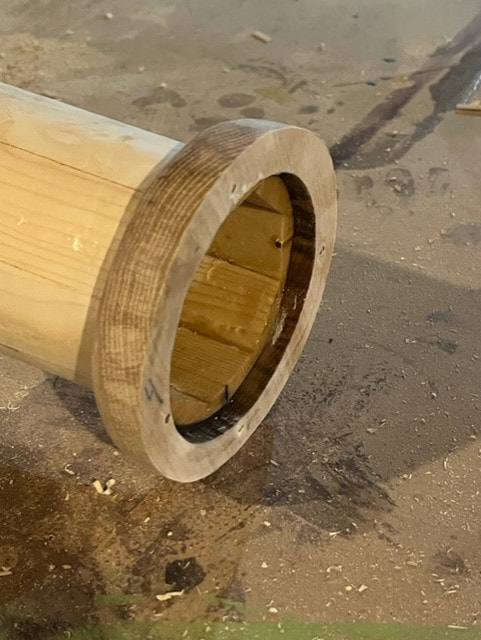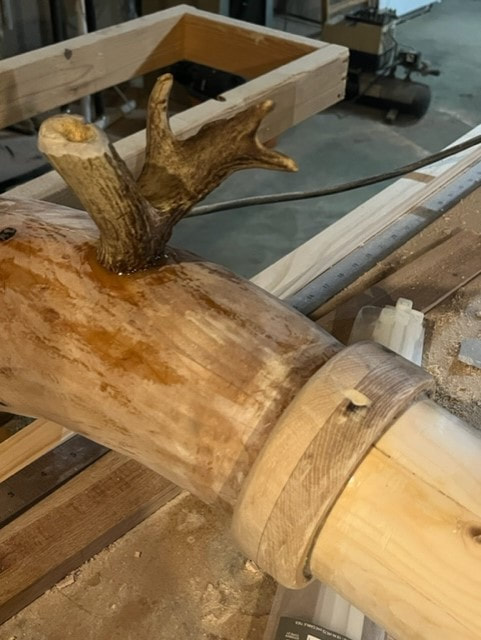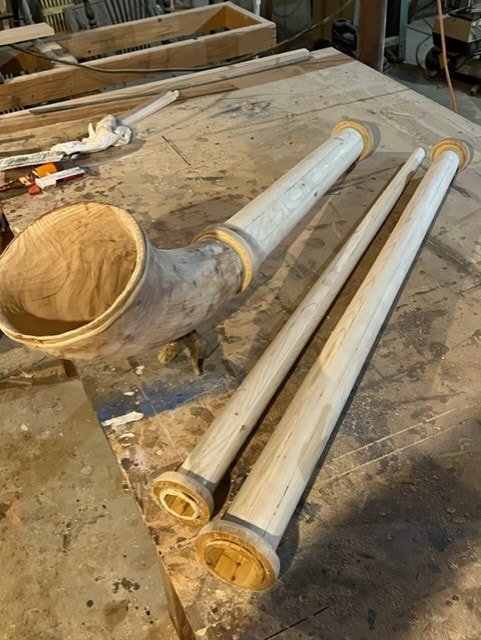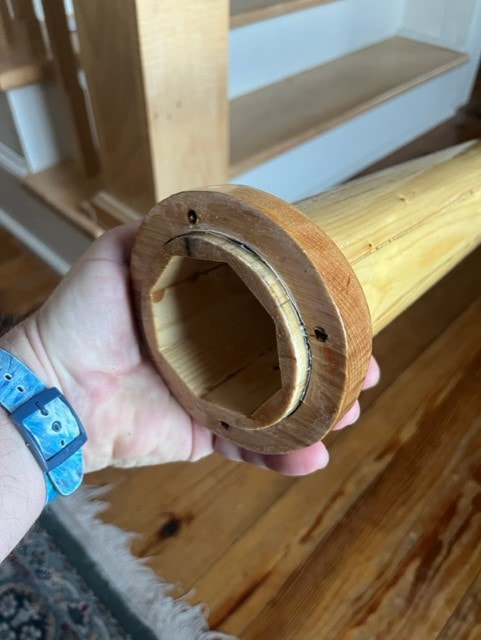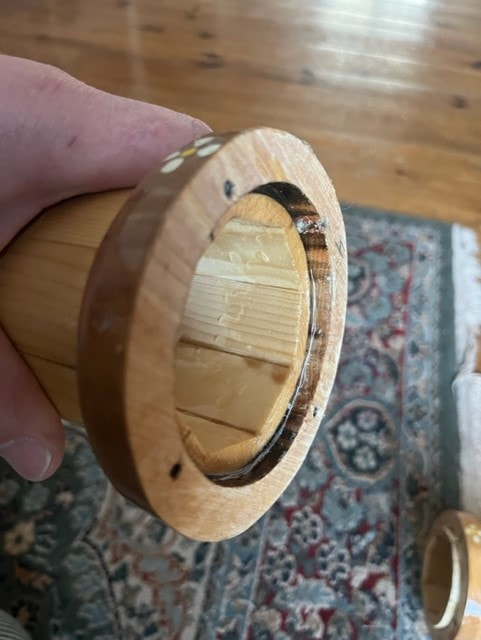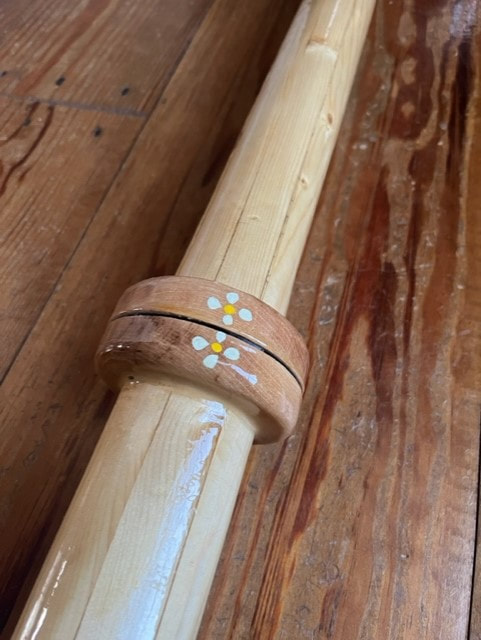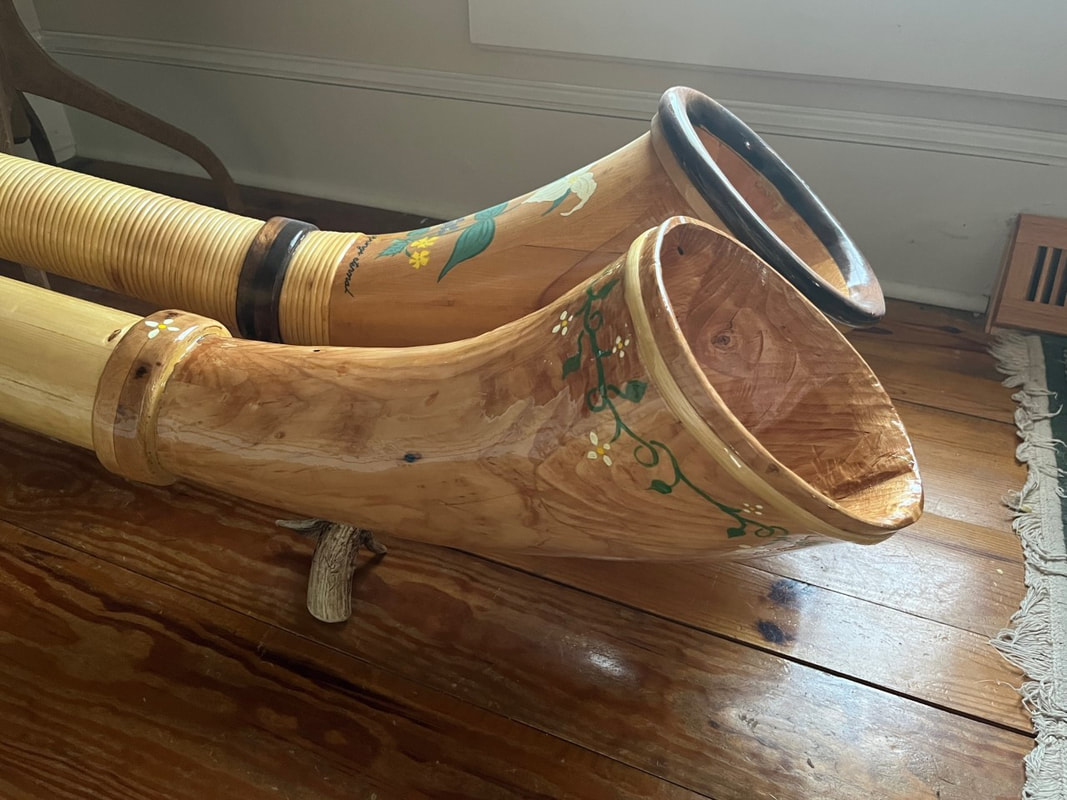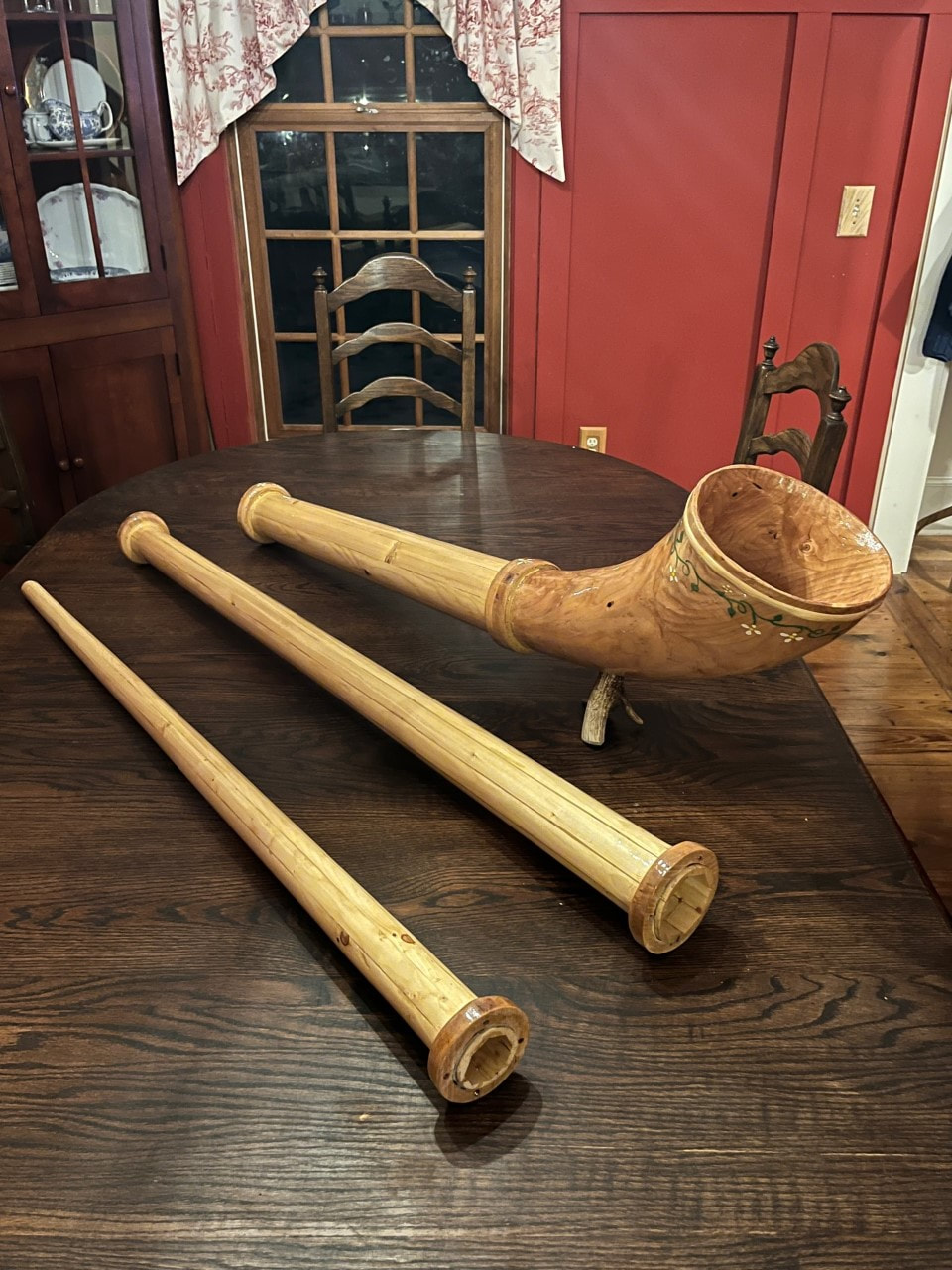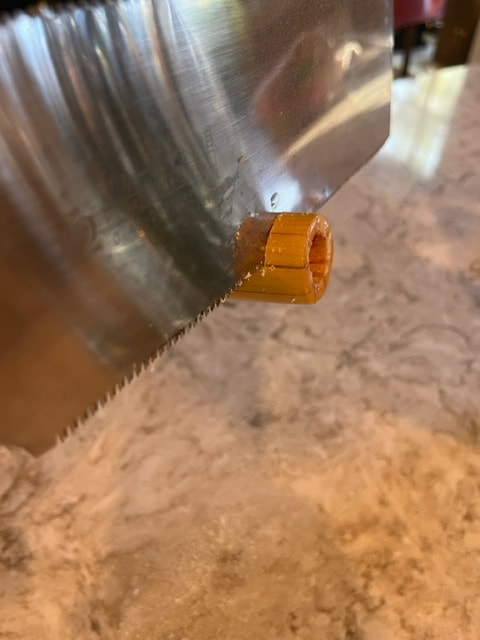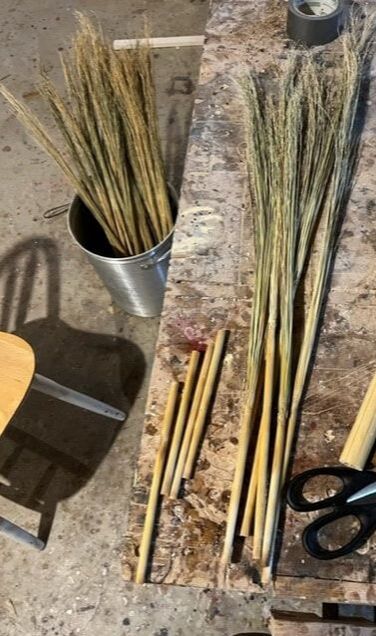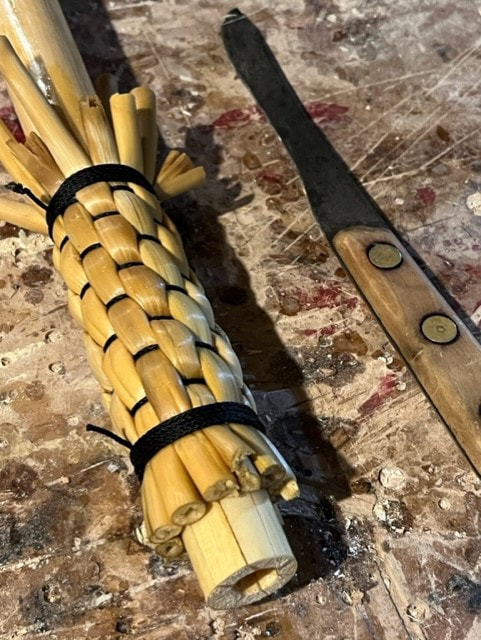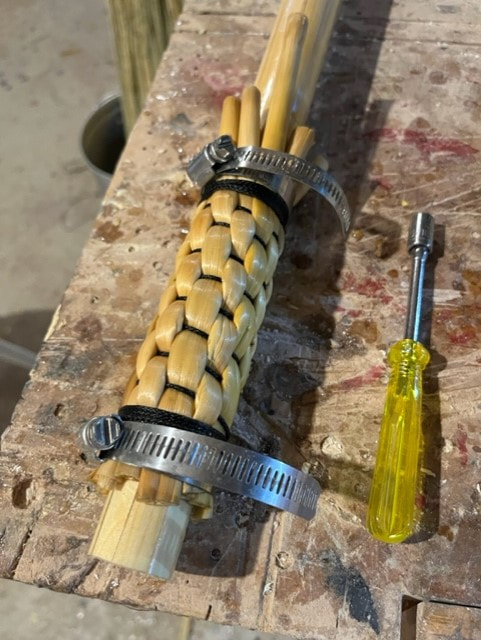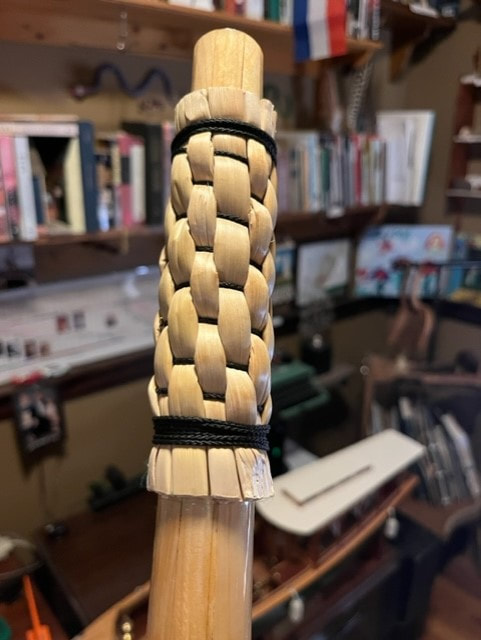“I sound my barbaric yawp over the rooftops of the world” , from Song of Myself by Walt Whitman.
Spring 2020:
Alphorns, also known as Alpine Horns or Alpenhorns, make a warm, rich, sonorous, mysterious sound; their history is old and married to the Alps. They are beautiful pieces of woodworking also. I wanted to play one, so I set out to build one. I built the Alphorns shown below in my workshop in Wisconsin, USA.
Page Contents:
1. Background information on Alphorns
2. Photos of my finished Alphorn
3. Alphorn and mouthpiece dimensional drawings
4. Build log of making alphorn mouthpieces
5. Complete build log of my first Alphorn. This Alphorn is made of Sitka Spruce, is a one-piece alphorn, and is fully wrapped with wooden reed wrapping.
6. Build log of my second alphorn. The intent of this 2nd alphorn was to build an alphorn from very inexpensive, readily available construction lumber, and also to build a lightweight horn that breaks down into 3 sections for easier transportation.
I am not a master Alphorn builder, so what follows is simply how I built my Alphorn. I found all the data I could on the internet, and also made my drawings by scaling from photographs. There are still master Alphornbuilders out there and the links below show some of them. These were helpful sites:
https://www.youtube.com/watch?v=UTyC7DfWeSo
https://www.youtube.com/watch?v=eGRhsmSiywc
https://www.nendazcordesalpes.ch/en/alphorn/the-making-of-an-alphorn
https://www.alphorn-neumann.com/alphorn.php
http://www.alphorn.ca/
http://www.flyby.ch/alphorn/geschi_e.htm
https://www.youtube.com/watch?v=UTyC7DfWeSo
https://www.youtube.com/watch?v=eGRhsmSiywc
https://www.nendazcordesalpes.ch/en/alphorn/the-making-of-an-alphorn
https://www.alphorn-neumann.com/alphorn.php
http://www.alphorn.ca/
http://www.flyby.ch/alphorn/geschi_e.htm
I decided to build an Alphorn tuned to F (approx. 373cm long or 12' - 3" long). The mouthpiece sizes seem to range from similar to a trombone mouthpiece on the large end, to similar to a French Horn mouthpiece on the smaller end. The smaller mouthpieces work better to play the melodies in the higher register. For reference the length of tubing in a trombone is about 9 feet. Regarding the shape of the Alphorn bell, I drew this from photos. I still had questions on the length of the main trunk of an alphorn, so I wrote an email to an Alphorn player, William Hopson, who gave me the great advice to build it a bit long and then trim it down to tune it. The drawings below are a result of my research.
Overview Video of the Construction of this Alphorn
Dimensional drawings and a detailed build log for this alphorn, may be found further down on this page.
A Brief History of Alphorns
These beautiful horns were built from spruce trees growing high in the Alps and were used by Alpine shepherds 2000 years ago to communicate with other people and to call grazing animals, and also to make music. Long ago, builders would choose a high mountain tree that grew out of a steep mountainside. After growing out from the mountainside, the tree would turn and grow vertically toward the sun, and the shape of the tree was used by the early builders of Alphorns to make the shape of the horn. The trees were split in half, carved out, the halves reattached, and the horn made. Alphorn playing declined in the late 1700's and early 1800's as they were needed less for communication. Efforts were made in Switzerland during the 1800's to promote the Alphorn due to its cultural significance, and the Alphorn has seen a resurgence in the last hundred and fifty years, and especially the last 40 years. They can be purchased online or at some stores, and there are Alphorn playing workshops and festivals in Europe and North America. It would seem that F is the most common pitch for alphorns in North America, while F# is common in Europe.
Alphorn Drawings by a Novice Alphorn Builder
Now then, onto the alphorn I will build. After all my research, I hand-drew the drawings for building an Alphorn to best match what I had learned. I am not an experienced Alphorn maker, and this design is my design not a design from an Alphorn master. The dimensions are as traditional as I could make them but the construction method I will use is not traditional. I will make my Alphorn tube using the birdsmouth joinery method used by shipbuilders to build ship masts. I used this method to build the Sitka Spruce mast on my sailboat. It is very strong joinery and I will use it to build my Alphorn. I believe that my method of building the bell and trunk of the alphorn, especially the birdsmouth construction technique will consume significantly less wood than gluing up solid blocks and hollowing them out, and will also allow me to make the trunk of the alphorn without specialty curved planes. You can make your own Alphorn!
Modern Alphorns available for purchase , come in three or four sections that one assembles into the Alphorn prior to playing it. This makes transporting the Alphorn much easier. Mine will be a one piece Alphorn!
These are decidedly European instruments, so I used the metric system in my drawings. I do not claim to be an authority on Alphorns, this is simply my documentation of the one that I built. In my notes below I use both metric and imperial notation, apologies for any confusion.
Feel free to use these drawings for building an Alphorn for your own use, contact [email protected] for permission to reproduce these drawings for any purpose other than building an Alphorn for your own use.
Modern Alphorns available for purchase , come in three or four sections that one assembles into the Alphorn prior to playing it. This makes transporting the Alphorn much easier. Mine will be a one piece Alphorn!
These are decidedly European instruments, so I used the metric system in my drawings. I do not claim to be an authority on Alphorns, this is simply my documentation of the one that I built. In my notes below I use both metric and imperial notation, apologies for any confusion.
Feel free to use these drawings for building an Alphorn for your own use, contact [email protected] for permission to reproduce these drawings for any purpose other than building an Alphorn for your own use.
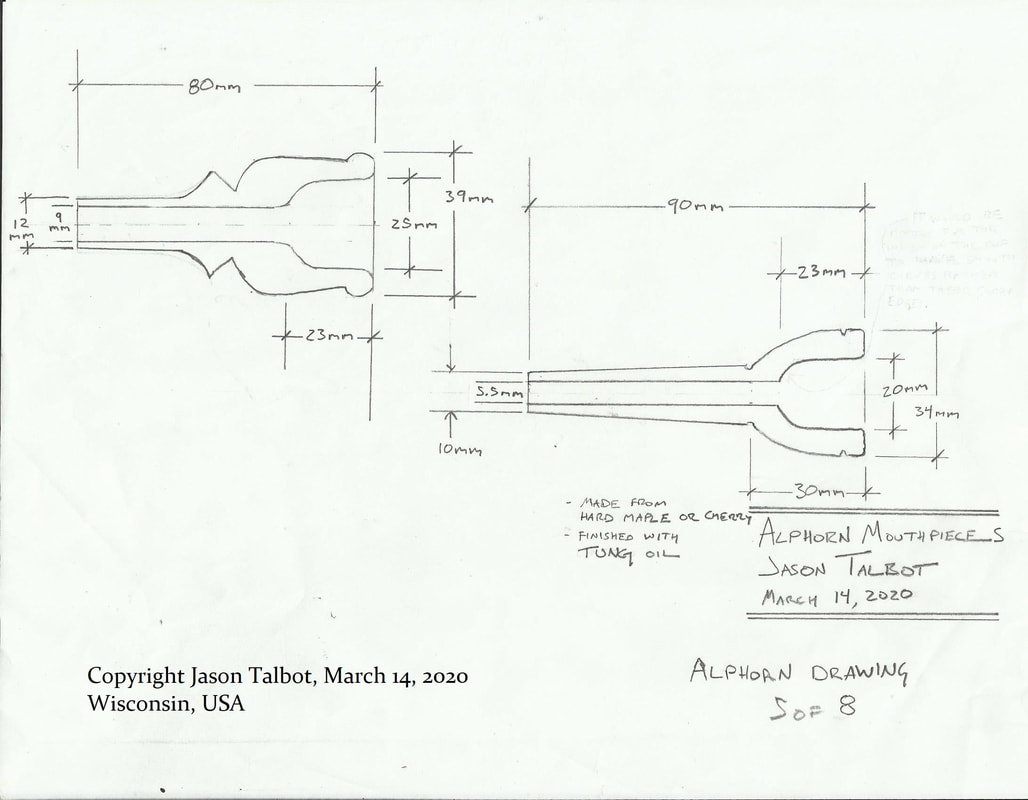
Alphorn mouthpiece dimensions. One can make an endless range of mouthpieces with varying cup diameters, cup depth, cup shape, rim width and shape, bore diameter and shape. The bore should reduce to around 3/16" at the base of the bowl, and then expand out to 5/16
or so at the discharge end of the mouthpiece, but with my tools, I am limited to straight bores when making the mouthpiece from wood. I have made three so far, all pictured further below on this page. Smaller diameter mouthpieces can help playing higher notes, and larger diameter mouthpieces can be better suited for lower notes.
See improved mouthpiece drawings below! Including tapered inner bore. I think the tapered inner bore plays better and sounds better.
MATERIALS: This Alphorn will be built from Sitka Spruce from the pacific northwest, hard maple from I tree I cut down years ago, and Black Walnut.
GLUE: I will use Titebond III glue for most of this project. In three places, I will use a 2-part epoxy: I will use two-part epoxy to glue the end rings to the bell, to glue the bell to the long trunk, and to glue the foot to the bell.
GLUE: I will use Titebond III glue for most of this project. In three places, I will use a 2-part epoxy: I will use two-part epoxy to glue the end rings to the bell, to glue the bell to the long trunk, and to glue the foot to the bell.
My guide to building an alphorn is below, but first, a section on making mouthpieces
Making an Alphorn Mouthpiece
I have been experimenting with making mouthpieces. I have made wooden ones from maple and cherry and have made 17mm, 18mm, 20mm, and 22mm 3D printed mouthpieces. 1st I will show some of the wooden ones I have made. These have straight internal bores, which I find do not play or sound as well as mouthpieces that have tapered internal bores as shown in the drawings above. I have purchased wooden mouthpieces that have tapered internal bores, and the 3D printed ones I make have tapered internal bores.
Here I will show examples of simple wooden mouthpieces and also plastic ones.
Here I will show examples of simple wooden mouthpieces and also plastic ones.
Maple is a traditional wood for the making of an Alpenhorn mouthpiece. I had cut down a hard maple that grew on my property in Thiensville, Wisconsin, about eighteen years ago, and I still had some sections of the trunk left. I made this mouthpiece from that tree.
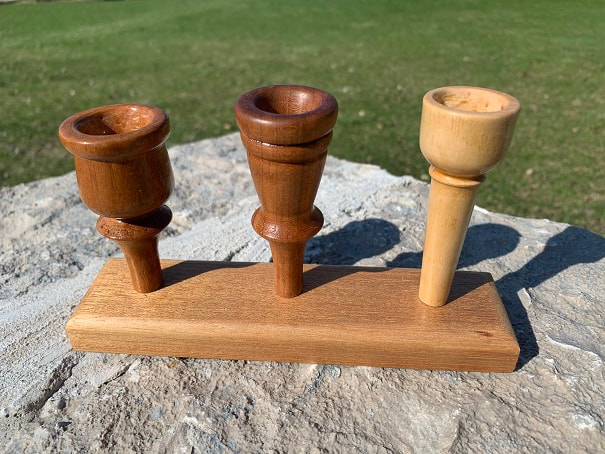
I have been experimenting with making and playing mouthpieces of different cup diameters, depth, internal shape, bore diameter, and rim width/shape. I have wound up so far with small, medium, and large versions of the mouth piece. Note that the outer shape of the cup does not reflect what the inner cup shape is....
Experimentation: 3D printed Alphorn Mouthpieces
Designed on Fusion360 and printed in PETG on a Prusa MK3 i3 3D printer. These are 100% solid PETG and feature tapered inner bores as shown in the drawings above.
Here are CAD .stl files for the 18mm and 20mm mouthpieces. When I open these in Fusion360, I find I need to scale them down by a factor of 0.1 in order for them to be the correct size (I am not sure why when I create an .stl file it changes the dimensions vs the original CAD file).
These are drawings are Copyright Jason Talbot Jan 2021. Please feel free to use them for making a mouthpiece for your own personal use, these drawings are not to be used for making mouthpieces for resale air any commercial purpose.
These are drawings are Copyright Jason Talbot Jan 2021. Please feel free to use them for making a mouthpiece for your own personal use, these drawings are not to be used for making mouthpieces for resale air any commercial purpose.
| talbot_18mm_alphorn_mouthpiece_v3.stl | |
| File Size: | 746 kb |
| File Type: | stl |
| talbot_20mm_alphorn_mouthpiece_v3.stl | |
| File Size: | 845 kb |
| File Type: | stl |
Below are two build logs of Alphorn projects.
1. The first is a Sitka Spruce Alphorn wrapped in wood reed. This is a one piece alphorn.
2. The second build log is for an Alphorn built out of low cost SPF (Spruce, Pine or Fir) construction lumber. This alphorn will not be wrapped in wood reed and will be cut into segments so that it can be disassembled.
Build Log 1 of 2: Making an Alphorn Out of Sitka Spruce and Wrapped with Wooden Reeds:
Sitka Spruce
Sitka Spruce is an amazingly clear and straight, vertical grained wood, with excellent strength-to-weight ratios. Due its high strength, low weight, straight grain, and minimal knots, Sitka Spruce is used for aircraft framework (including the Wright Flyer), sailboat masts, and it is also renowned for sound-quality in instruments.
The tree itself is awe-inspiring. I plane and carve and cut this wood with the utmost respect, and have only used it for making such transcendental things as sailboat masts and spars, and musical instruments. The Sitka Spruce grows in the Pacific Northwest of the USA and Canada. The Sitka Spruce is one of the few species on earth known to grow over 300 ft tall (over 90m). The forest of Sitka Spruce has been vastly diminished by logging, but on a positive note, it is considered a "species of least concern" regarding potential for extinction of the species. The largest of these trees were cut down in the past before the giants could be measured. The older trees do not even have branches on the lower 100 feet of the trunk. The Queets Spruce in Olympic National Park is 450 years old, and some Sitka Spruces are over 700 years old. All wood is special wood in its own way, and this also is very special wood.
The tree itself is awe-inspiring. I plane and carve and cut this wood with the utmost respect, and have only used it for making such transcendental things as sailboat masts and spars, and musical instruments. The Sitka Spruce grows in the Pacific Northwest of the USA and Canada. The Sitka Spruce is one of the few species on earth known to grow over 300 ft tall (over 90m). The forest of Sitka Spruce has been vastly diminished by logging, but on a positive note, it is considered a "species of least concern" regarding potential for extinction of the species. The largest of these trees were cut down in the past before the giants could be measured. The older trees do not even have branches on the lower 100 feet of the trunk. The Queets Spruce in Olympic National Park is 450 years old, and some Sitka Spruces are over 700 years old. All wood is special wood in its own way, and this also is very special wood.
....and so, somberly, we reach the part where the tree (not necessary the tree in the picture) has been chopped down and milled into lumber for our use. I will turn this into an Alphorn, which is a noble end. I wish I could be of such a fine use after I bite the dust. I would be happy to return to the soil, and to do as Whitman suggests: from Leaves of Grass: "I bequeath myself to the dirt to grow from the grass I love, If you want me again look for me under your boot-soles." All trees are special, and these Spruce are special even amongst all trees; I will make the most of the wood.
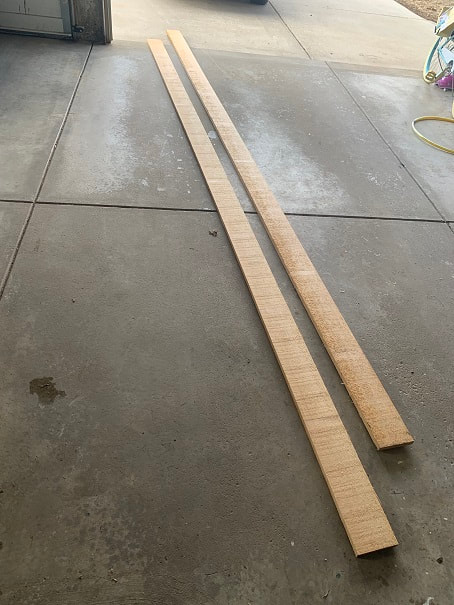
Two 4/4 x 6 x 17' rough sawn Sitka Spruce boards from McCormick Lumber in Madison Wisconsin. Dimensions are 1.0" x 6" x 17'. These are perfectly straight, straight and vertical grained board with no knots. I built the alphorn from these two boards, plus a 4/4 x 6" x 7foot board I had in the basement, at the end of the project I was left with a 4/4 x 4 x 8 foot piece of Sitka Spruce remaining from this raw material.
Making the Alpenhorn Bell
The bell will be built of Sitka spruce from laminated sections as shown below. After gluing the pieces together, I will carve them to round.
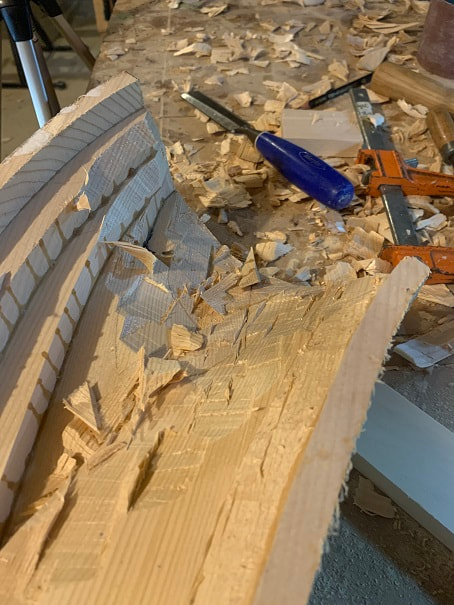
I have left the OD uncarved as I carve out the ID, in attempt to maintain strength of the wood as I chisel away from the ID. The strength of the chisel blows will surprise a person, as this Sitka is strong. WATCH THE TREE GROWTH LINES and understand that that woods splits along the grain. After a short time carving, a person will understad this and use it to their benefit. I am using my straight chisels for almost all of this carving because straight chisels are soooo much easier to sharpen. As I get closer to the finished ID I will use my curved chisel.
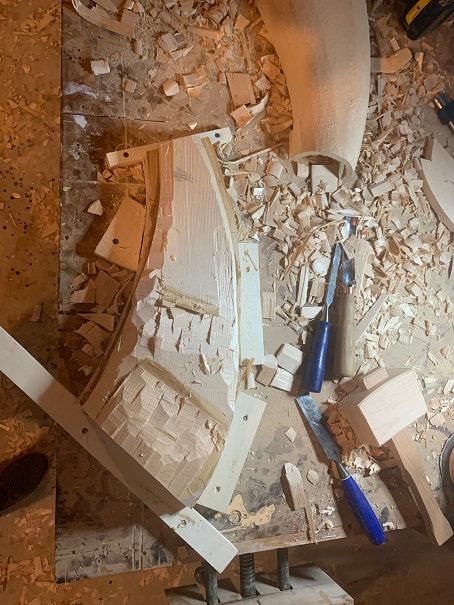
Now I will start carving the outside of the other half. One tricky aspect of carving this bell is holding it tight so that it doesn’t move as one carves it. Note the support blocks that I have screwed into the work table. After implementing this method of securing the workpiece, the carving became more efficient.
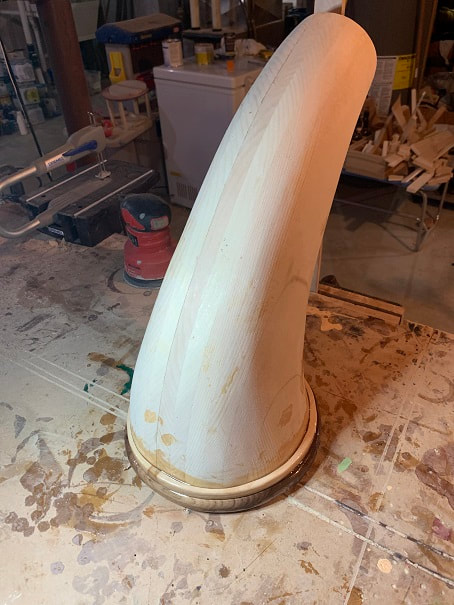
I used a two part epoxy to glue the rings to the bell and to each other. It's tough to see in the photo but the small end of the bell is resting up against a wooden brace to hold it in alignment so that the big face of the bell is laying flat on the ring. Be sure to wear latex gloves when working with epoxy.
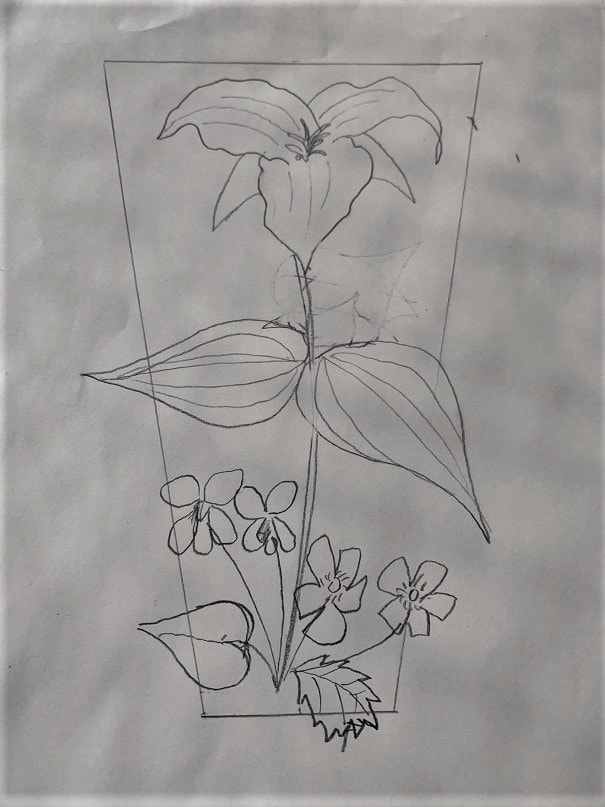
I measured out the approximate size of the space available for artowork on the top of the bell, and arrived at approx 8" Long x 2" at the narrow end x 5" at the wide end. I sketched out that area on a piece of paper and then sketched out the floral theme I will use. I drew springtime wildflowers that are native to my home here in Wisconsin; from left to right: Wood Violets, Trillium, and Buttercups.
Making the long trunk of the Alpenhorn
I built the long trunk (not sure the correct terminology for the long tube of the Alpenhorn, but I am calling it a trunk) of the Alphorn from Sitka Spruce, using the Birdsmouth construction technique, as shown in the drawings above. Here's how I did it.
IMPORTANT NOTE: I made the trunk of the Alphorn 6" (15.24cm) LONGER than shown on the drawing. The extra length was added to the mouthpiece end of the trunk. If I would have added the extra length to the bell-end of the trunk, the diameter would not have been correct where it meets the bell. I will trim the length of the mouthpiece end later when the horn is assembled in an attempt to tune the horn to F, hopefully this works.
IMPORTANT NOTE: I made the trunk of the Alphorn 6" (15.24cm) LONGER than shown on the drawing. The extra length was added to the mouthpiece end of the trunk. If I would have added the extra length to the bell-end of the trunk, the diameter would not have been correct where it meets the bell. I will trim the length of the mouthpiece end later when the horn is assembled in an attempt to tune the horn to F, hopefully this works.
Be attentive not to make the staves to big or too small. The dimensions in the drawing are exact; if your staves are a bit to big the inner bore of your alphorn will be to big. Double check and dry fit your staves and you can shave them a bit smaller if needed.
NOW, dry fit the staves together and hold them together with zip ties. Check that the OD of the assembled staves is correct. You can still shave down the staves at this point to reduce the OD, but you cannot make it bigger.
Attaching the Bell to the Trunk
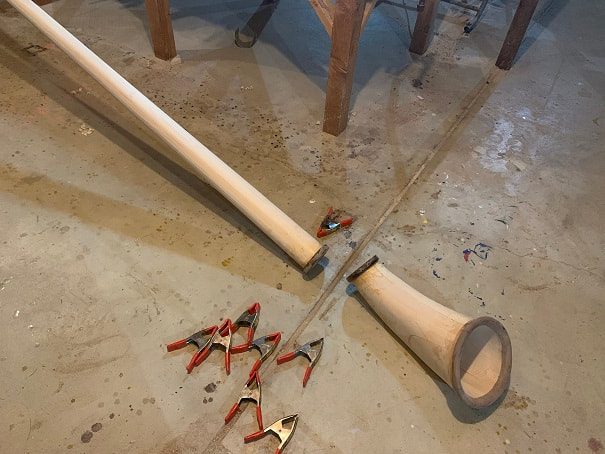
I let the epoxy on the flanges cure for about an hour. At that point it was well set but not at all fully cured. This was the point I wanted to glue the trunk to the bell, as I will get a good chemical epoxy bond on all faces of the epoxied joint. I gathered up a bunch of spring clamps. See the plastic covers on the jaws of the spring clamps? Take those off beforehand....they were too slippery and kept allowing the clamps to slip off, so I had to remove them in a hurry during the glue-up.
Tuning an Alphorn
I decided to make an Alphorn tuned to F. F# is also popular, but when listening to most Alphorn tunes on youtube, it seemed most were tuned to F. The only way to tune an Alphorn is to make it longer or shorter. One can lower to tuned-pitch of an alphorn by inserted an extender into the mouthpiece bore and then inserting your mouthpiece into the extender. To my knowledge there is not a way to make the tuned pitch of an alphorn higher, other than by cutting it down to a shorter length. When one plays an alphorn, the variation in pitch comes from the embouchure and frequency of vibration and airflow created by the players mouth and lungs, but the natural tuned pitch of the instrument is set by the maker during tuning, by cutting it to length. For this reason, the instrument is made a bit longer than needed so that it can be trimmed down in length to tune it.
I was curious if the pitch would be changed by attaching the bell (I assume the extra length of the bell will lower the pitch a bit), so after the trunk was glued up, I took it outside and played just the trunk. I used a digital tuner and found the trunk itself played a G! So as it stood the horn is only one step high with just the trunk. This made me nervous, as making the tune lower would require adding length which I cannot do. After I attach the bell, I will play it again and hope that the addition of the bell lowers the overall pitch by a at least a whole note.
Well, I attached the bell and it made the Alphorn one full note lower in pitch, I was very glad for this. I trimmed an inch (2.54cm) to get it to an F.
Digital tuner apps can be downloaded for free on your phone, or one can purchase a digital tuner from a music store, or one could use a pitch-pipe or a tuning fork to create the pitch of F. I used an app that I already had on my phone. Here are the screen captures from three octaves of F on my Alphorn (from high F to low F). The lowest F is a bit low.
The Mouthpiece-End-Ring, the Foot, and Wrapping the Alphorn with Rattan
Next, I used a bandsaw to trim the OD of the ring to about 44mm. I forgot to get a photo of that step.
The foot of the Alphorn
The Alphorn is fitted with a small foot on the bottom of the bell, which lifts the horn out of the grass to protect the bell and make sure the sound can exit the horn unobstructed from low ground cover.
Wrapping the Alphorn with Wood Reed
I will wrap the trunk of my Alphorn with 1/4" half oval basket reed. This fibrous material is very strong in tension. Many aspects of building an alphorn were new for me, including this wrapping step. It took much longer that I expected; keeping the joints nice and tight prevented me from just spinning the trunk quickly, and many, many reeds and clamping was needed, as each reed only gets about 4-10" of coverage down the barrel of the Alphorn.
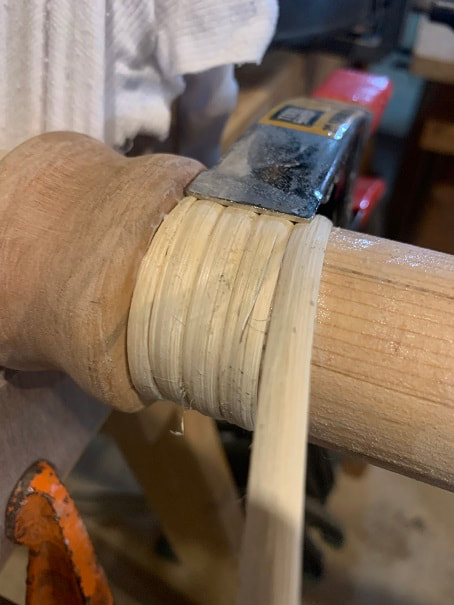
I started wrapping the Alphorn trunk at the mouthpiece end, just down from the hardwood ring. Notice where the wrapping just starts on the left that I carved a long taper into the reed to start the wrap. I glued and clamped this down with a spring clamp and started wrapping. I watered down Titebond III glue applied it to the OD with a toothbrush prior to wrapping on the rattan. I applied about 5” of glue at a time. I don't want messy blobs of glue squeezing out onto the OD of these wraps, It would be a nightmare to try an sand the outside of these wraps while maintaining their curved profile. The watered down glue has worked perfect.
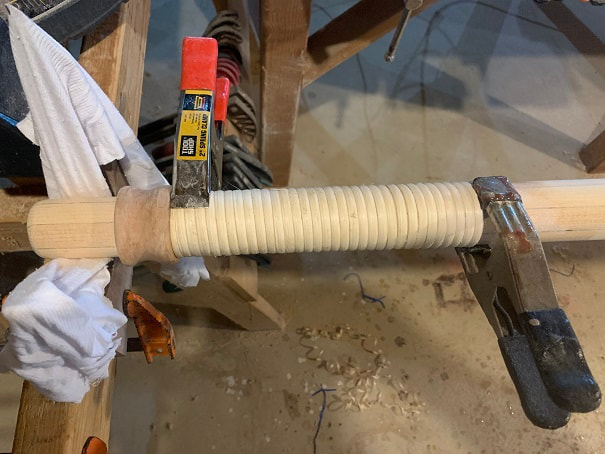
This is a photo of a 14 foot (430cm) length of reed wrapped around the narrow end of the Alpenhorn. As the diameter gets larger the horizontal coverage of each length of rattan will decrease. One learns many things building an Alphorn, and one of those things is just how many splices of reed wrapping it takes to wrap an Alphorn.
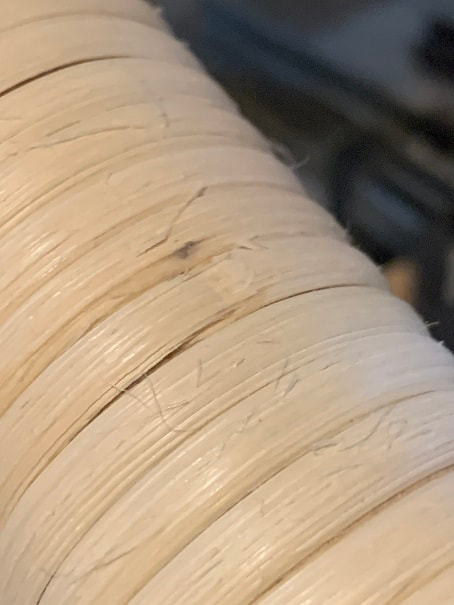
For the splice I taper down the reed from the top of the reed to the bottom on both pieces to be joined, then I use Titebond III (not watered down for the 1st inch of the wrap, and clamp the splice joint for an hour before unclamping. In the middle of this photo you can see a splice of the reeds. There will be more of these than I thought, as each reed only gets you 6-10" of distance along the horn length. I am locating all the splice joints on the bottom of the Alphorn trunk.
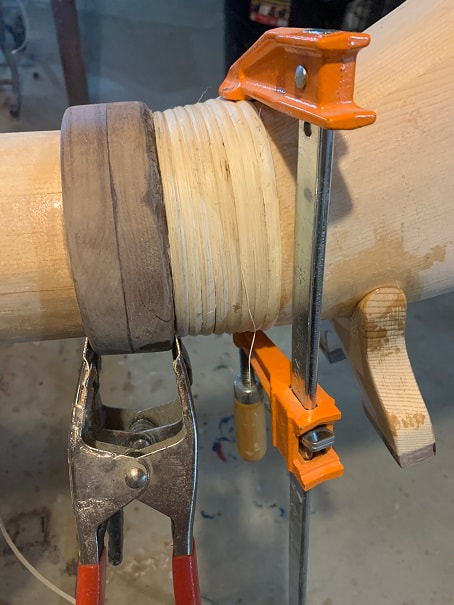
I saw some horns with a short section of wrapping on the small end of the bell, and I liked the look of that, so I did that. The spring clamps at the bottom of the picture are not being used to clamp the walnut flanges together, they are being used to press the narrow leading edge of tapered rattan wrapping against the trunk to keep it from moving. I located the end of the wrapping on the bottom of the bell where it will not be seen.
Varnishing the Alphorn
The outside of the Alphorn will be varnished, along with the inside of the bell as far as I can reach. The ID of the bore will be soaked with Danish Oil later.
- I did I final sanding of the Alpenhorn prior to applying finishes.
- First , II cleared out the whole area and cleared off the table top. Then I blew out the bore of the alphorn with an air-compressor
- Then I brushed off the table and swept the floor.
- With all that dust kicked up into the air I waited half and hour for it to settle and came back and vacuumed off the table top and the alphorn itself, including as far into the bell as I could reach.
I sanded the Alphorn lightly, and then vacuumed the dust away, between coats.
Painting an Alphorn Bell
Painting onto bare wood can be messy, and the paint can wick into the wood beyond where the painter wishes the paint to go. I started painting the bell after four coats of varnish, and after painting I will apply further coats of varnish over the paint.
When I am done painting the bell, I will apply two more coats of spar varnish.
Oiling the interior of the Alpenhorn
I flooded the interior of the Alphorn with penetrating wood oil. The goal is to protect the interior of the horn from moisture.
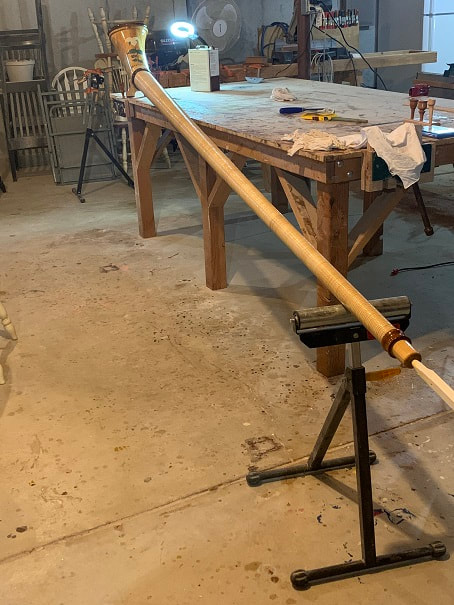
Here the Alphorn has been filled with 1 gallon penetrating wood oil. I turned the horn over and sloshed the oil all around inside. 1 gallon is not enough to actually fill the horn so one needs to rotate it around in order to get good internal coverage. I then removed the bung and poured the oil out the mouthpiece end.
Photos of the Finished Alphorn
The 2nd Alphorn Build Log is below, but first, check out this 3D printed Alphorn pin! The .STL file may be found on my 3D Printing Gallery.
Build Log 2 of 2: Making an Alphorn from Common Spruce/Pine/Fir Construction Lumber
March 2021
Alphorns were originally instruments of working farmers. These were not the high-brow instruments played in royal chambers or national opera houses (though they are now!, which is great). In this spirit, I set out to make a lower-cost alphorn from humble construction lumber. My first alphorn is wrapped in wood reed and also cannot be disassembled. I am building this pine alphorn with the intent of creating a lightweight and portable Alphorn, so I will not wrap it and I will chop it into segments that can be disassembled for transportation.
This alphorn will be built using similar construction methods, and to the same dimensions, as the Alphorn above. In light of that, I will not duplicate all the detail in the build log above. This 2nd build log will be shorter and will only include detail on new construction details such as the segment joints.
Alphorns were originally instruments of working farmers. These were not the high-brow instruments played in royal chambers or national opera houses (though they are now!, which is great). In this spirit, I set out to make a lower-cost alphorn from humble construction lumber. My first alphorn is wrapped in wood reed and also cannot be disassembled. I am building this pine alphorn with the intent of creating a lightweight and portable Alphorn, so I will not wrap it and I will chop it into segments that can be disassembled for transportation.
This alphorn will be built using similar construction methods, and to the same dimensions, as the Alphorn above. In light of that, I will not duplicate all the detail in the build log above. This 2nd build log will be shorter and will only include detail on new construction details such as the segment joints.
RAW MATERIALS FOR THIS ALPHORN: I will use "SPF" construction lumber for this build. This stands for "Spruce Pine or Fir" and can be any of those woods. These are construction lumber and have a knots. I took time and picked the very best boards I could find in the pile. The 2x4 and 2x6 at the store were pine and the 2x10s were fir. This lumber cost $59.00 including tax.
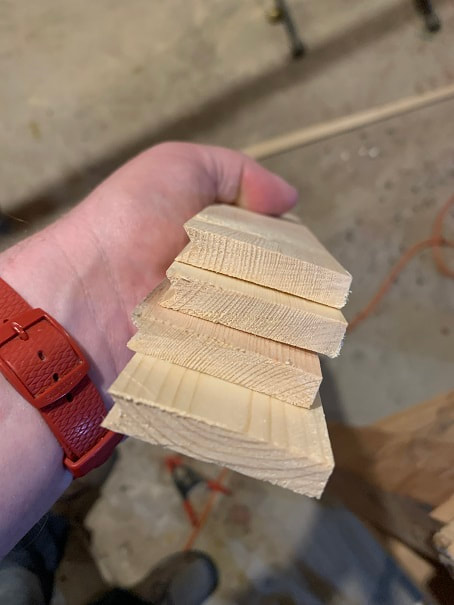
I cut the staves blanks with the grain in mind, to wind up with staves with as vertical a grain as possible. Orient your cuts to achieve this. Here you can see that I got a decently vertical grain, though in the stave on the bottom the grain is not as good. I find that the last couple inches of the birdsmouth cut can waver a bit, and these imperfect birdsmouth ends can be seen in this photo. I cut of a bit of both ends off when cutting the stave to length to remove these imperfect ends.
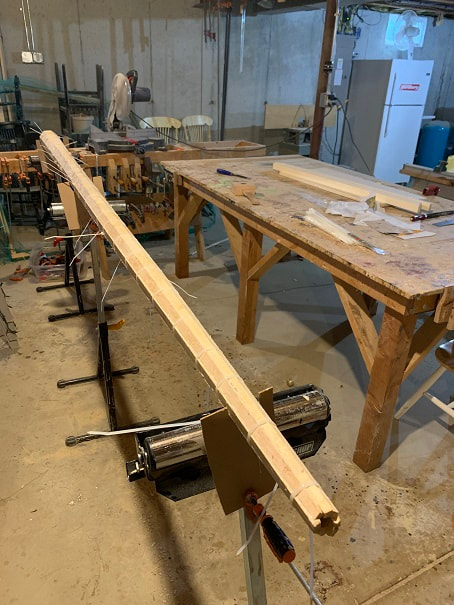
Glued up birdsmouth joinery Alphorn trunk. This photo is deceiving I as there is actually more taper to the trunk than what appears in the photo, this is due to the small end being so close to the camera making it look bigger, vs the big end which is far away making it look smaller. The pieces went together well. It is always a messy affair assembling these and it is tricky. Be determined and work deliberately and don't give up if the pieces flop and fall around. I did this solo, but if it is your first time assembling one, you might benefit from a second person helping. It is a bit hectic as the glue is drying. I started at the big end, got the joints in place, quickly threw on a zip tie, and then worked my way down to the skinny end with a zip tie every foot. Then I came back and added additional zip ties every 6 inches.
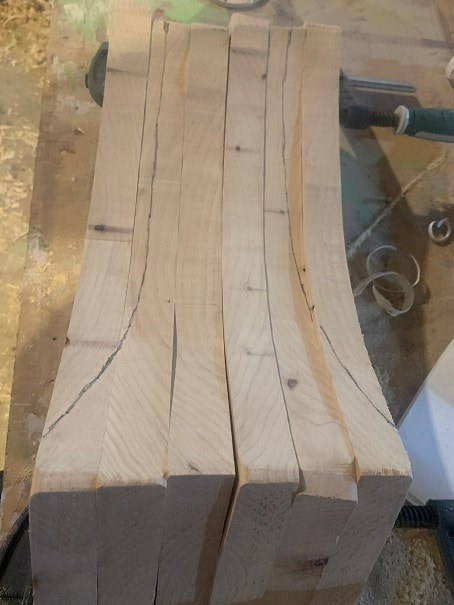
I planed down both sides of each 2x10 on my surface planer to flatten out the construction lumber. There's only a little that can be planed off before the pieces will get too thin to make the full OD of the bell, but planing them will help flatted them out for a good glue bond. This picture is after planing, and also after I sketched the plan-view shape of the bell onto the pieces.
November 2022 update: I took a year and a half off of working on this project, but I am back at it!!! Started carving the bell last month and today got it glued up.
Next I used epoxy glue to glue solid Hickory flanges around the outer diameters of the bell and adjacent trunk piece. Once those cured, I then glued them together to attach the bell to the trunk.
How to tune an Alphorn!
How to tune an Alphorn:
1. Build the Alphorn a bit too long
2. Get a tuner and tune it to F or F# depending on your preference, by carefully cutting the the mouthpiece end of the horn shorter and shorter till it is in tune. Shortening the horn brings the pitch higher. The only way to lower the pitch is to make the horn longer, which is hard to do, so be careful with this step.
1. Build the Alphorn a bit too long
2. Get a tuner and tune it to F or F# depending on your preference, by carefully cutting the the mouthpiece end of the horn shorter and shorter till it is in tune. Shortening the horn brings the pitch higher. The only way to lower the pitch is to make the horn longer, which is hard to do, so be careful with this step.
Final Finishes to My Second Alphorn:
I enjoy making brooms by hand, and in doing so, I learned how to plait broomcorn stalks, which are actually a sorghum stalks onto broom handles. I thought this would be a nice way to reinforce and finish the mouthpiece end of this rustic style Alphorn. The sorghum is woven on using high tensile strength tarred bank line, so this should provide good reinforcement also, considering there are no hardwood ends or wraps on my second Alphorn.
